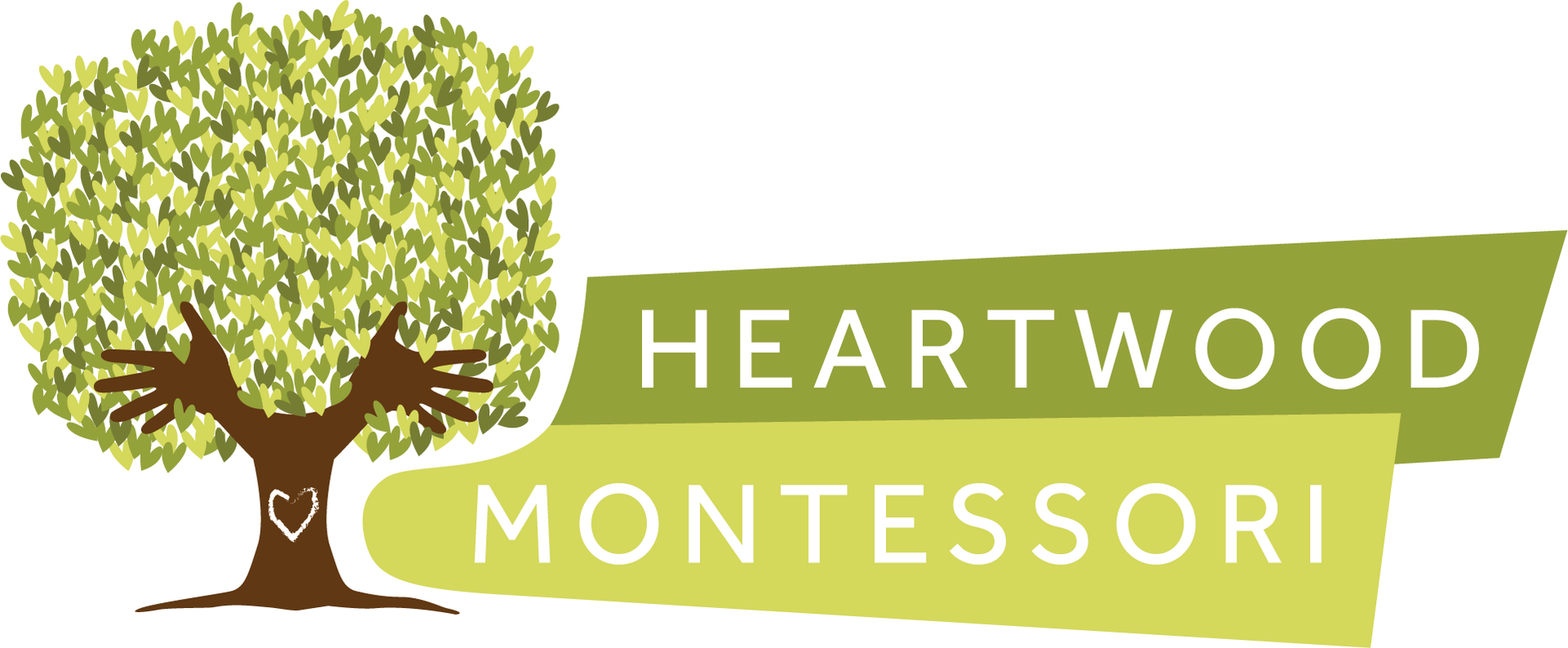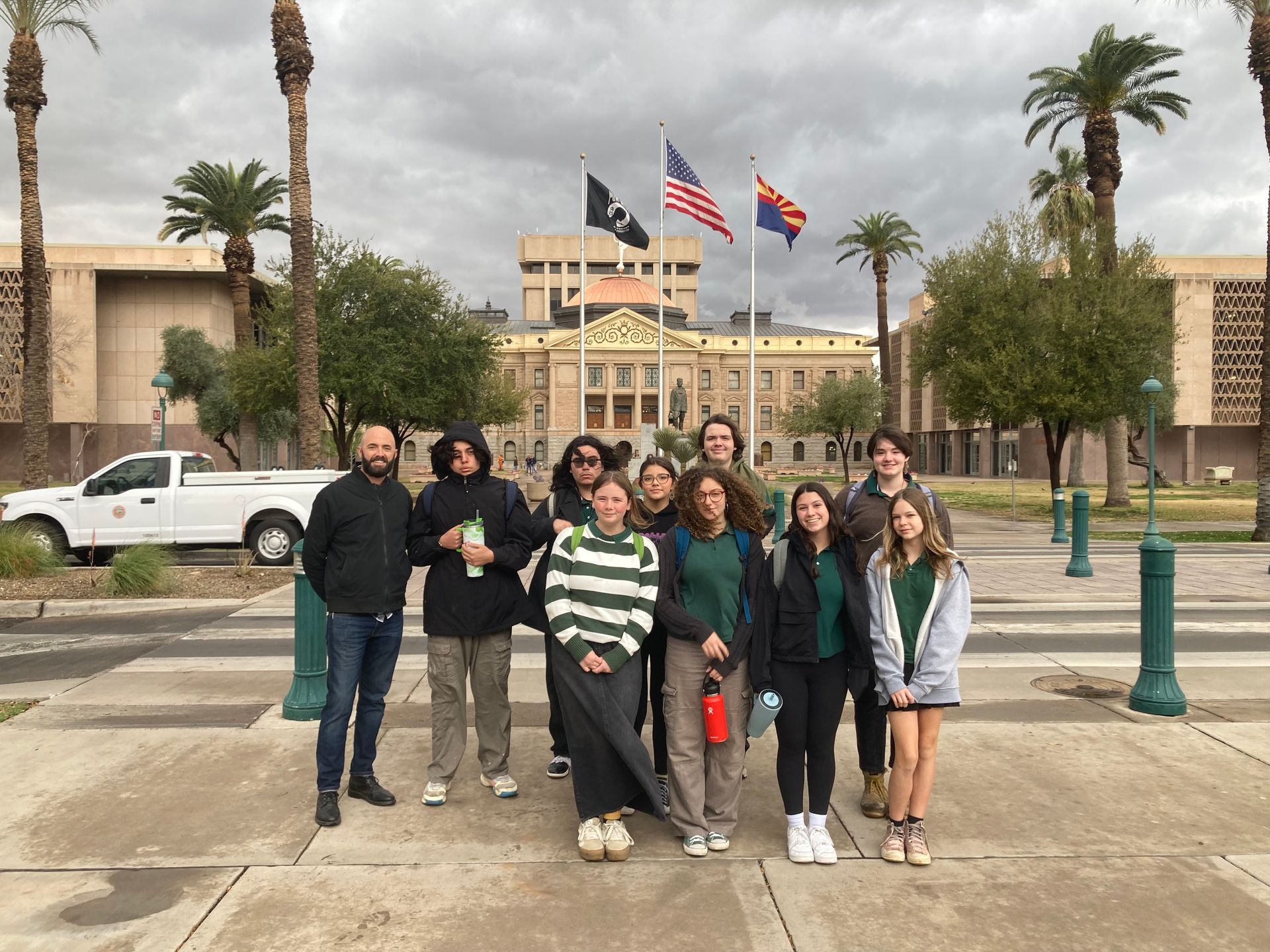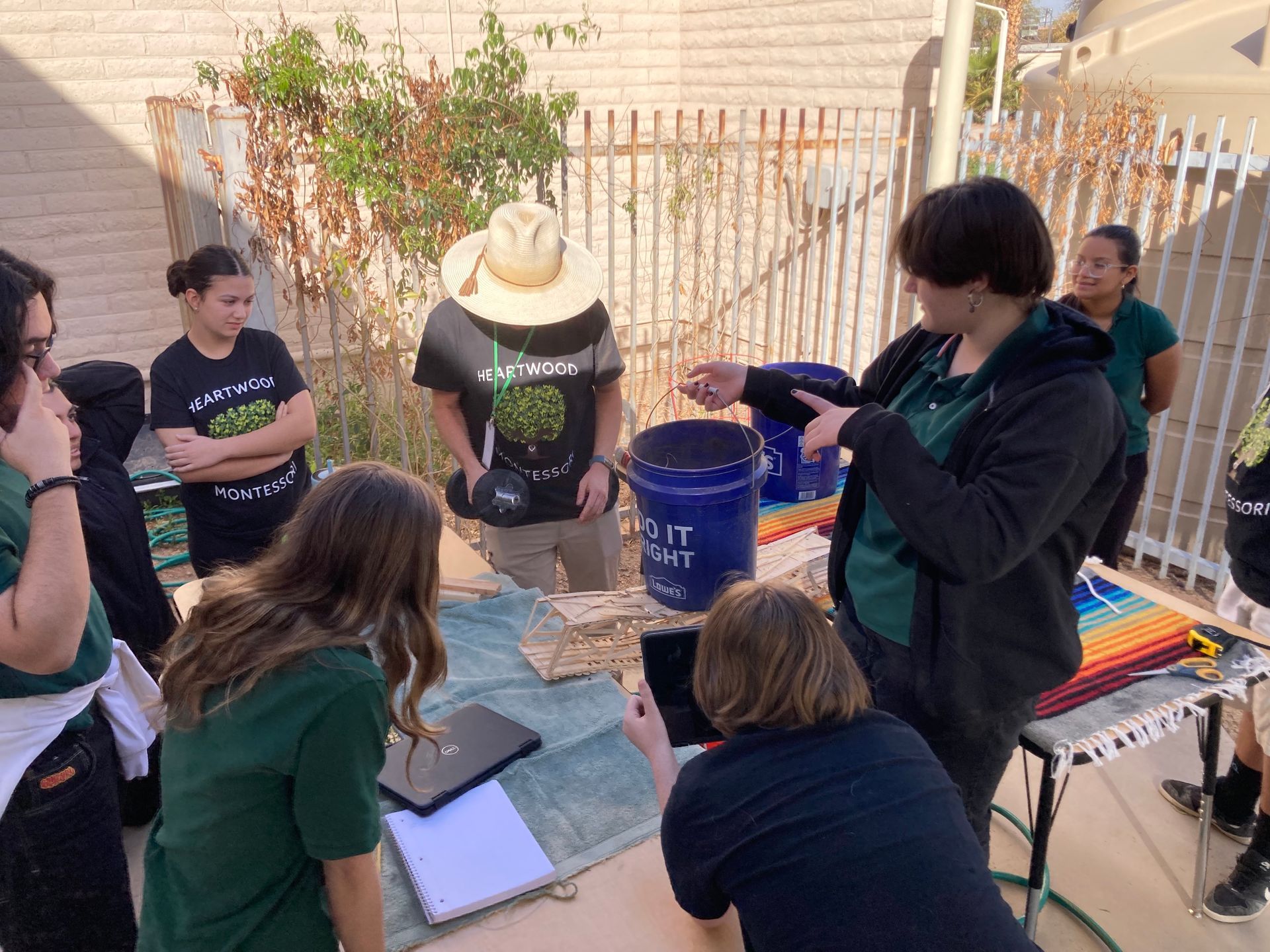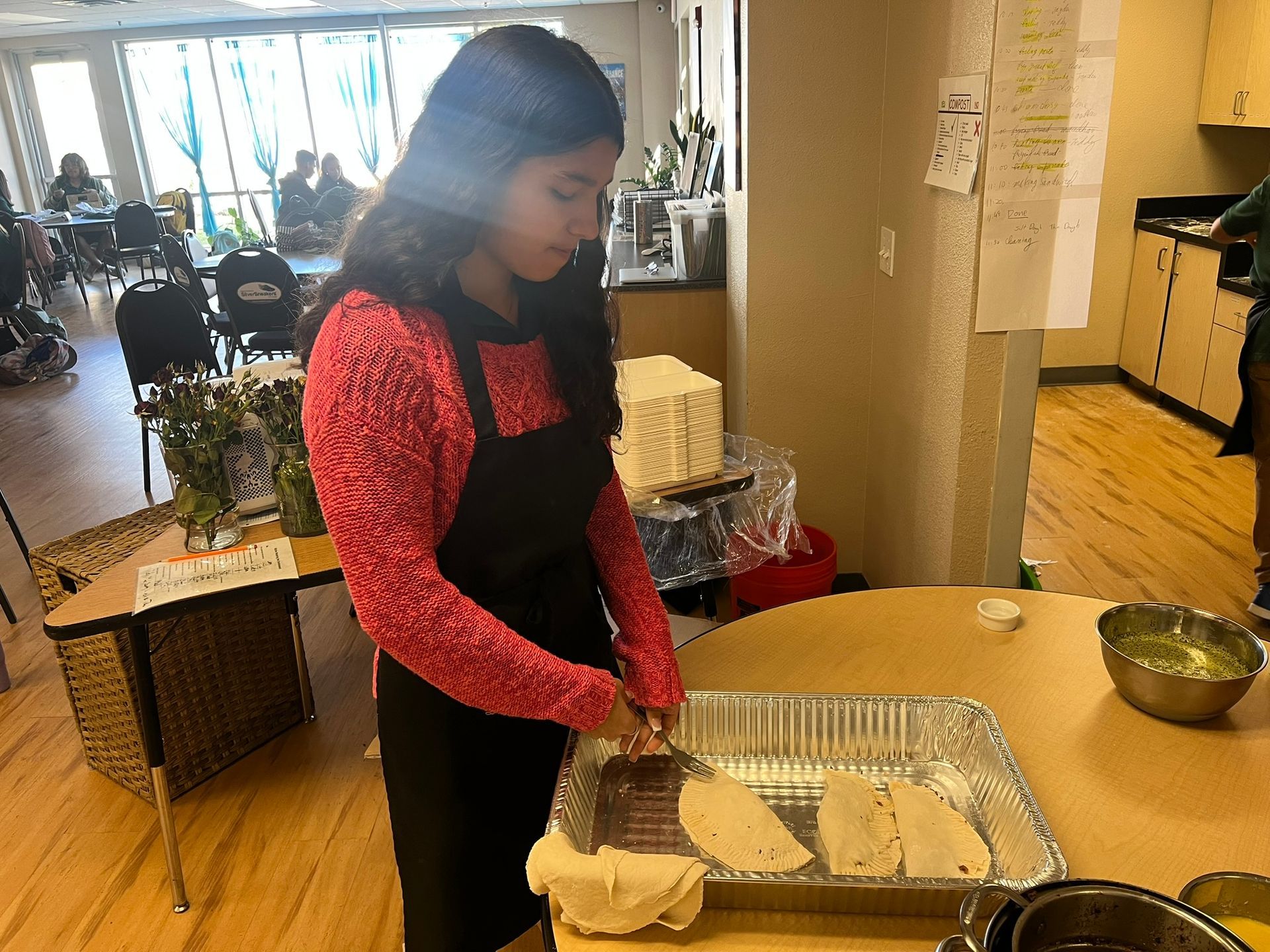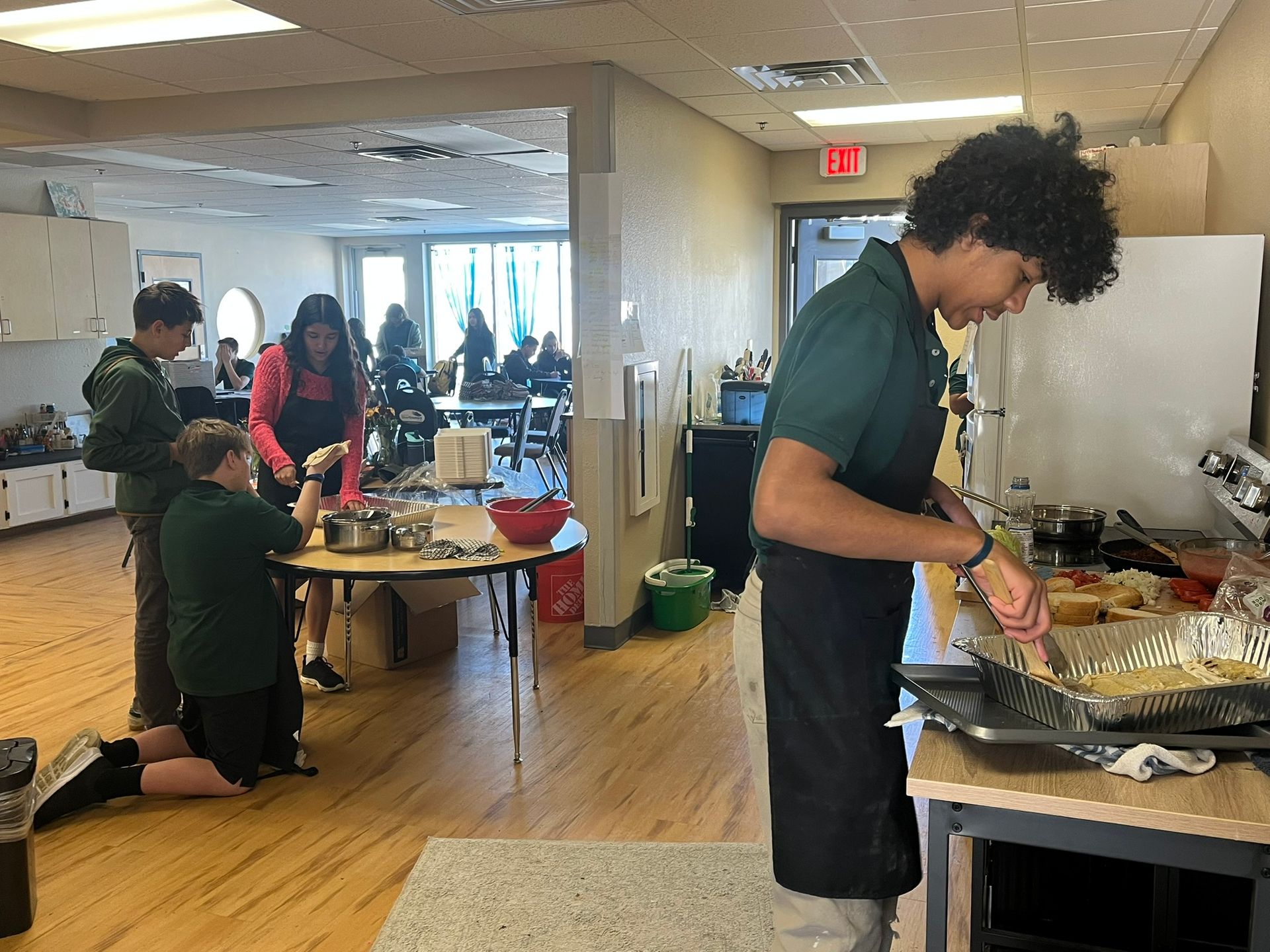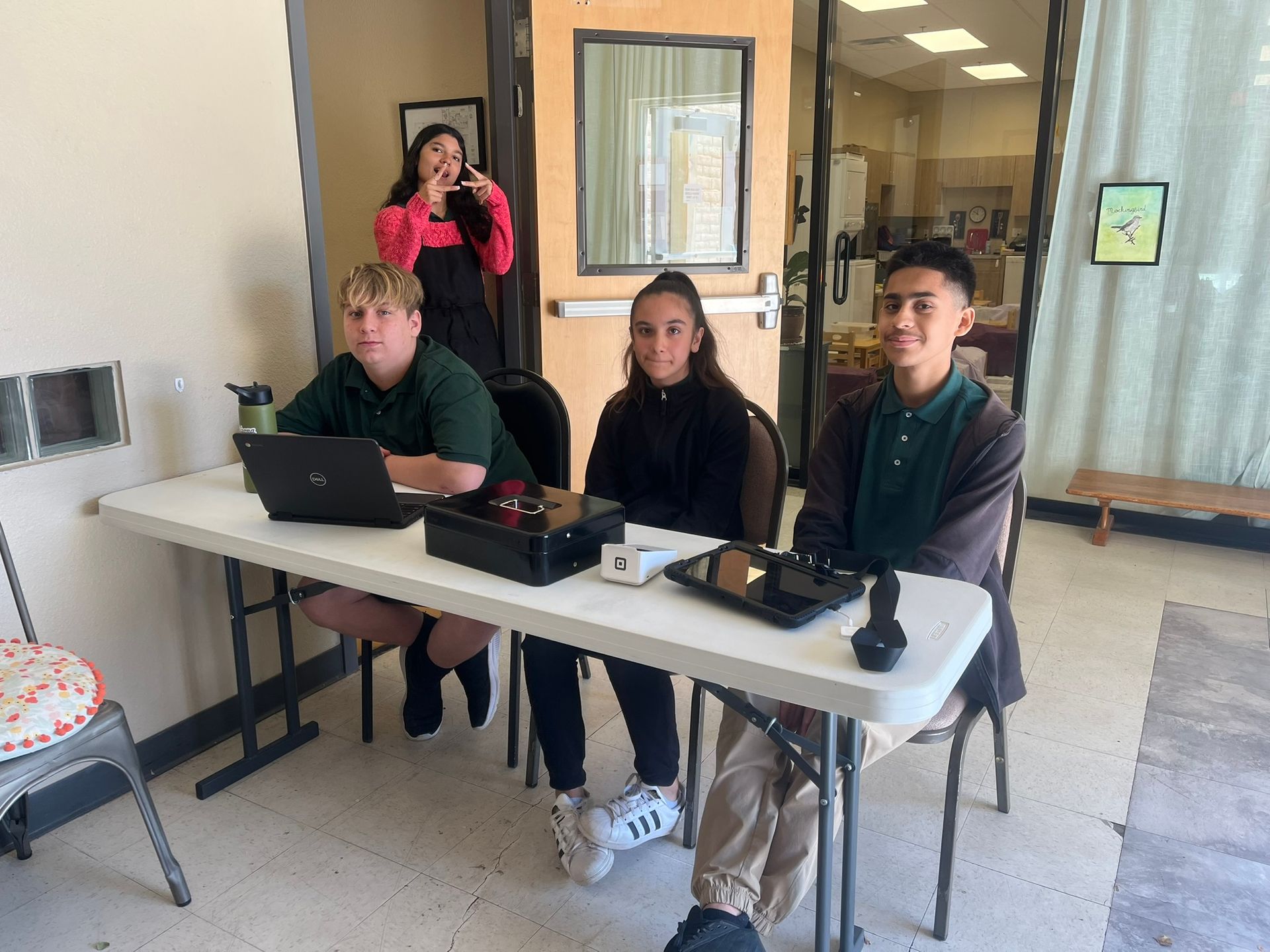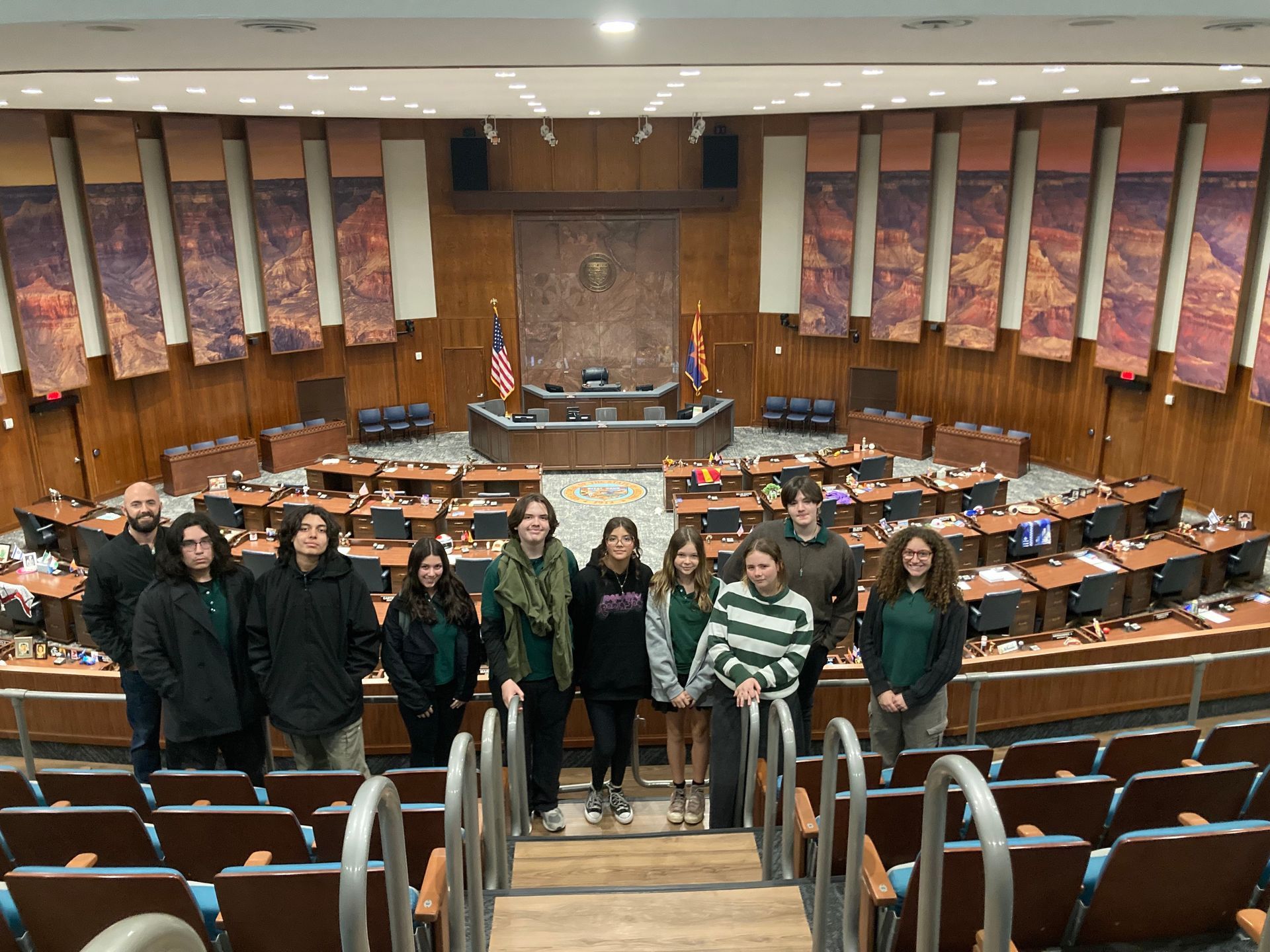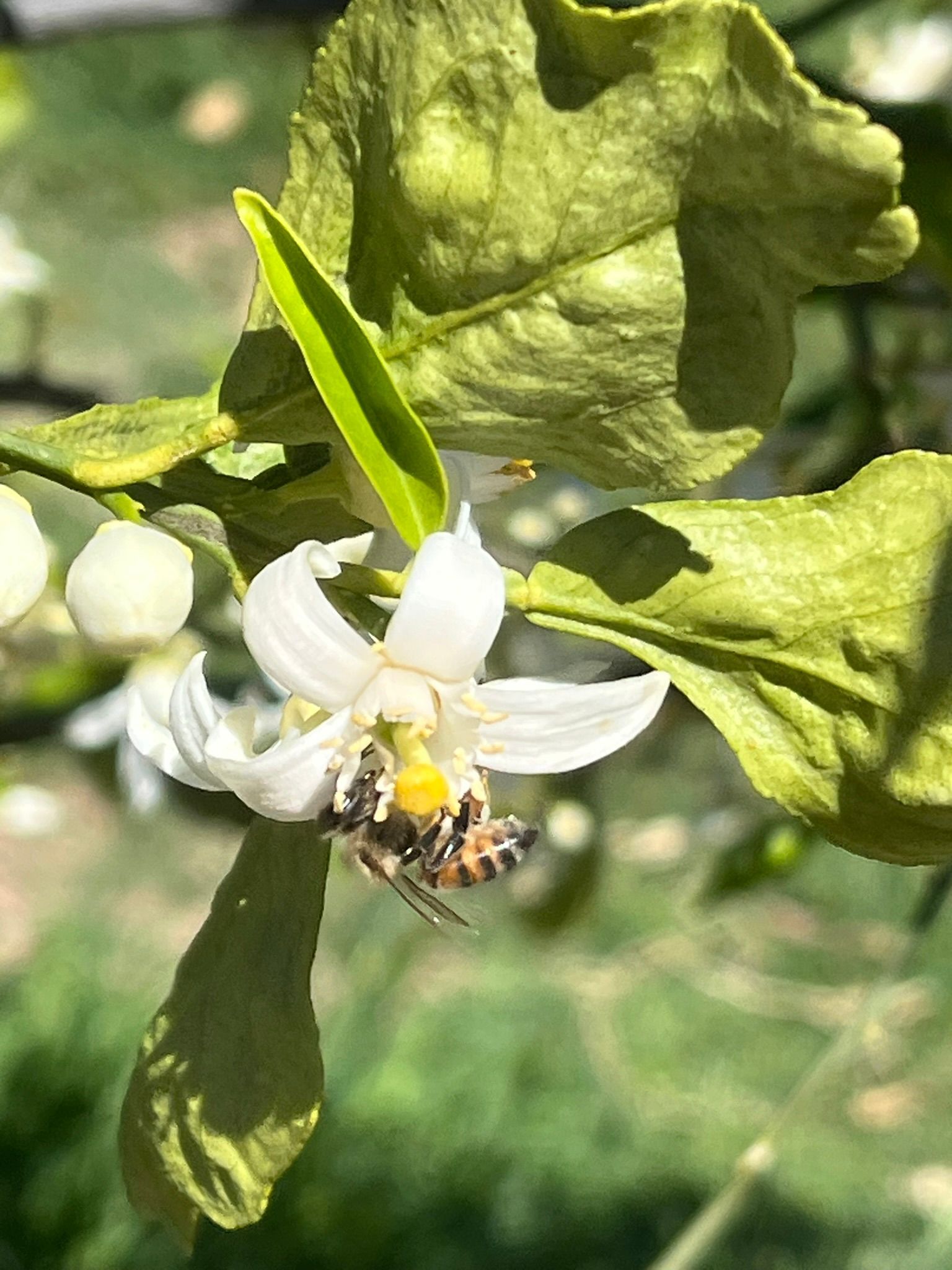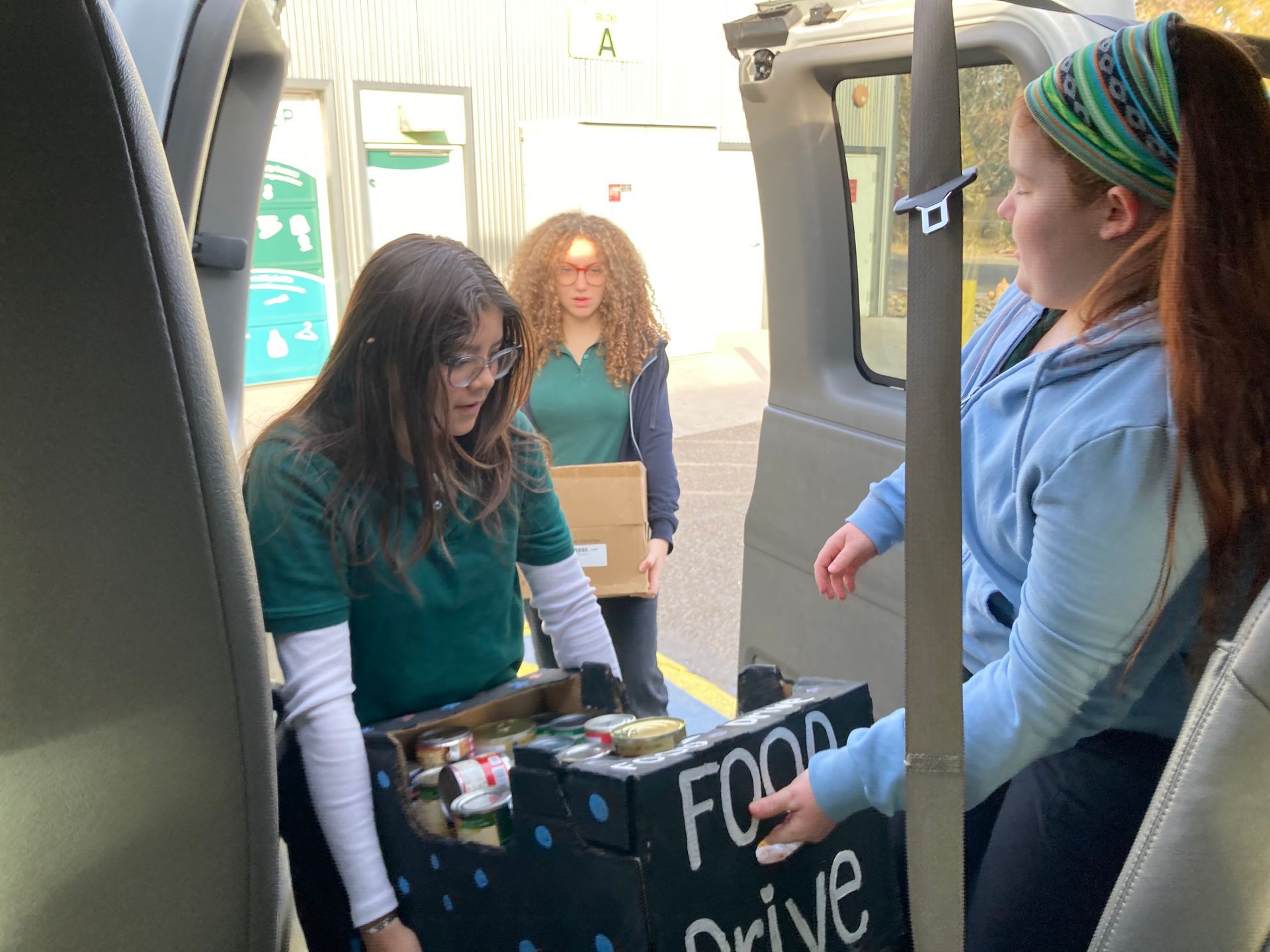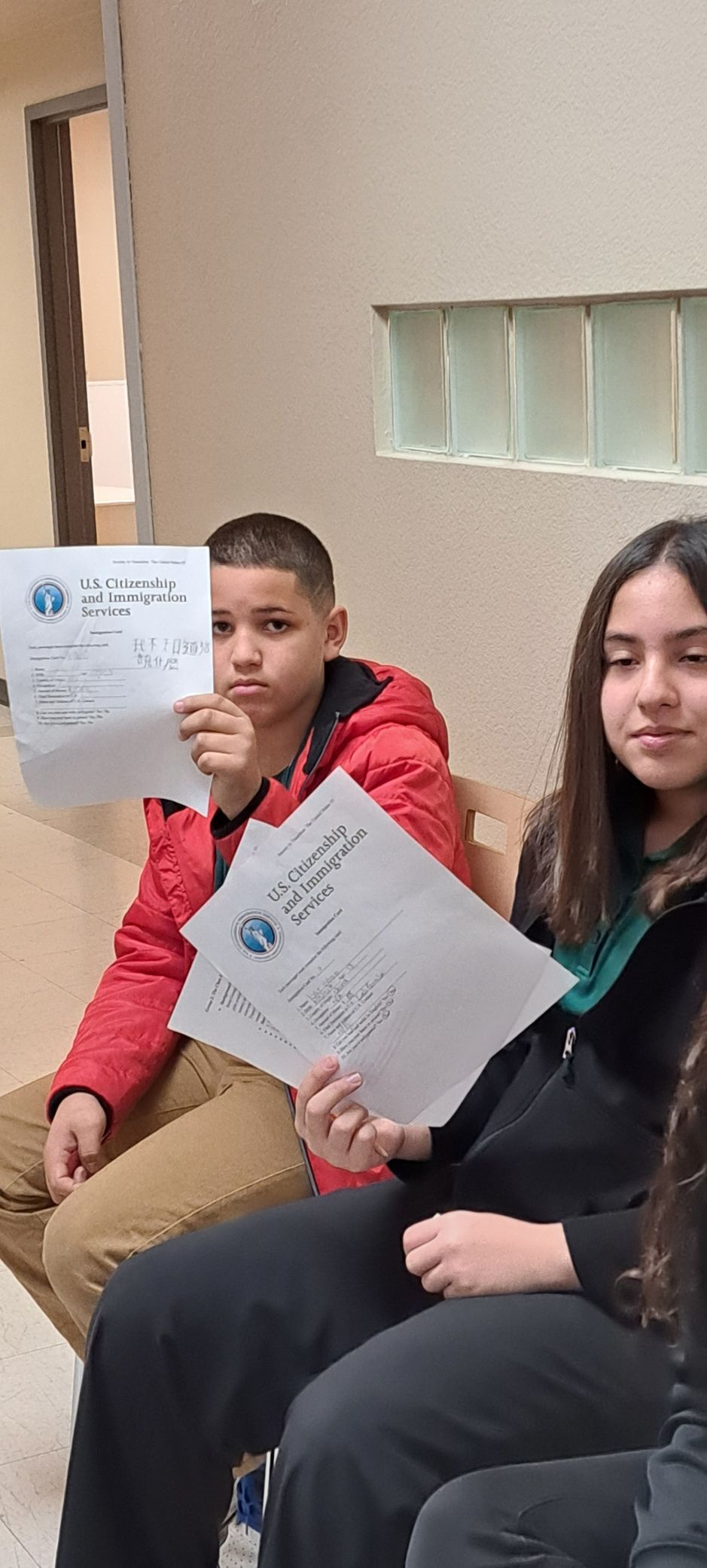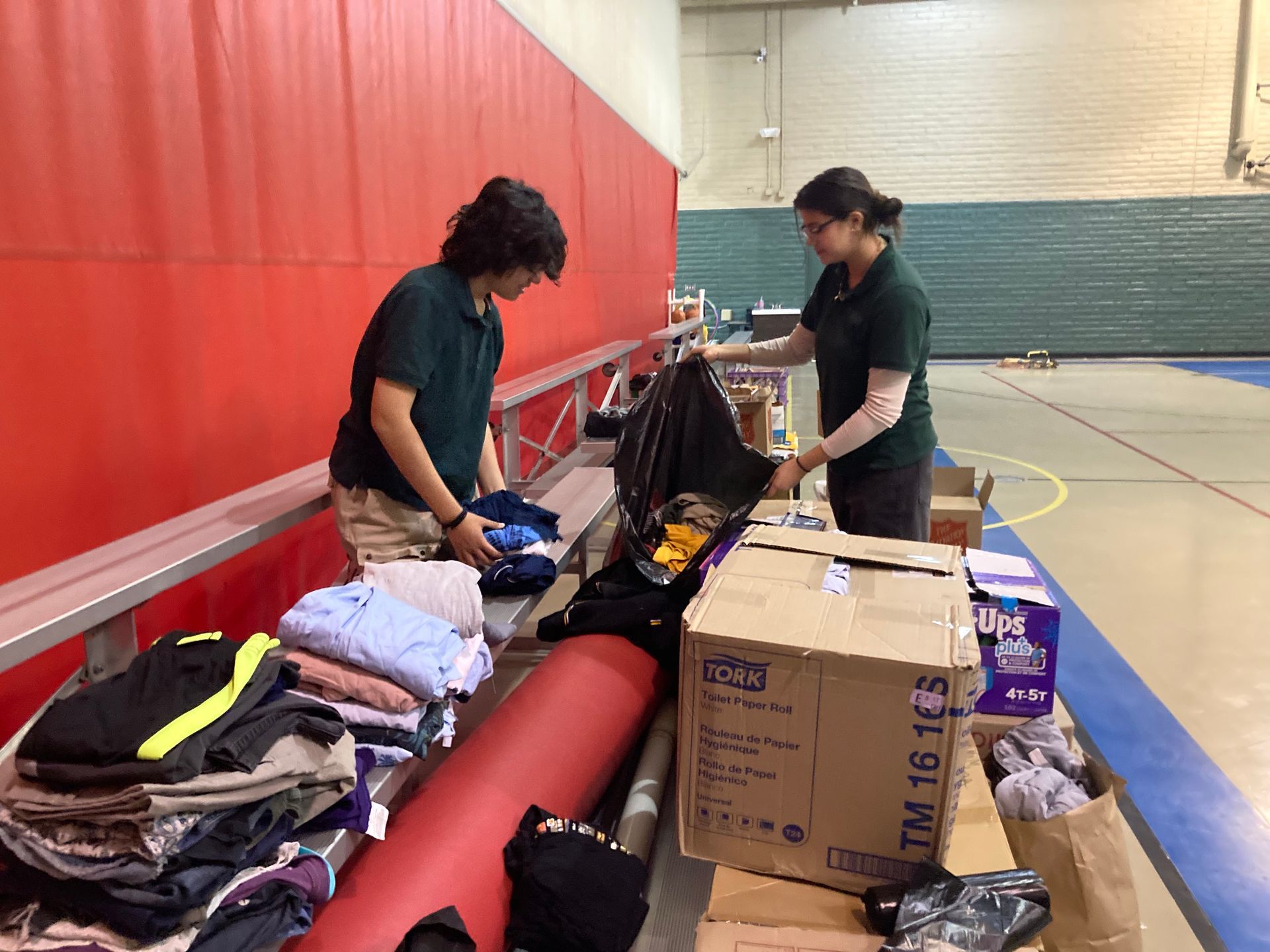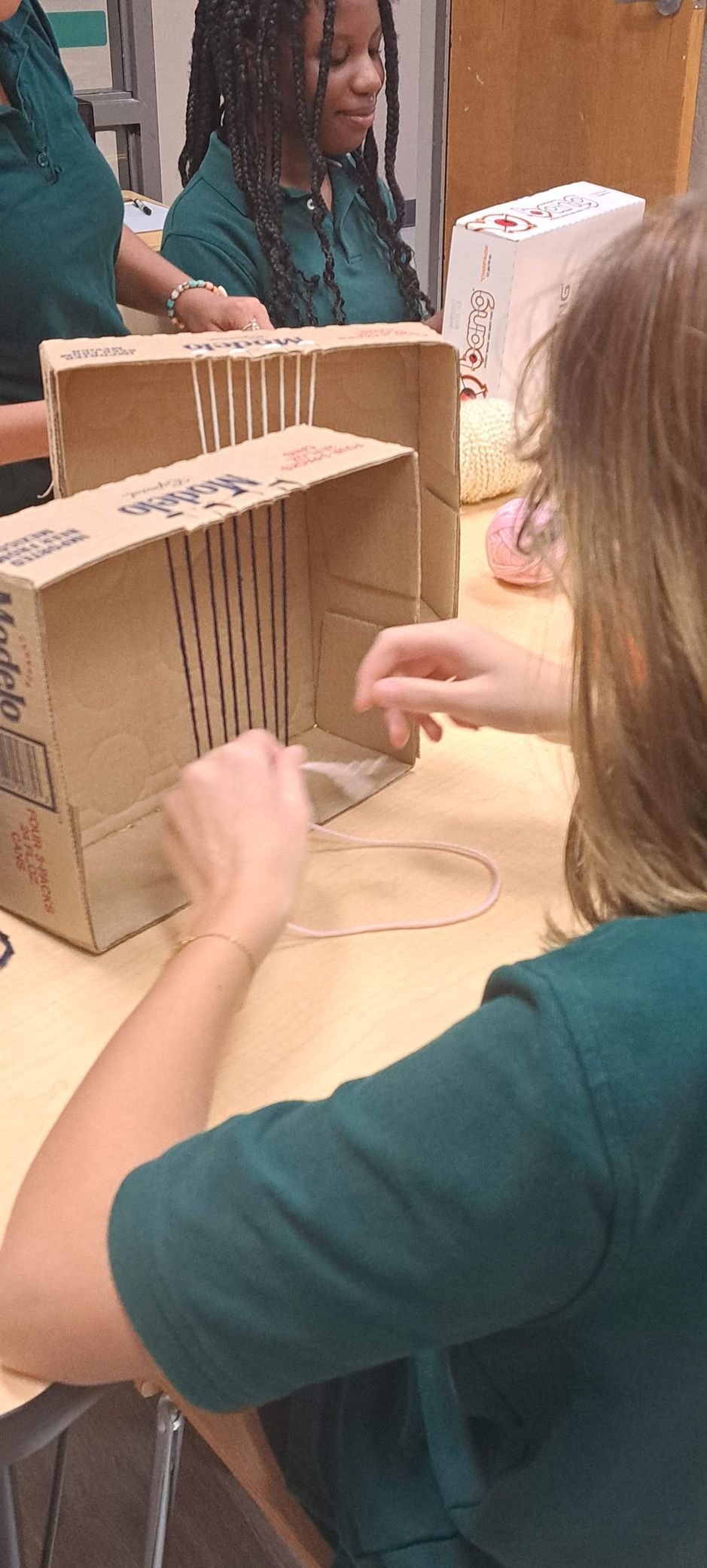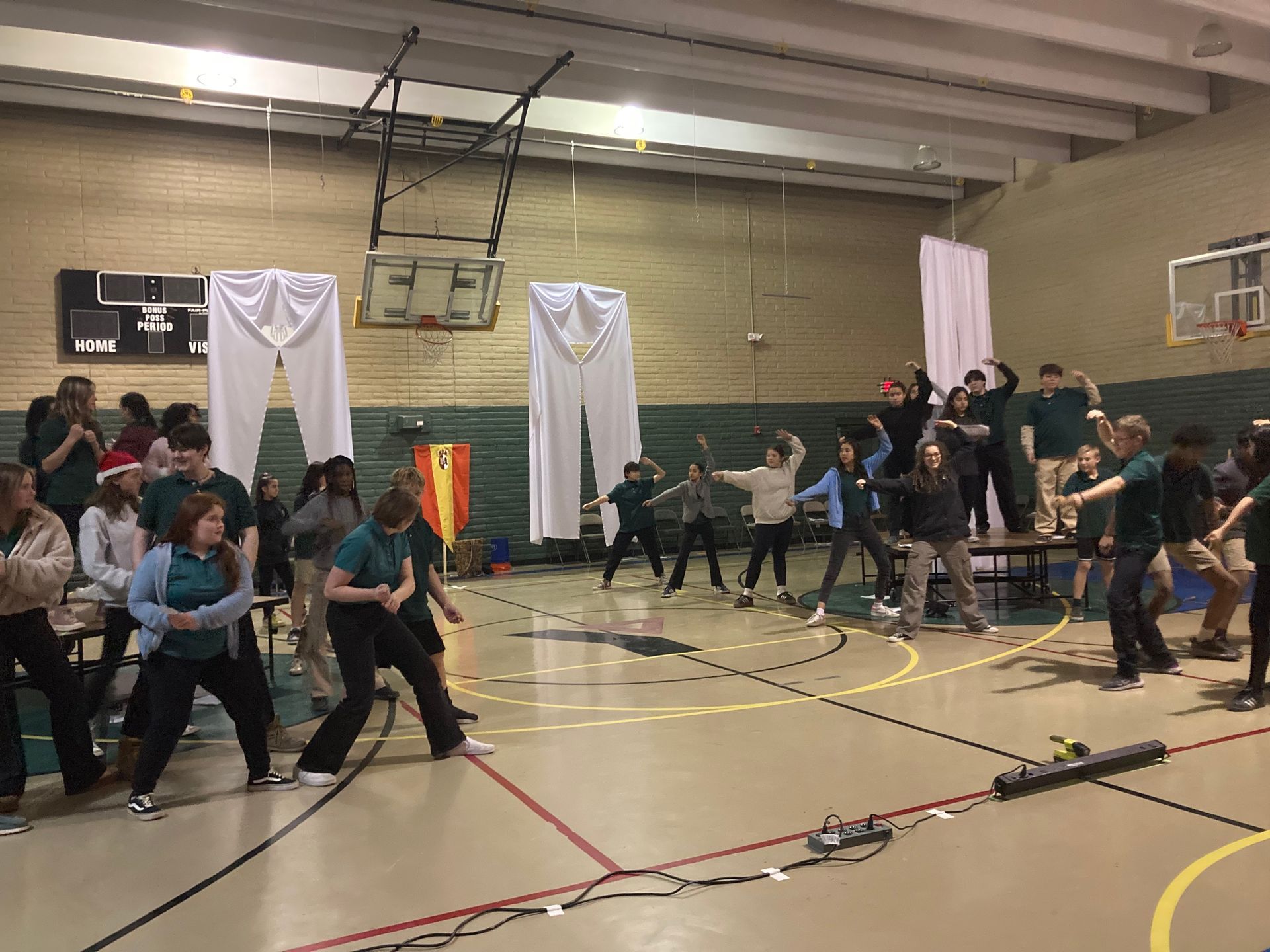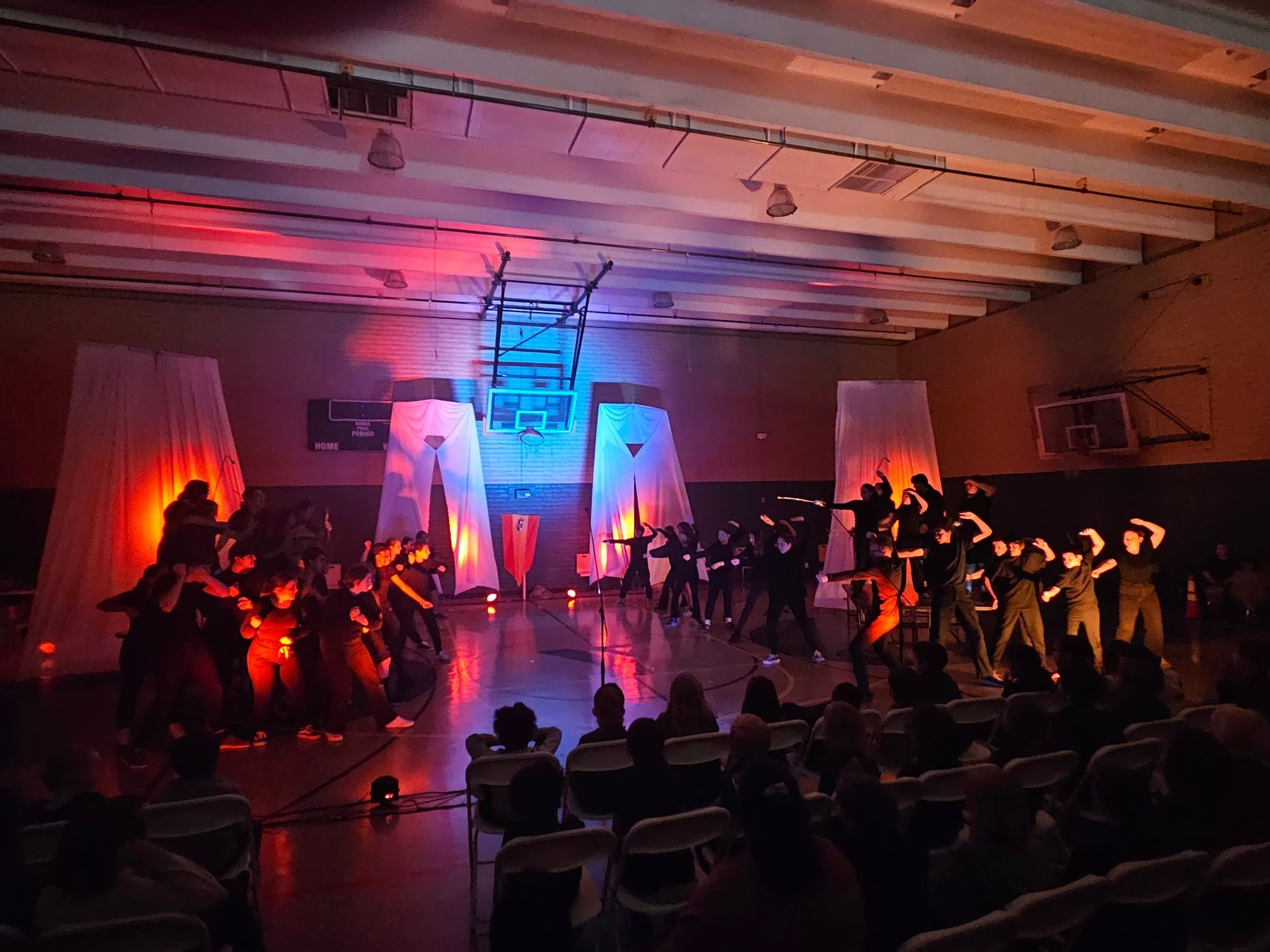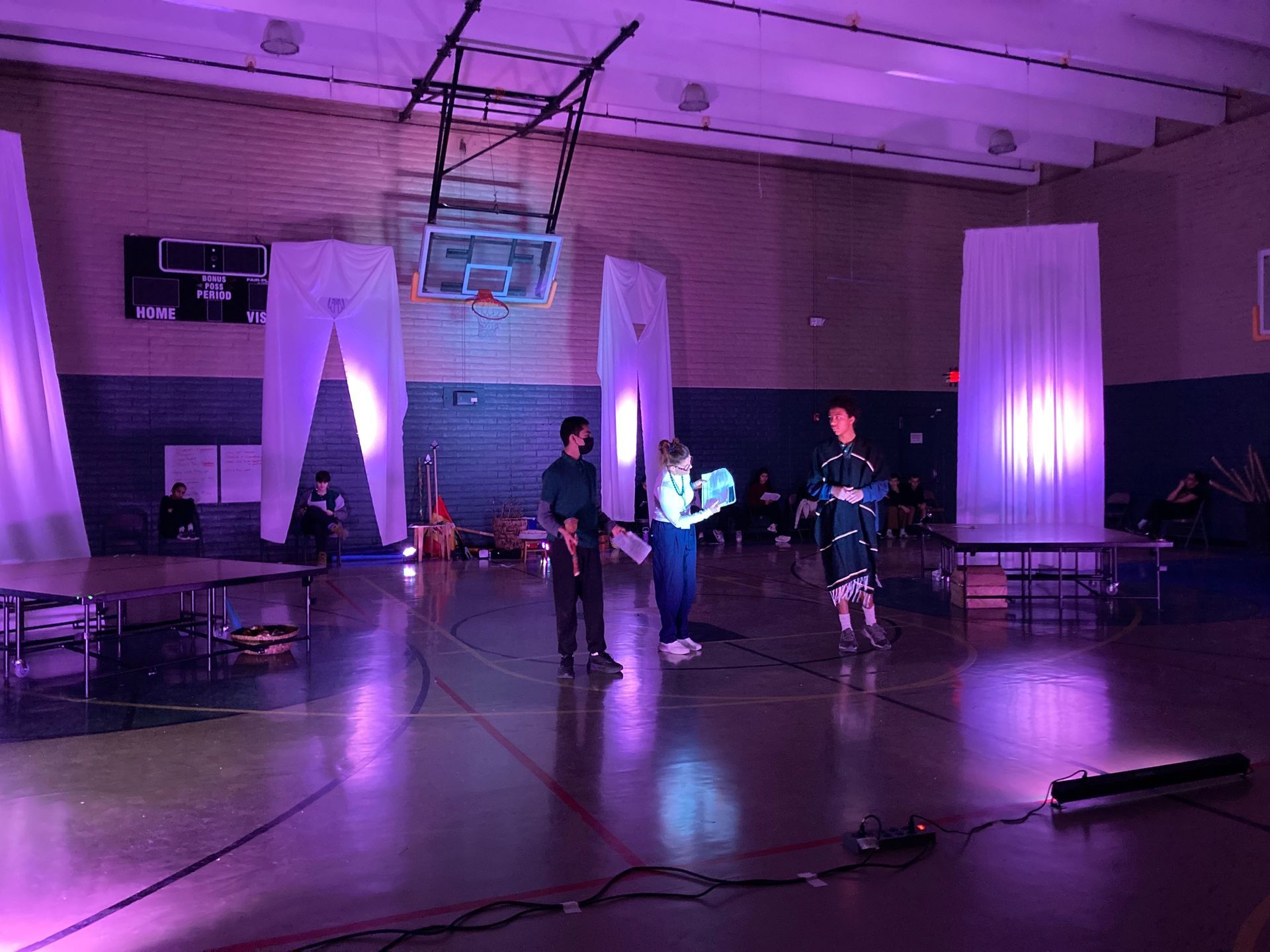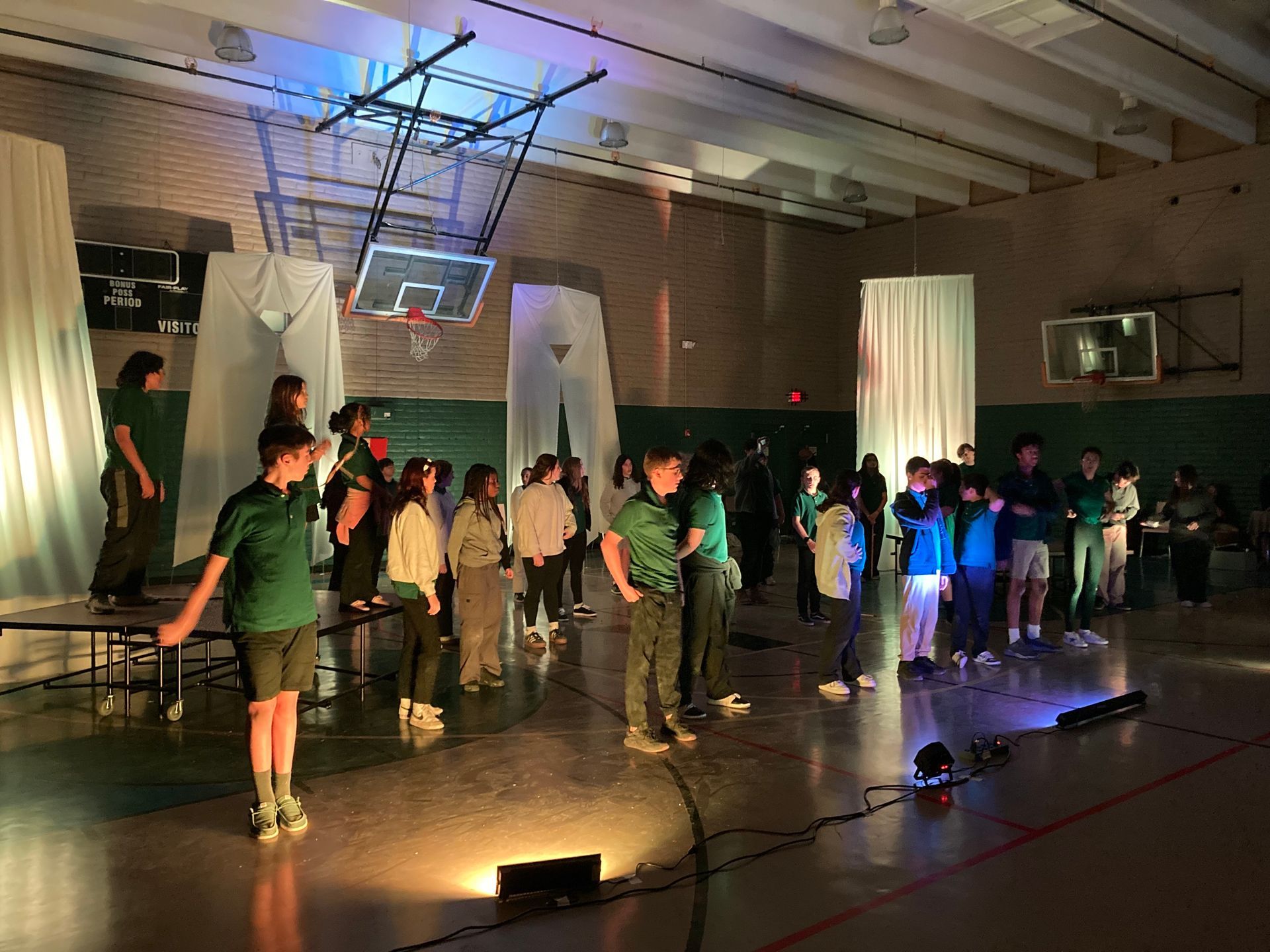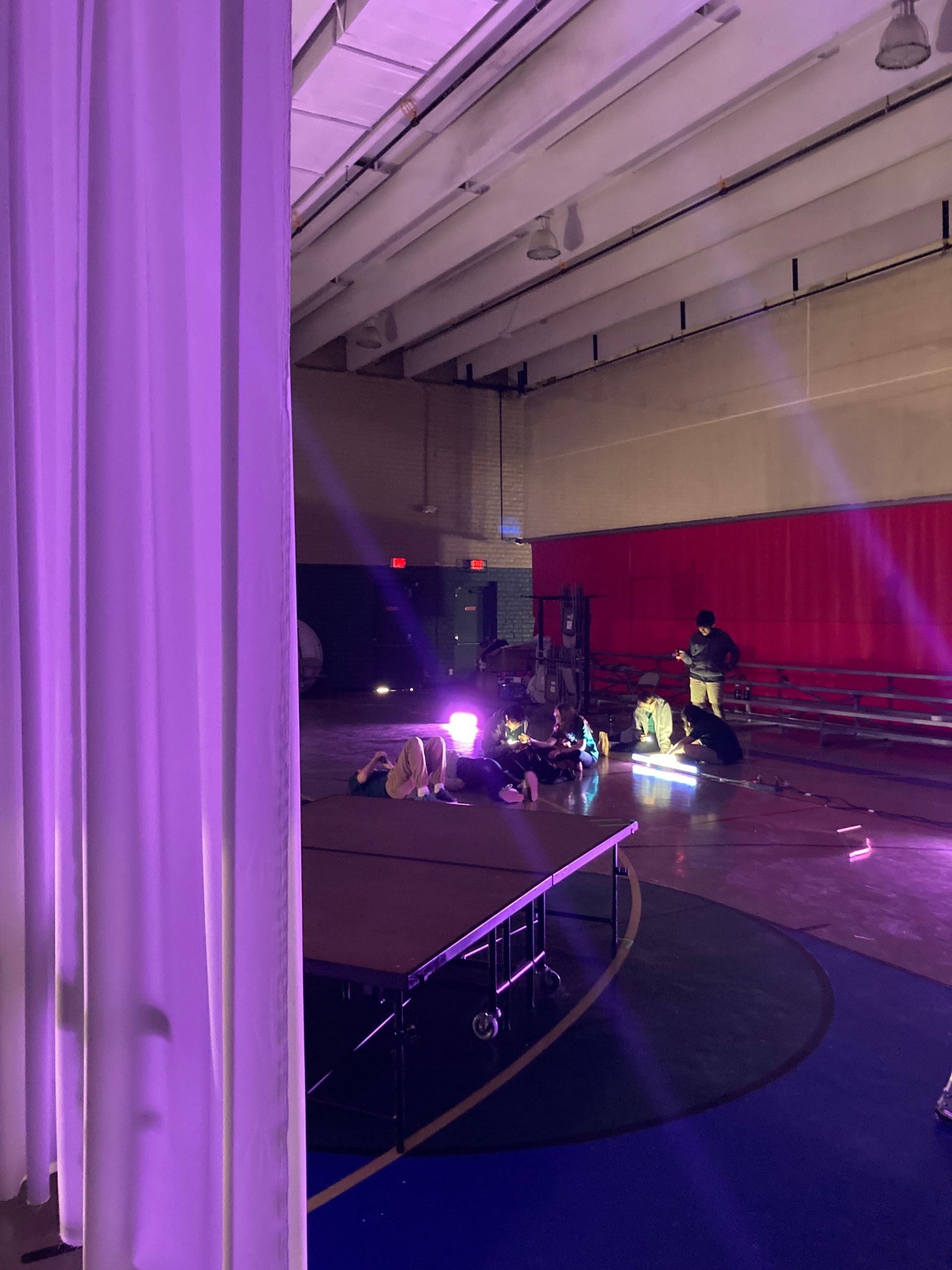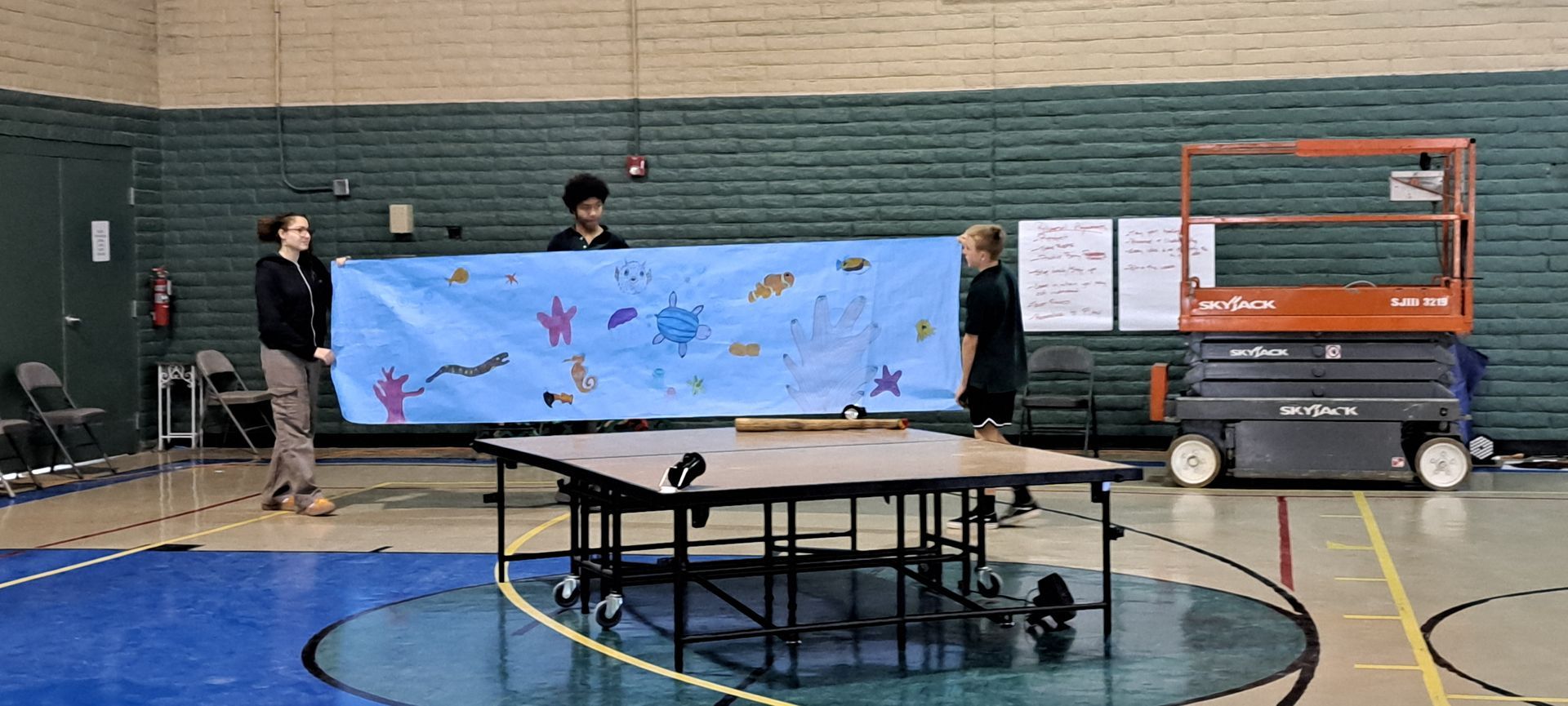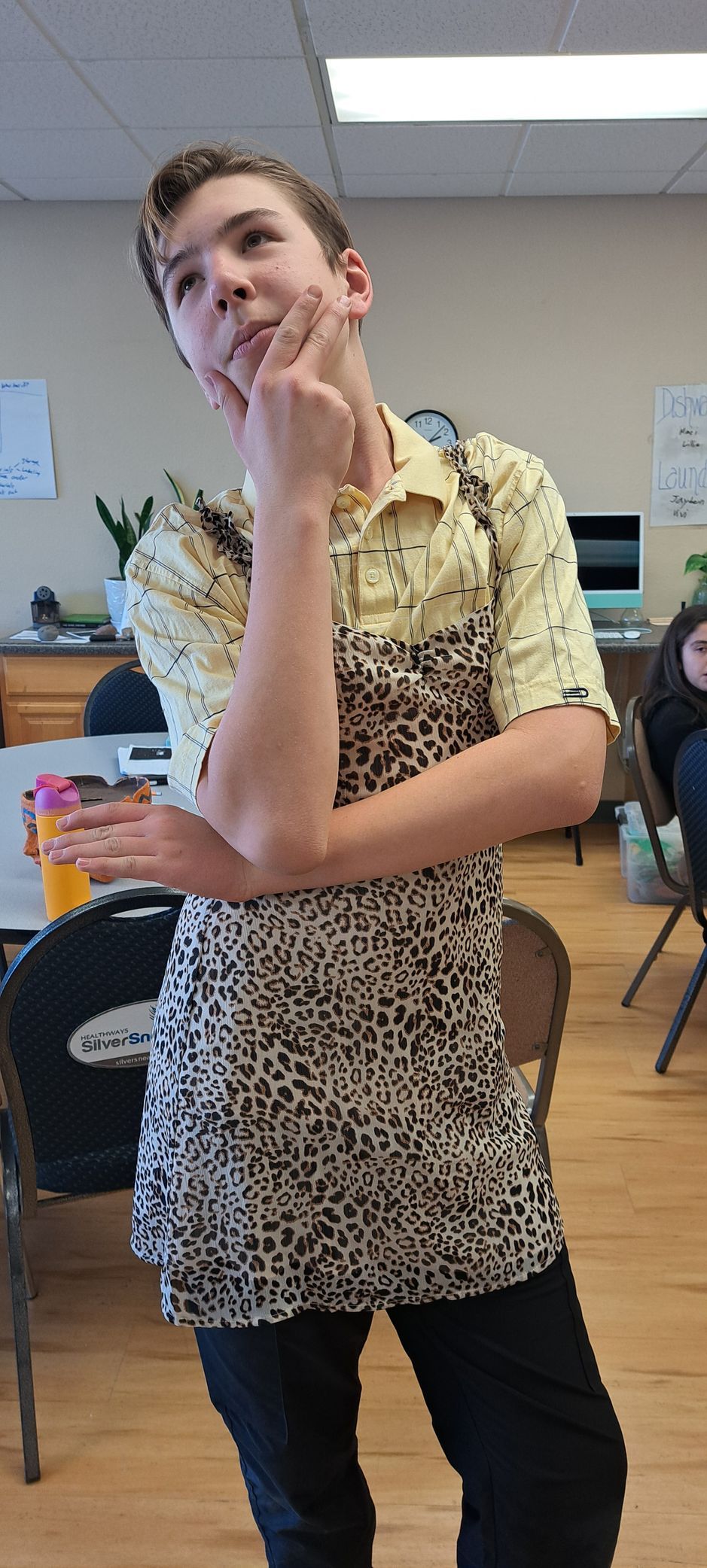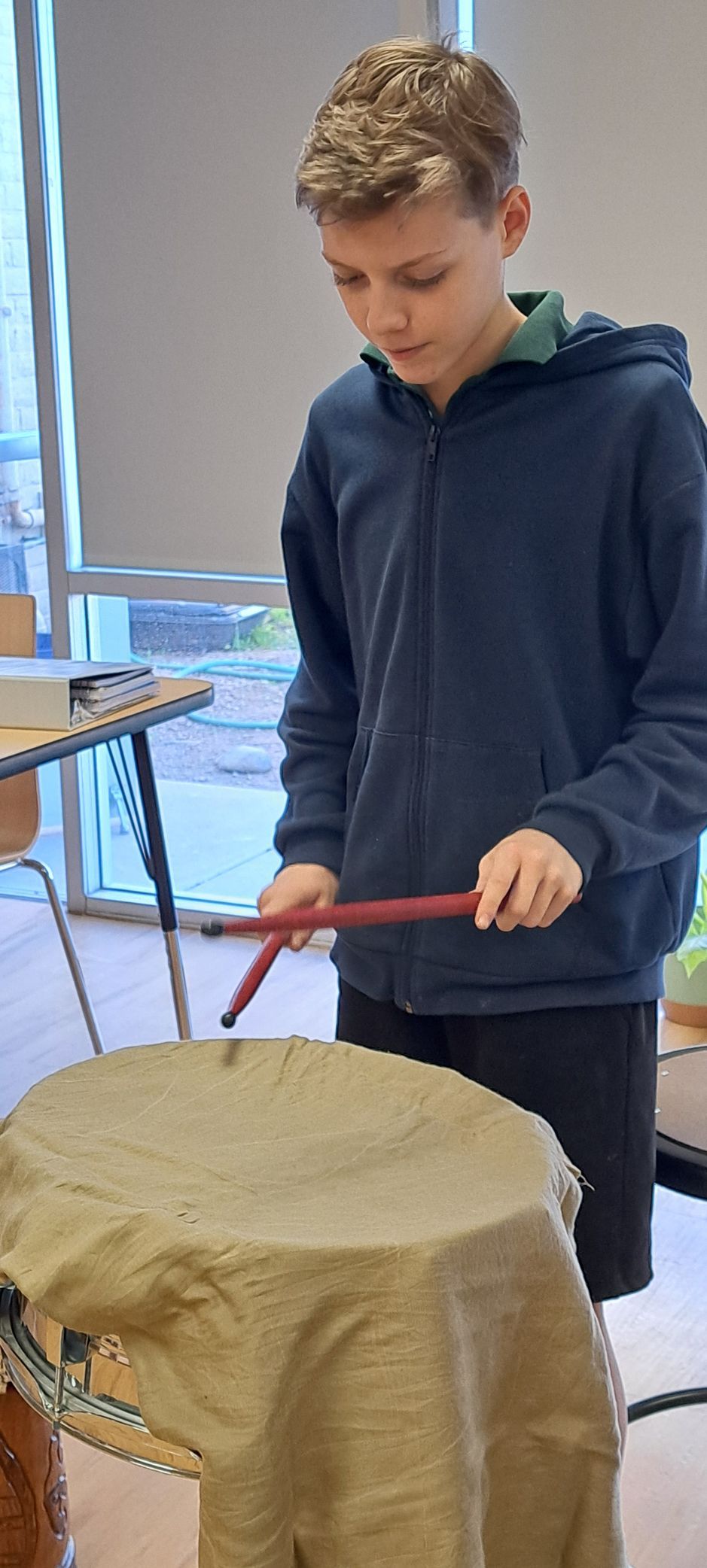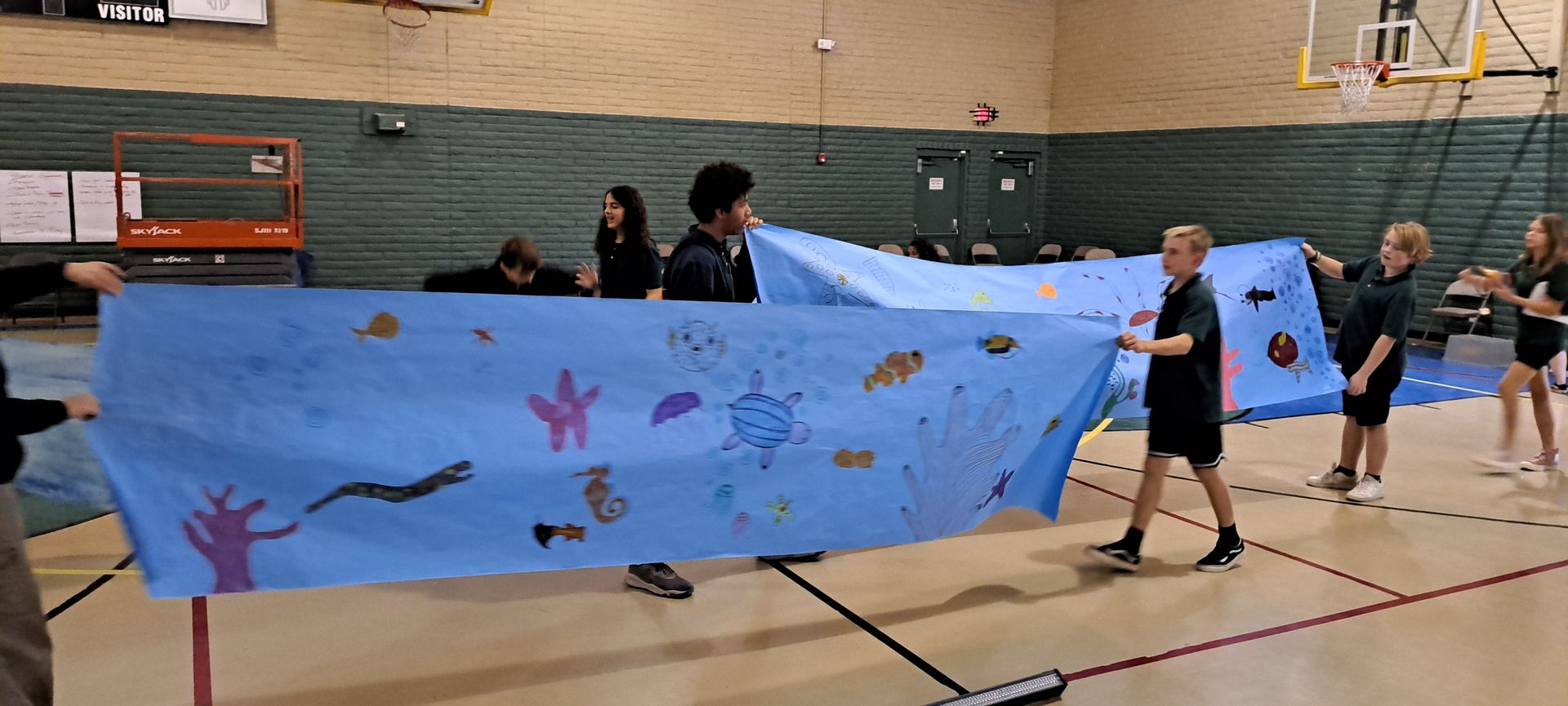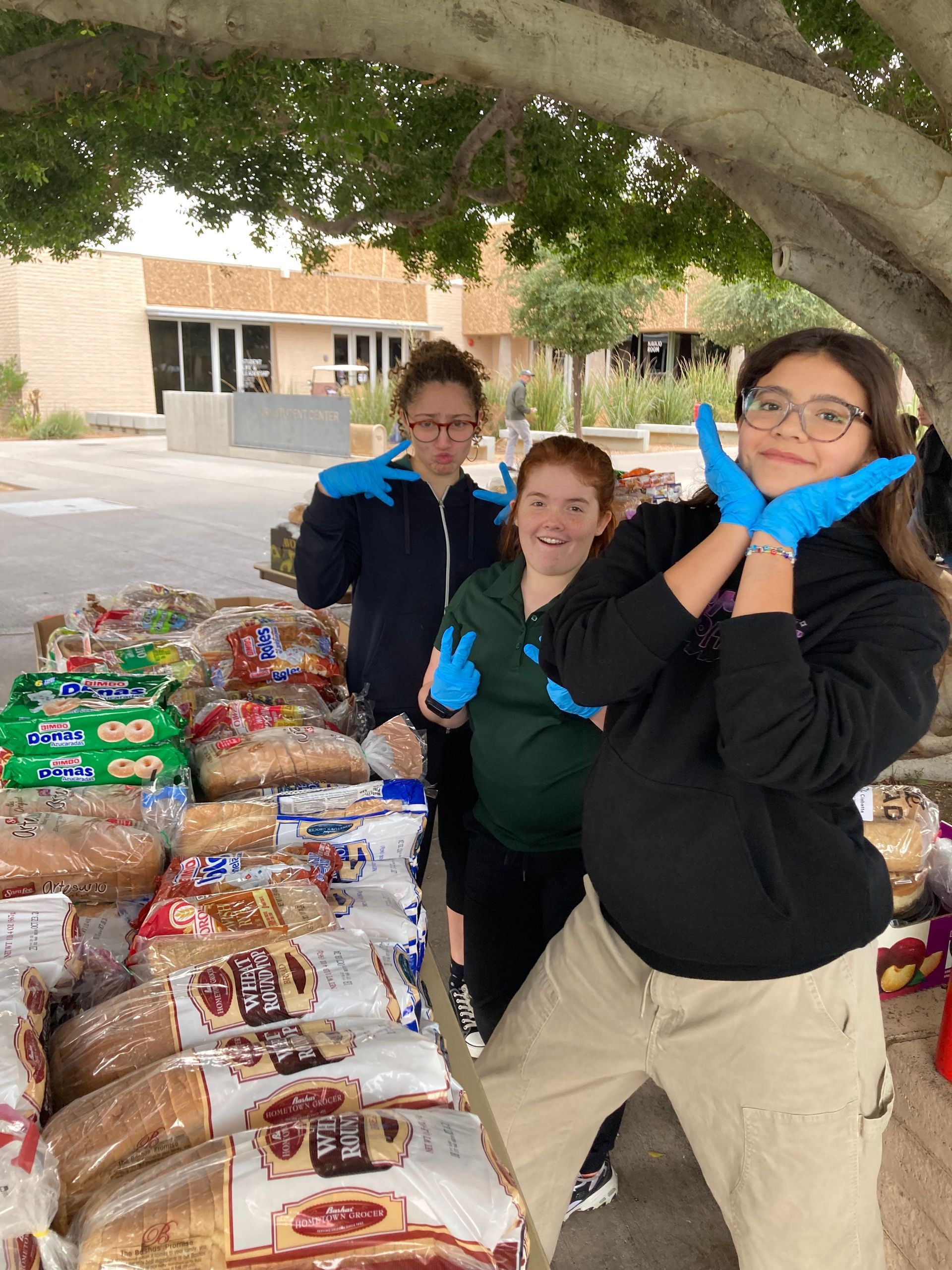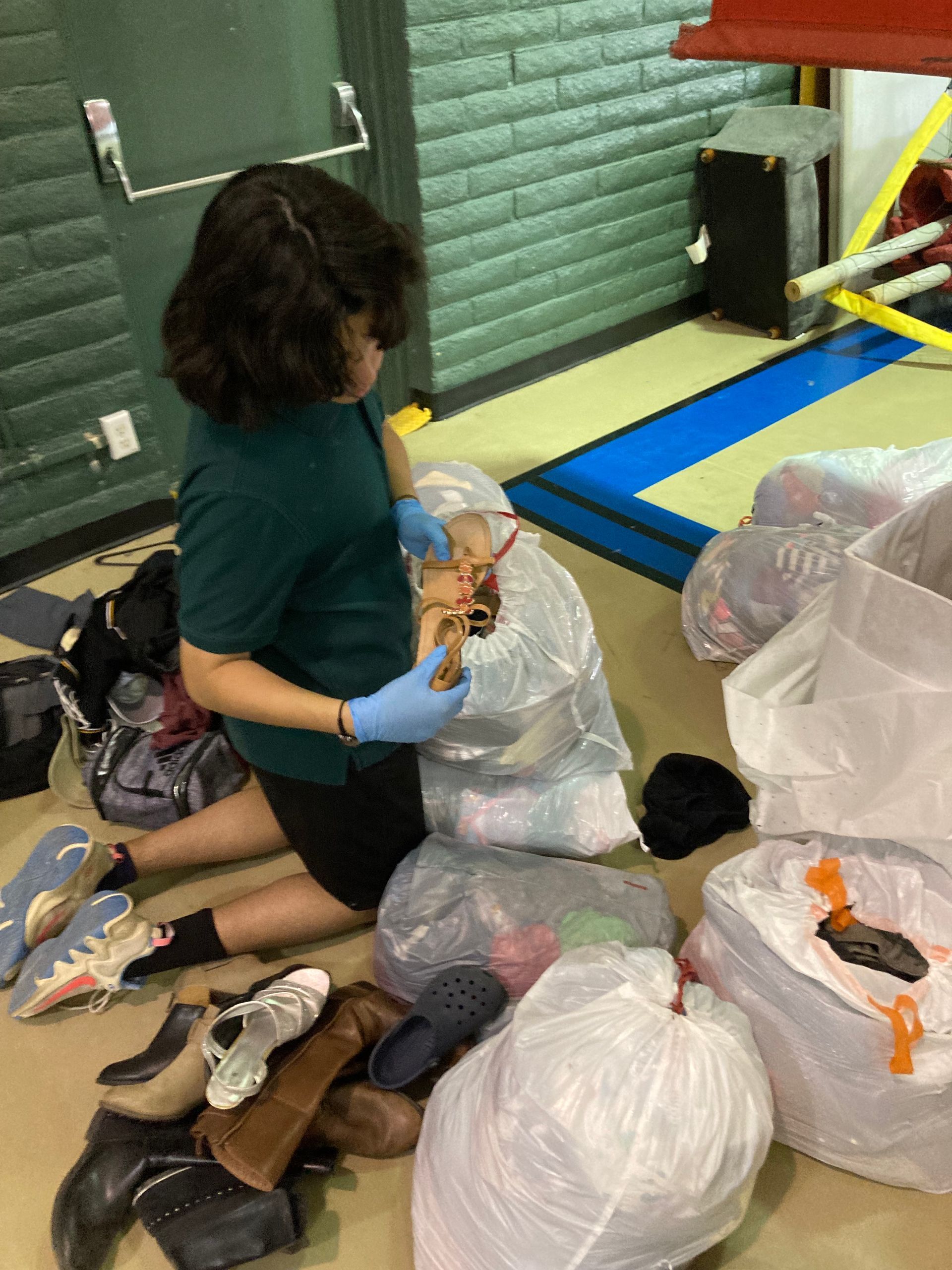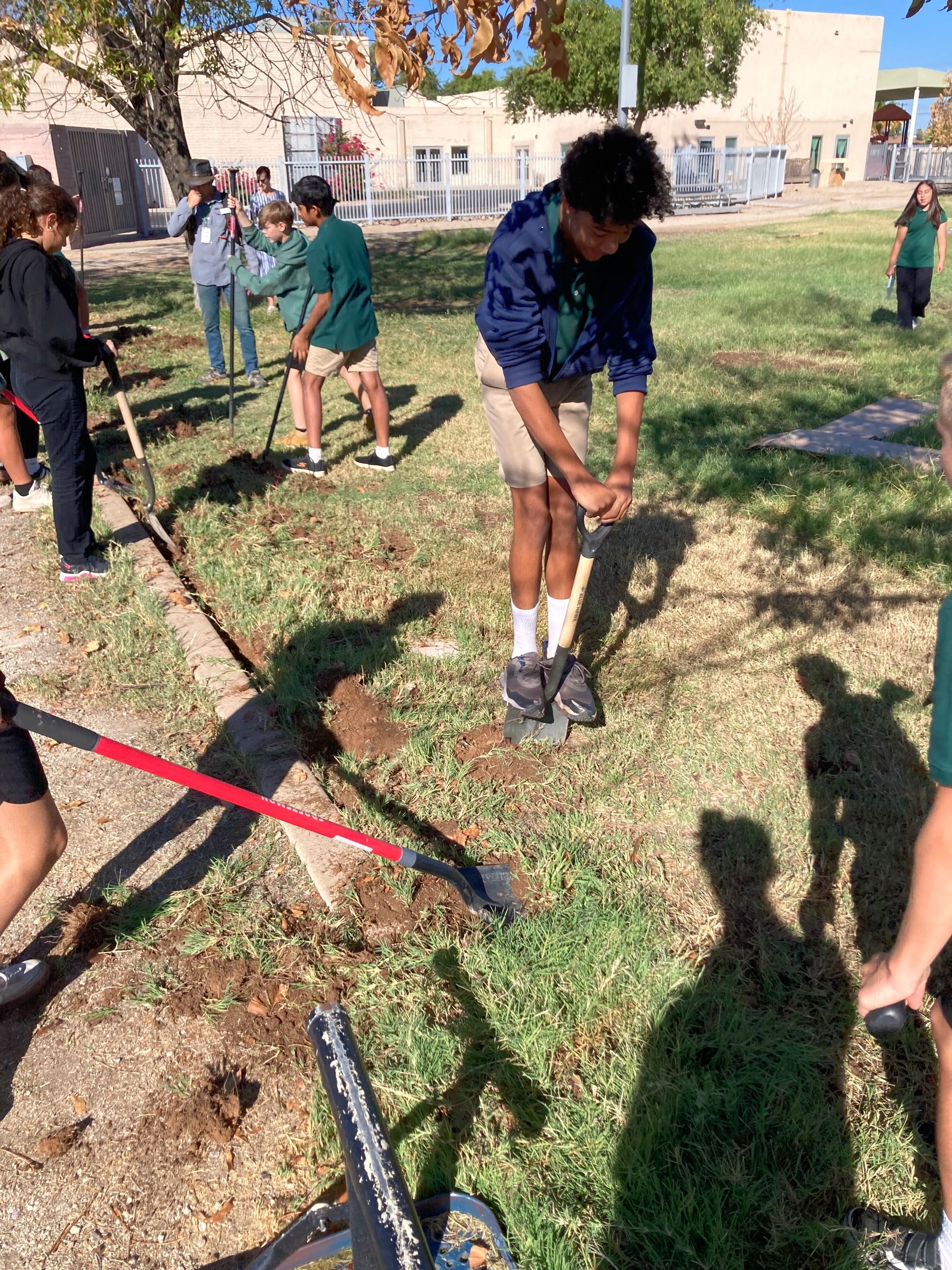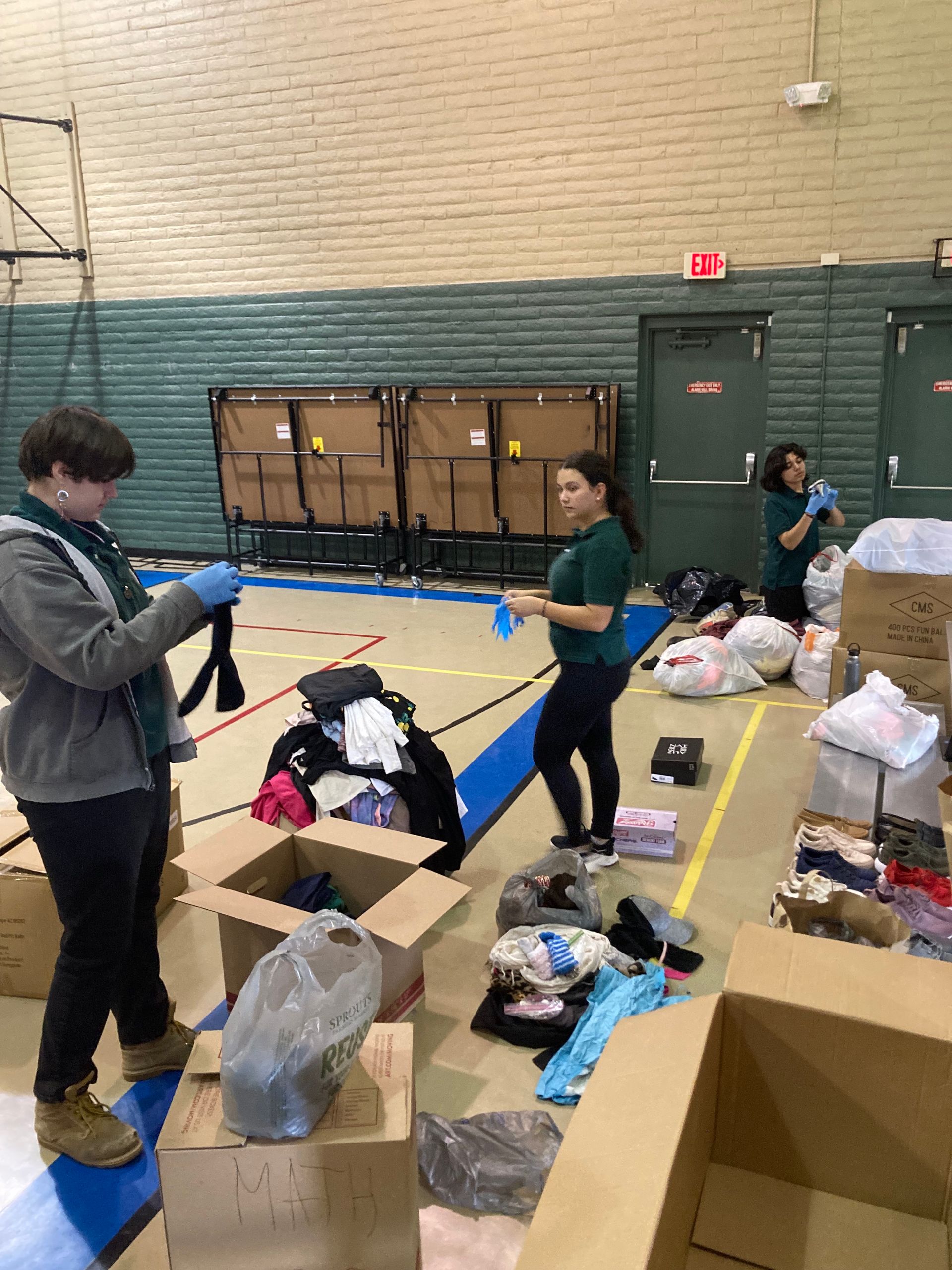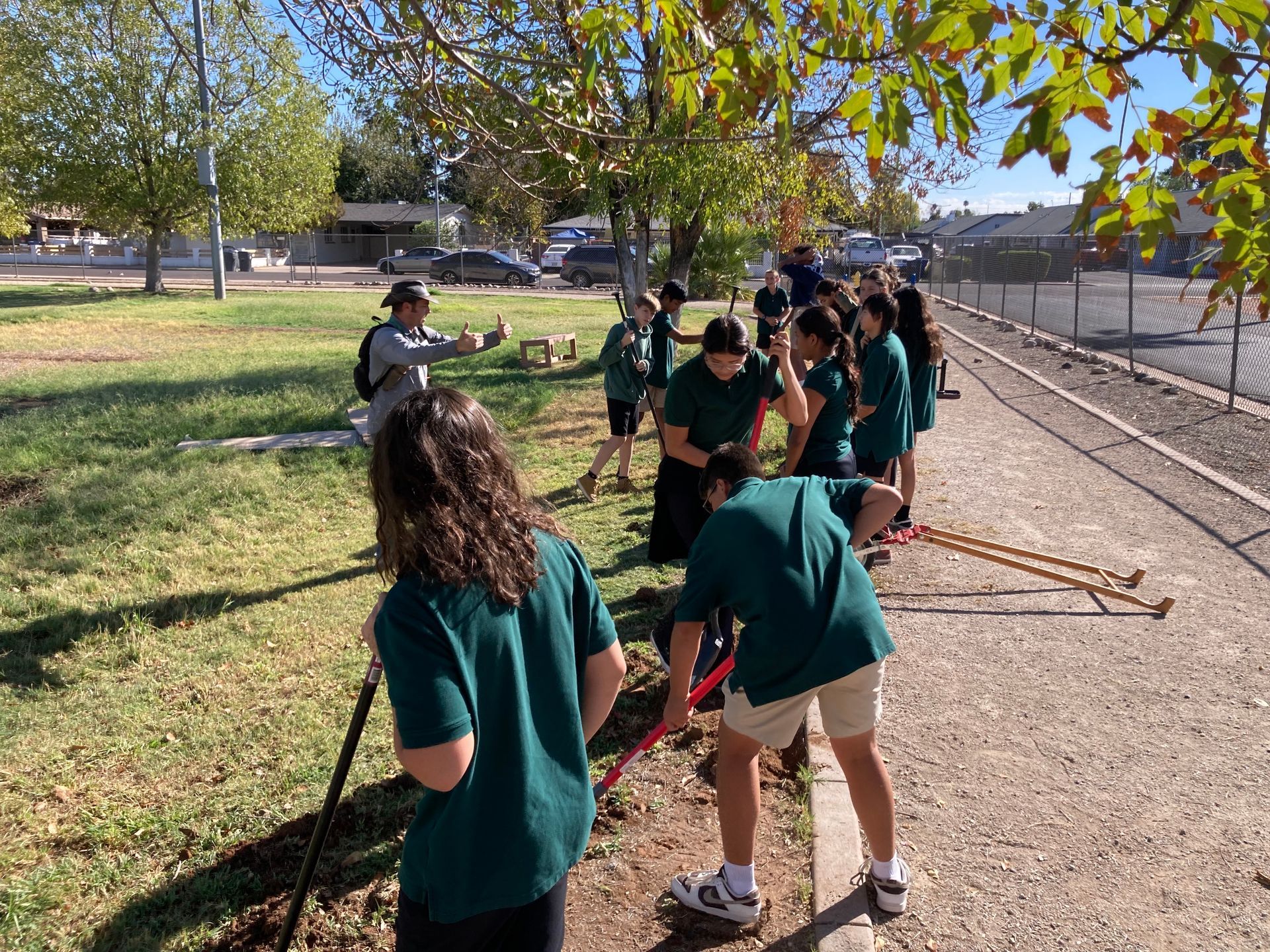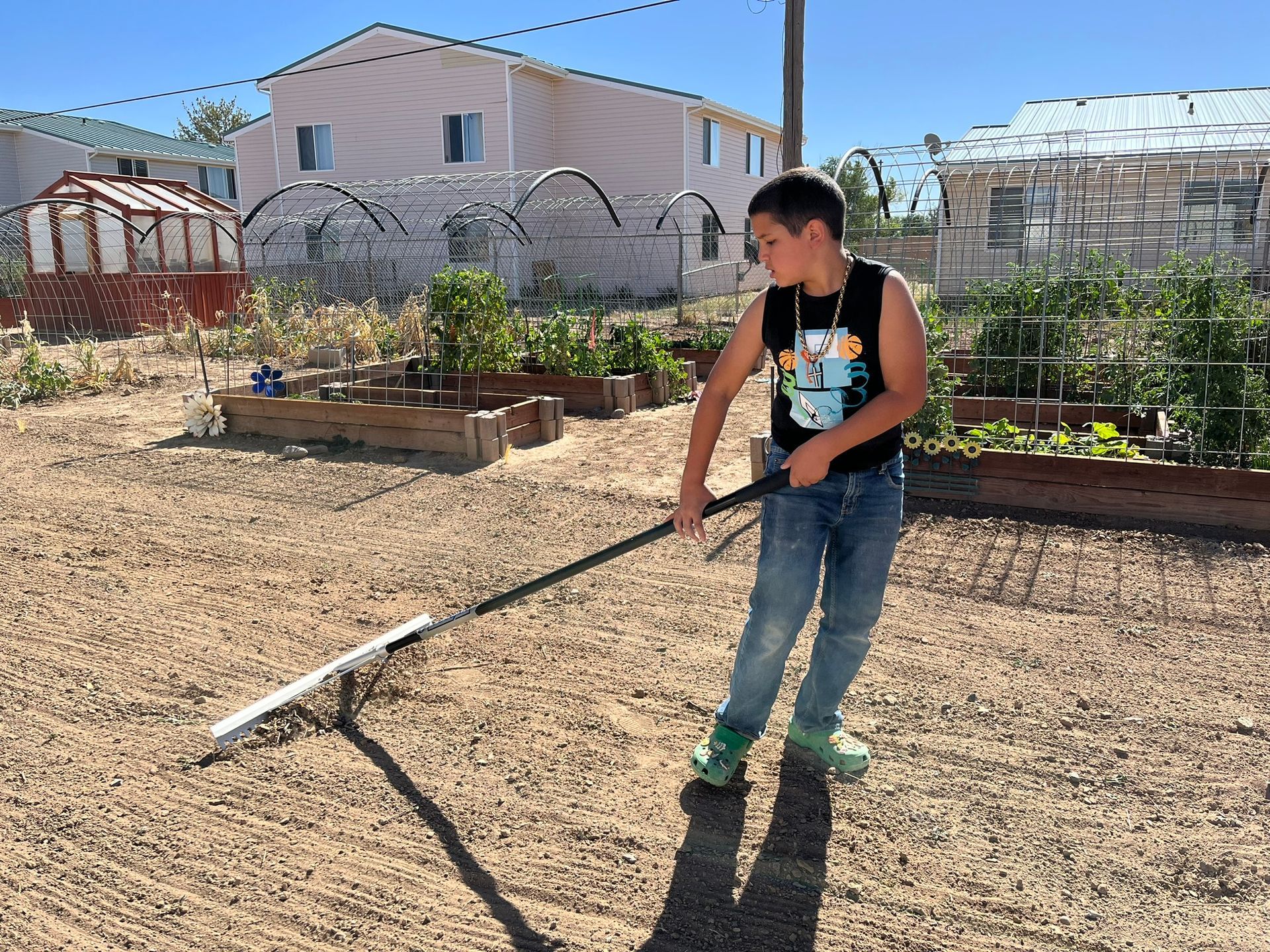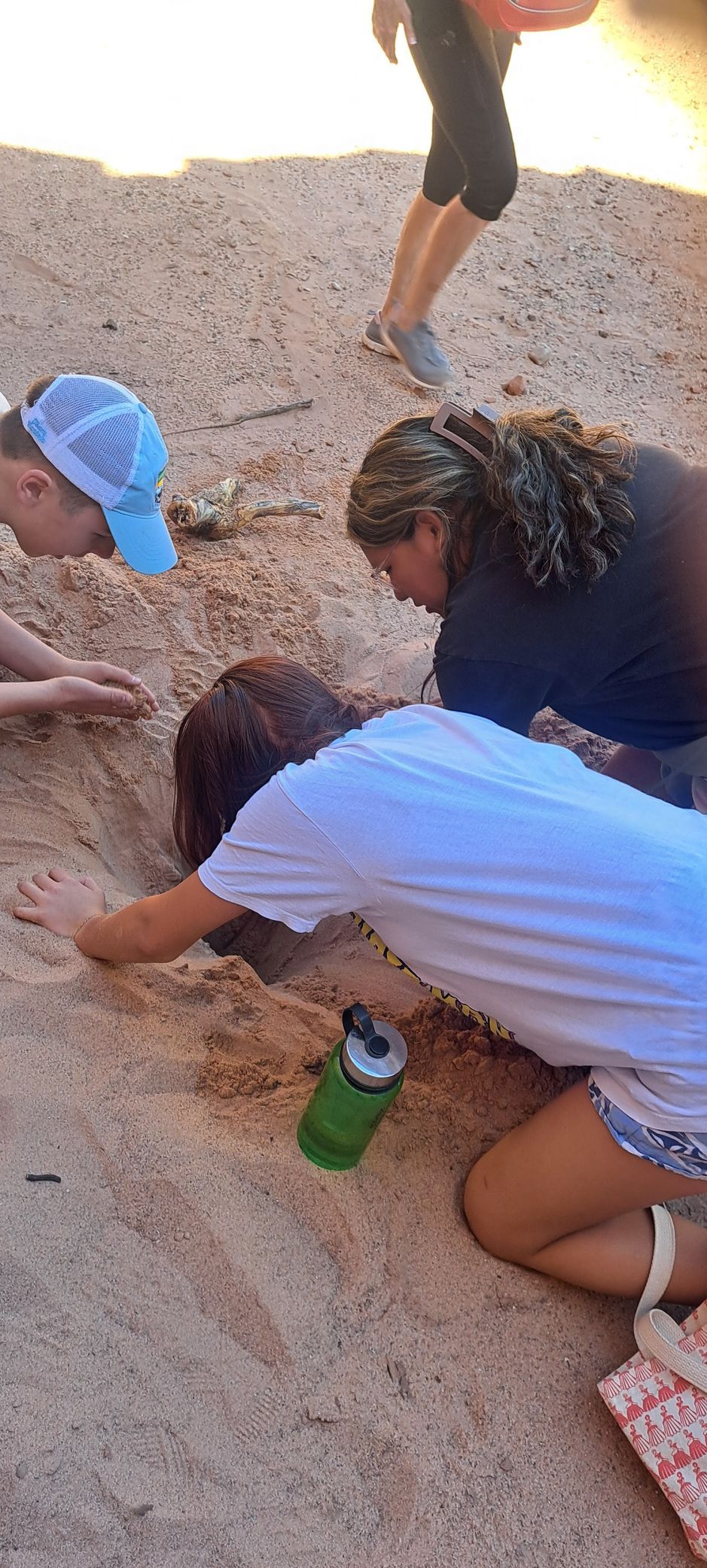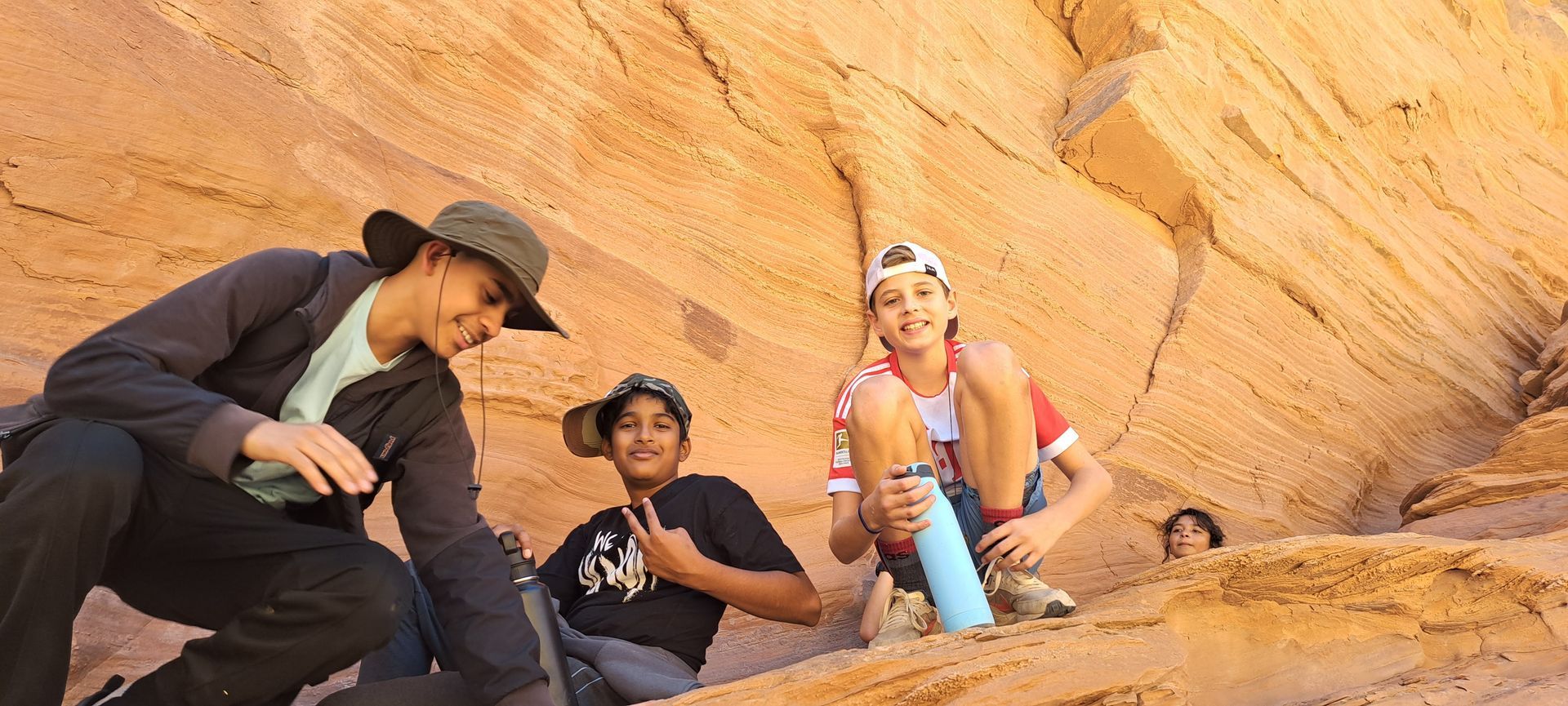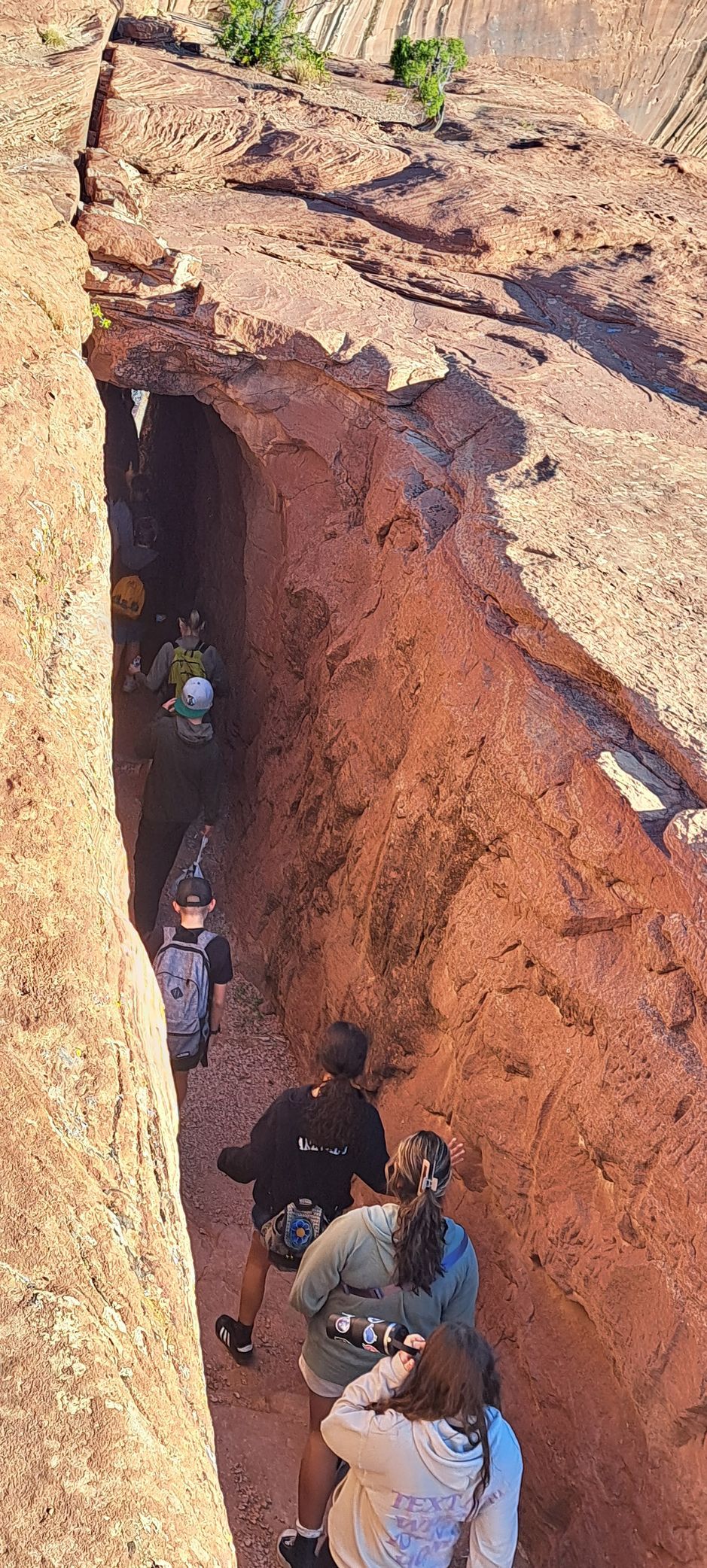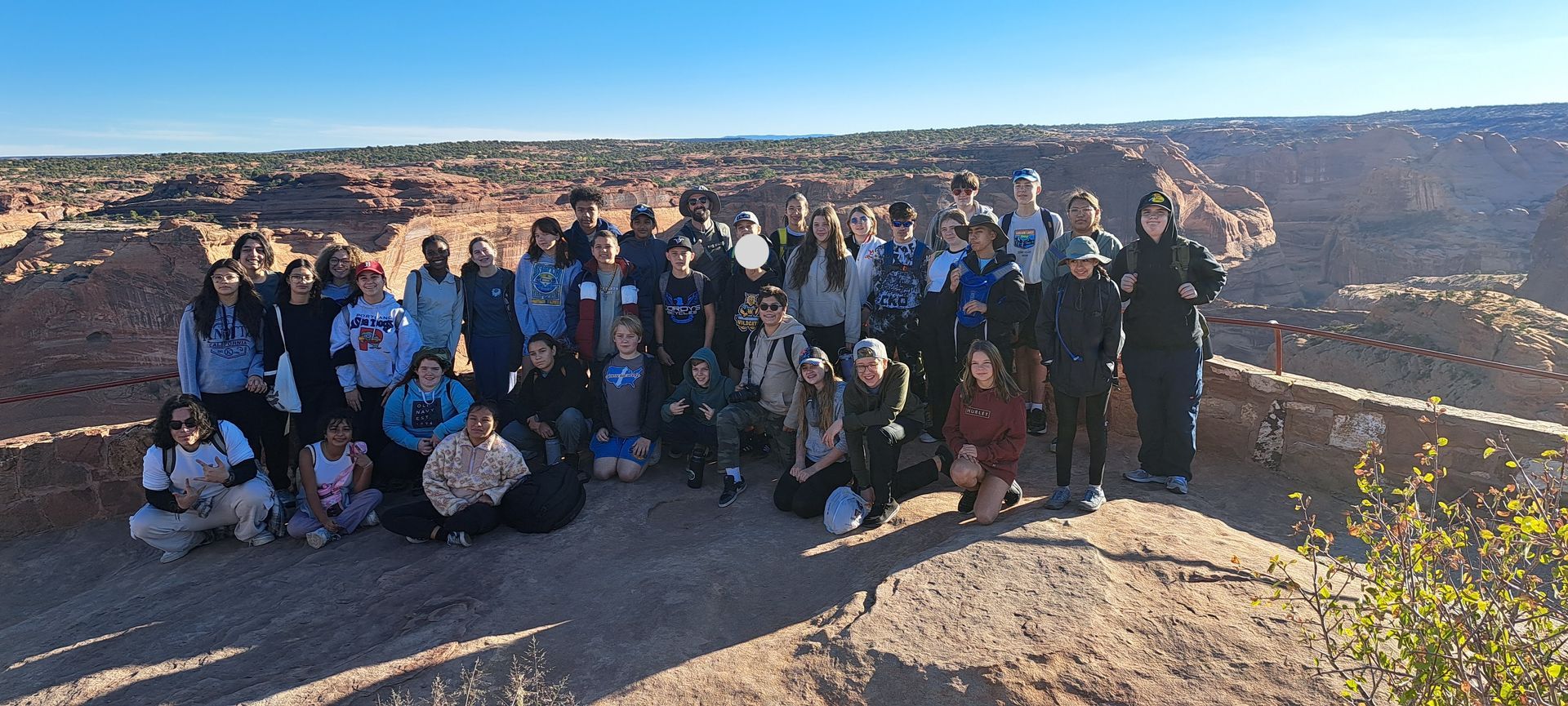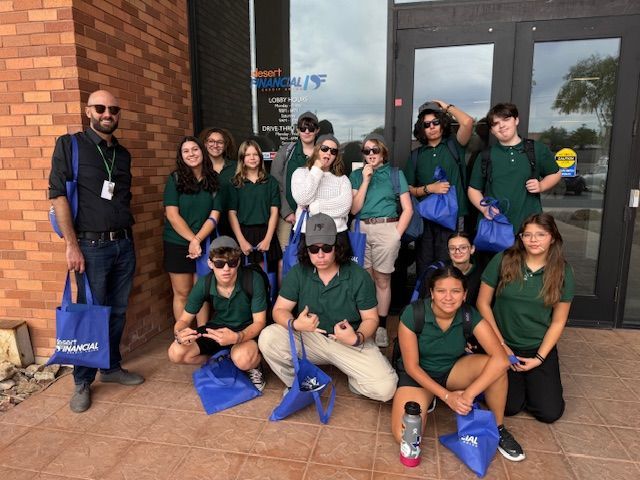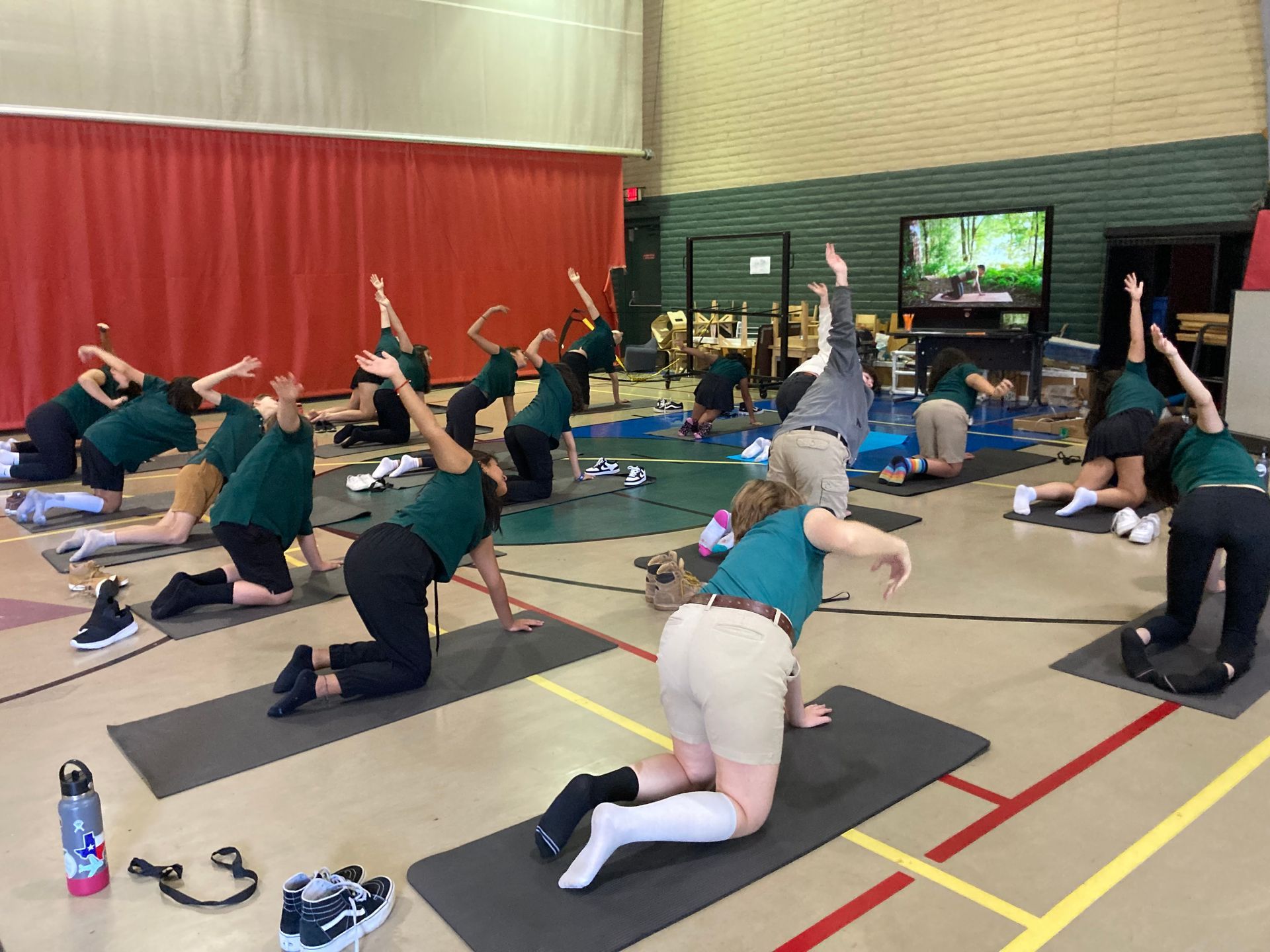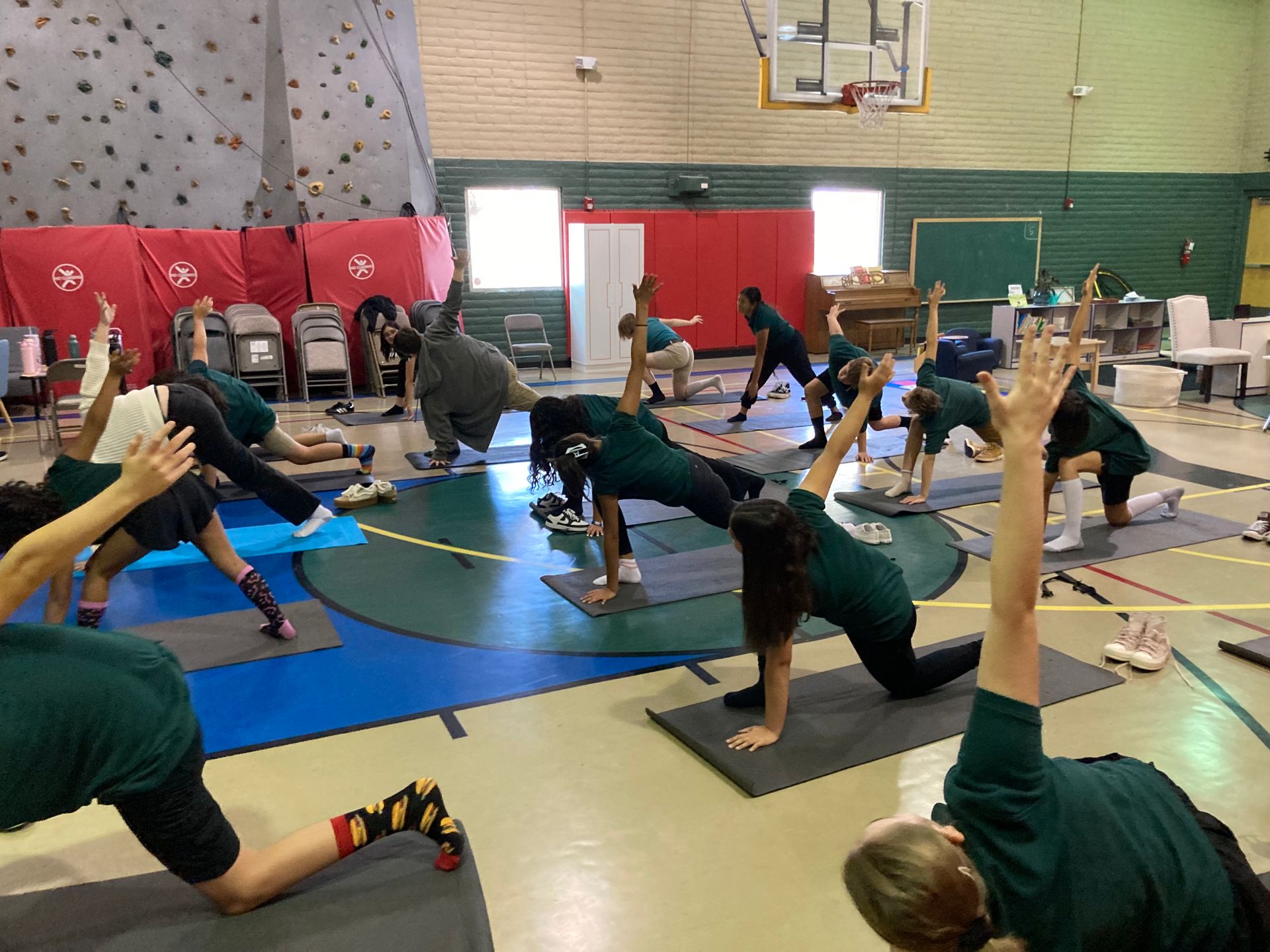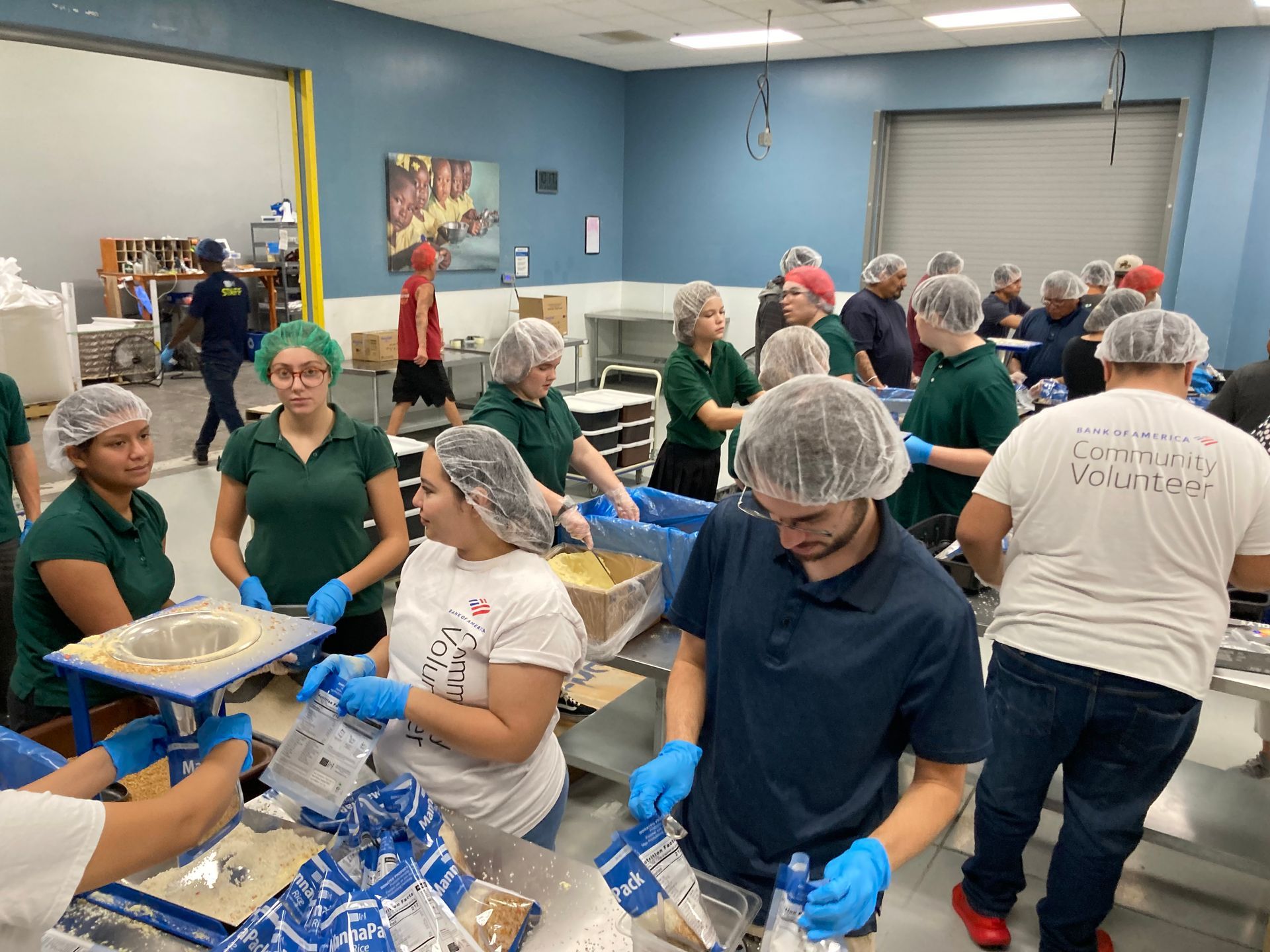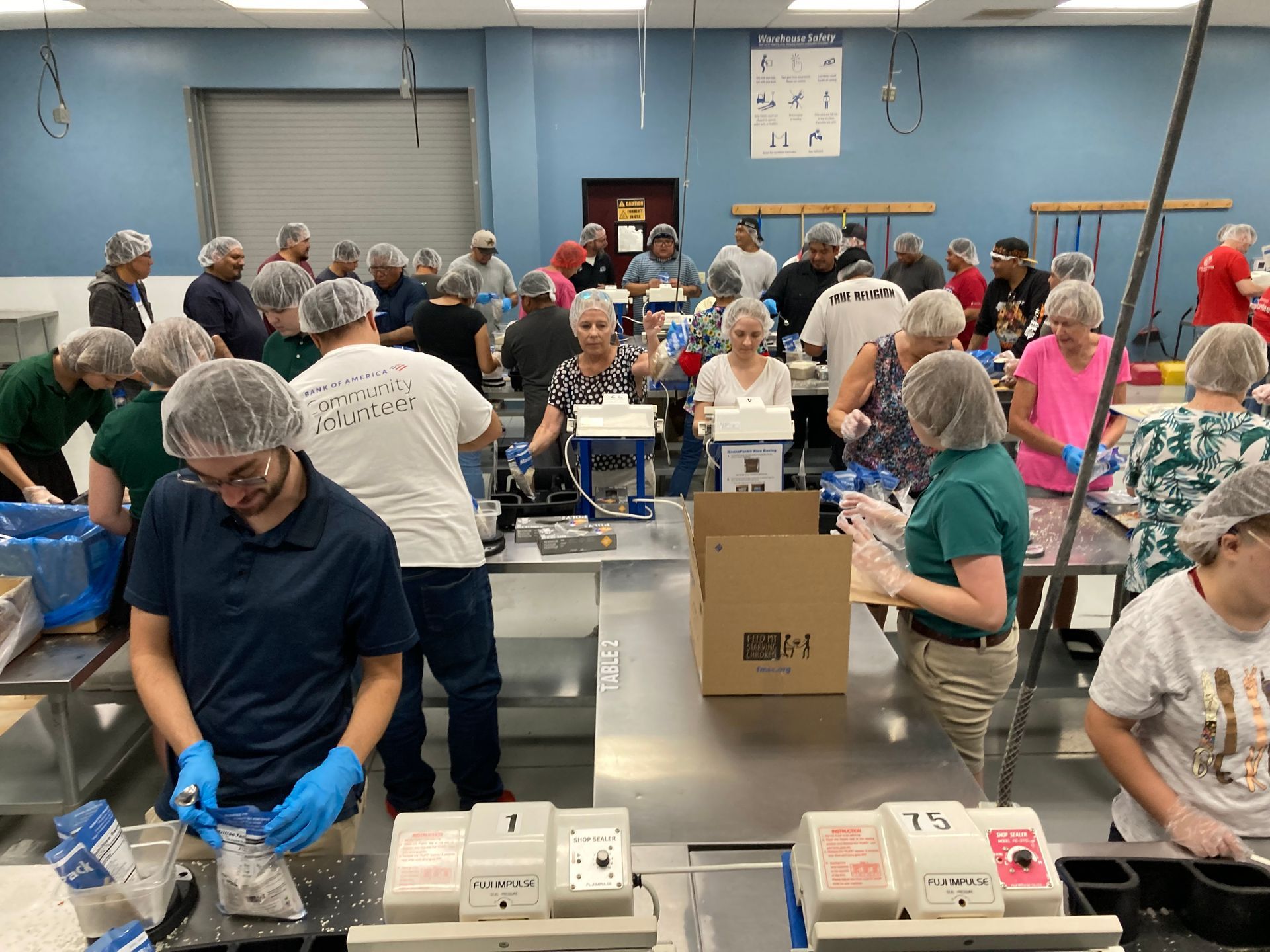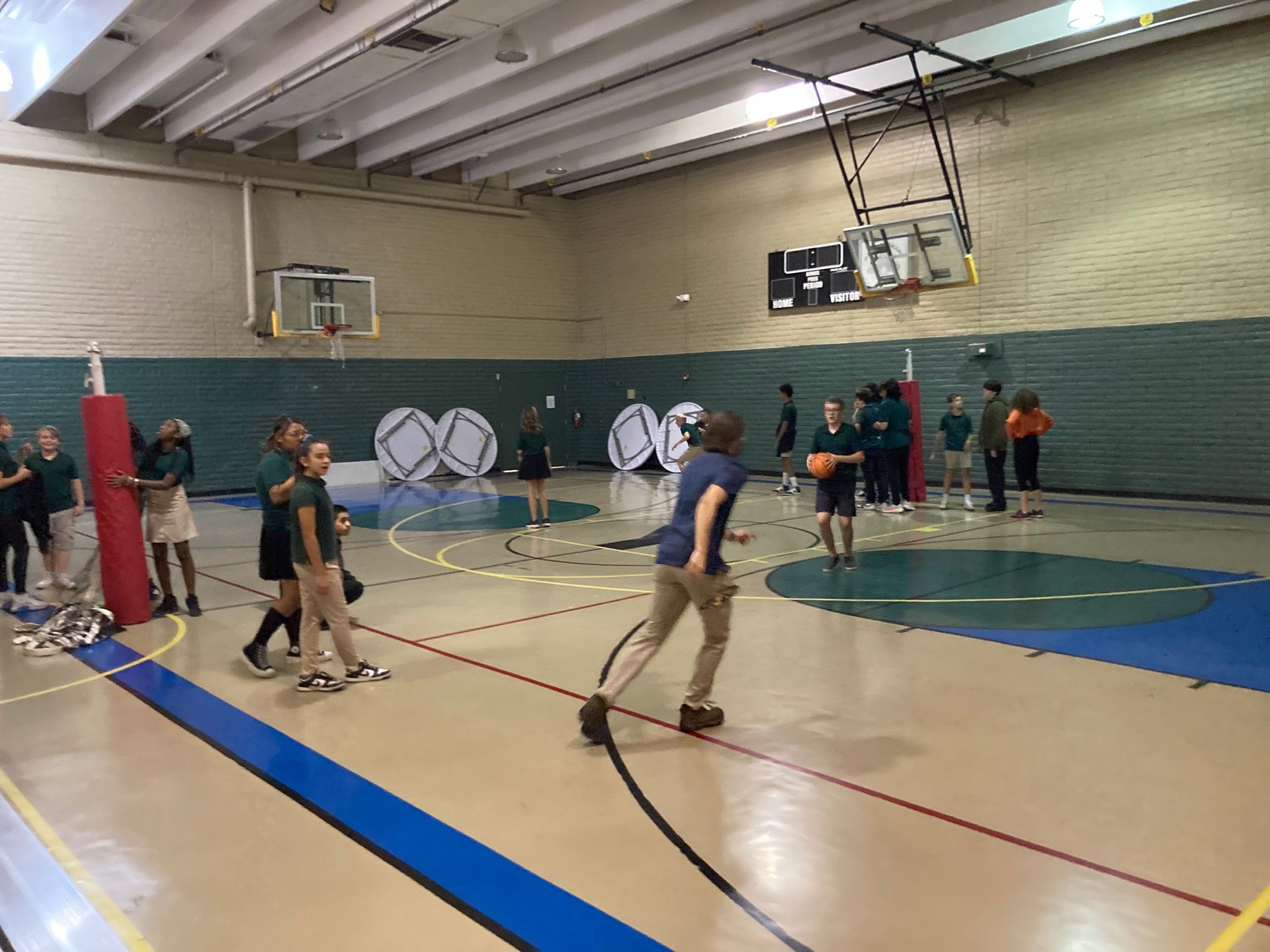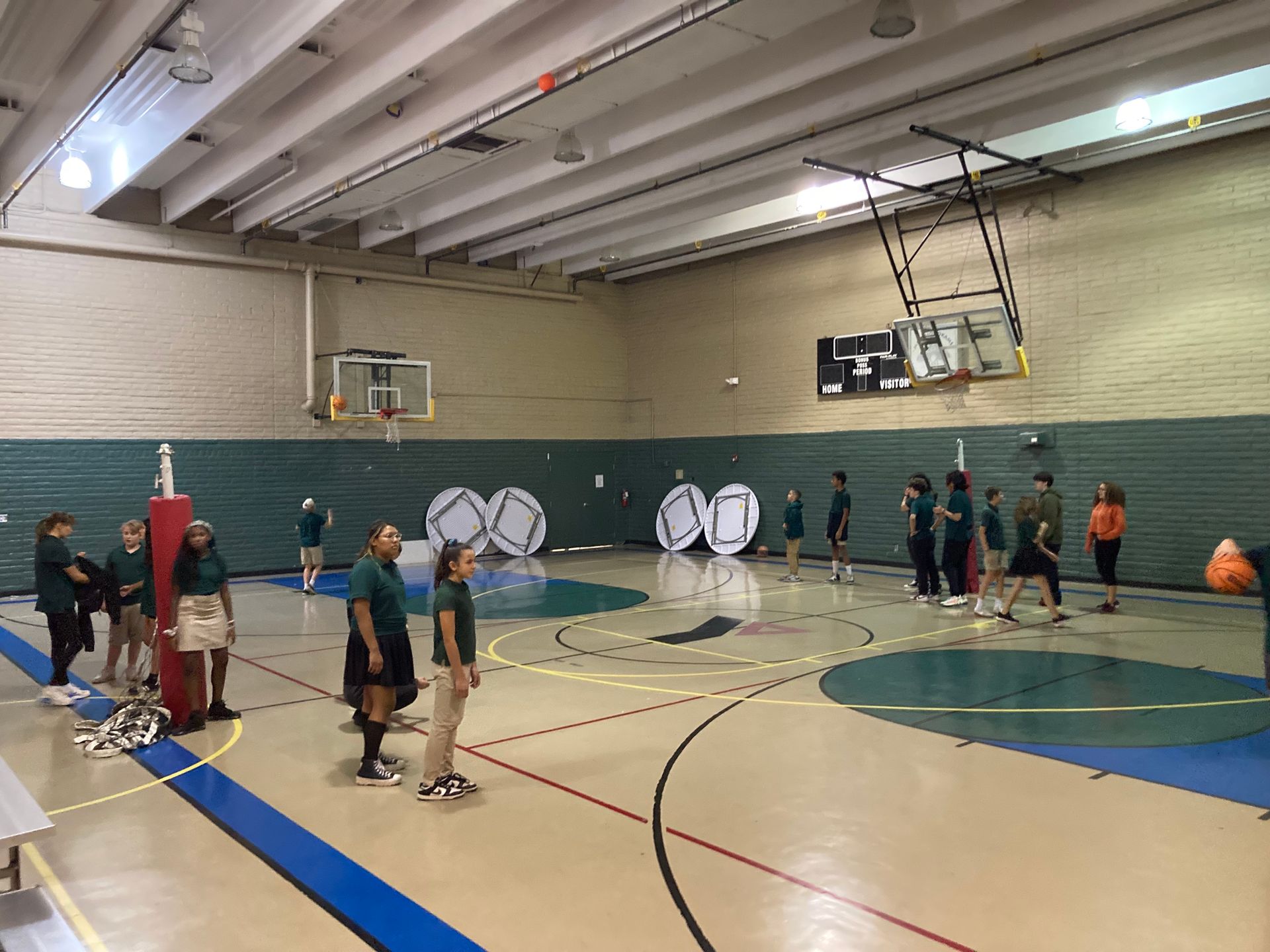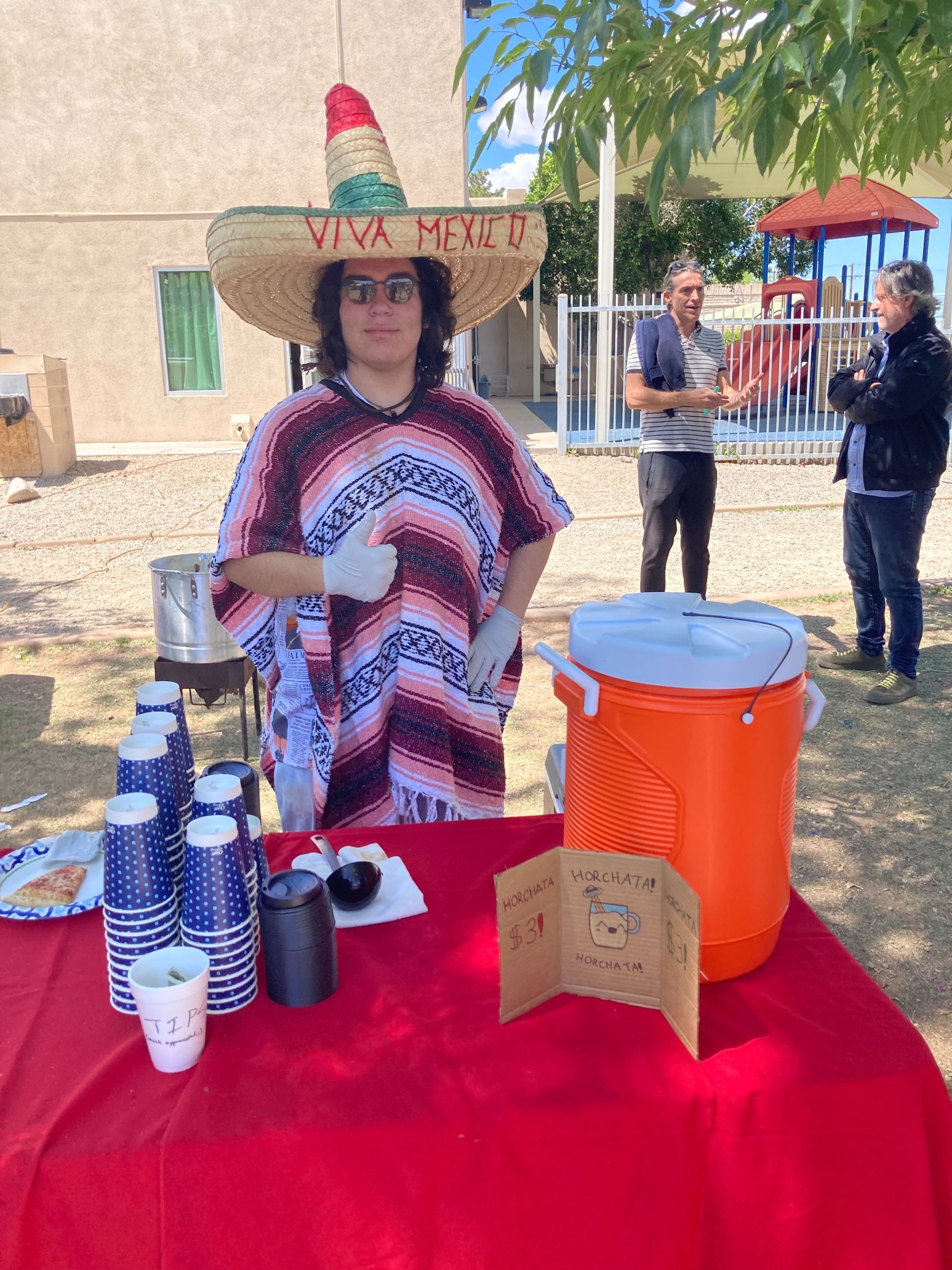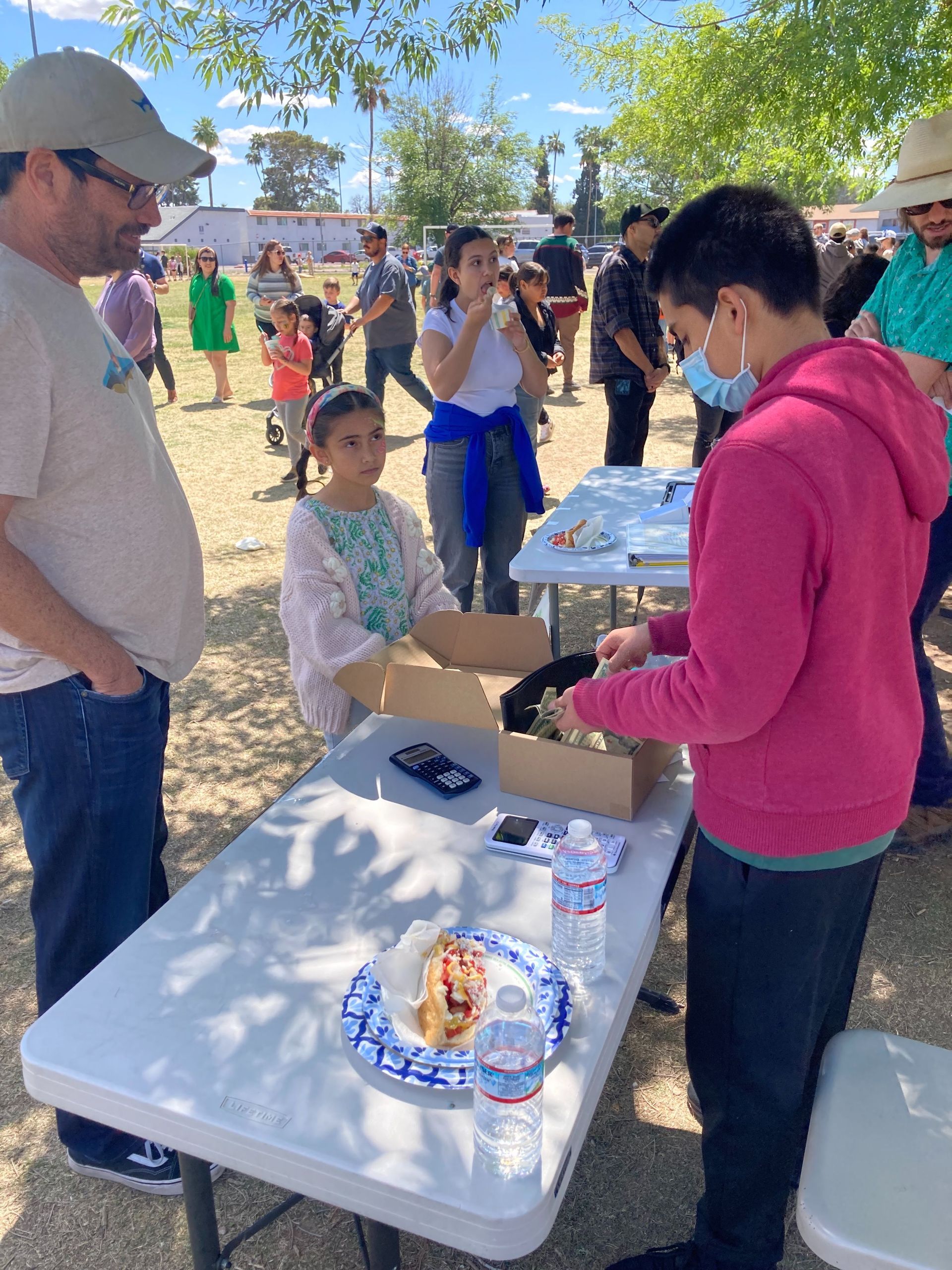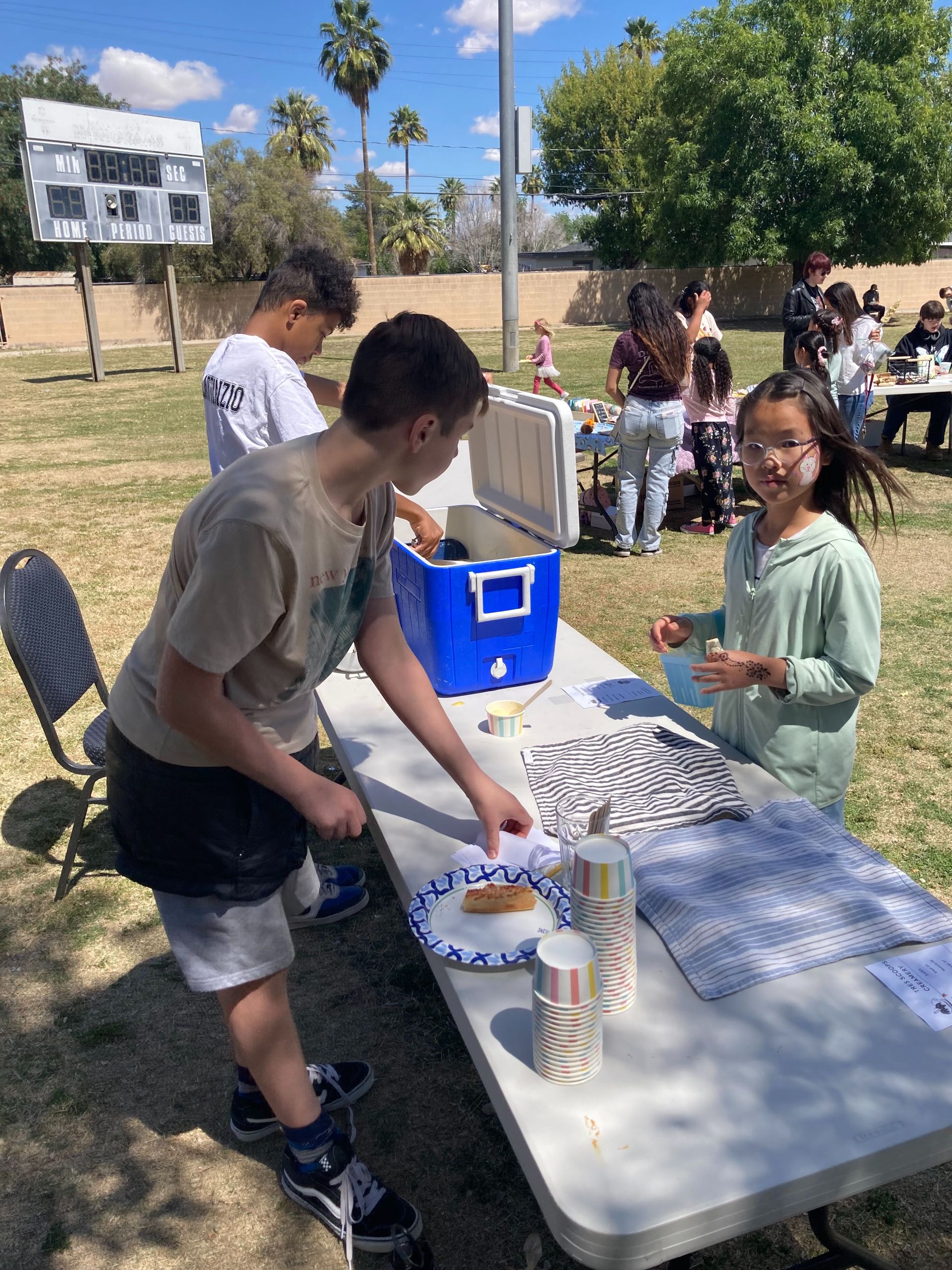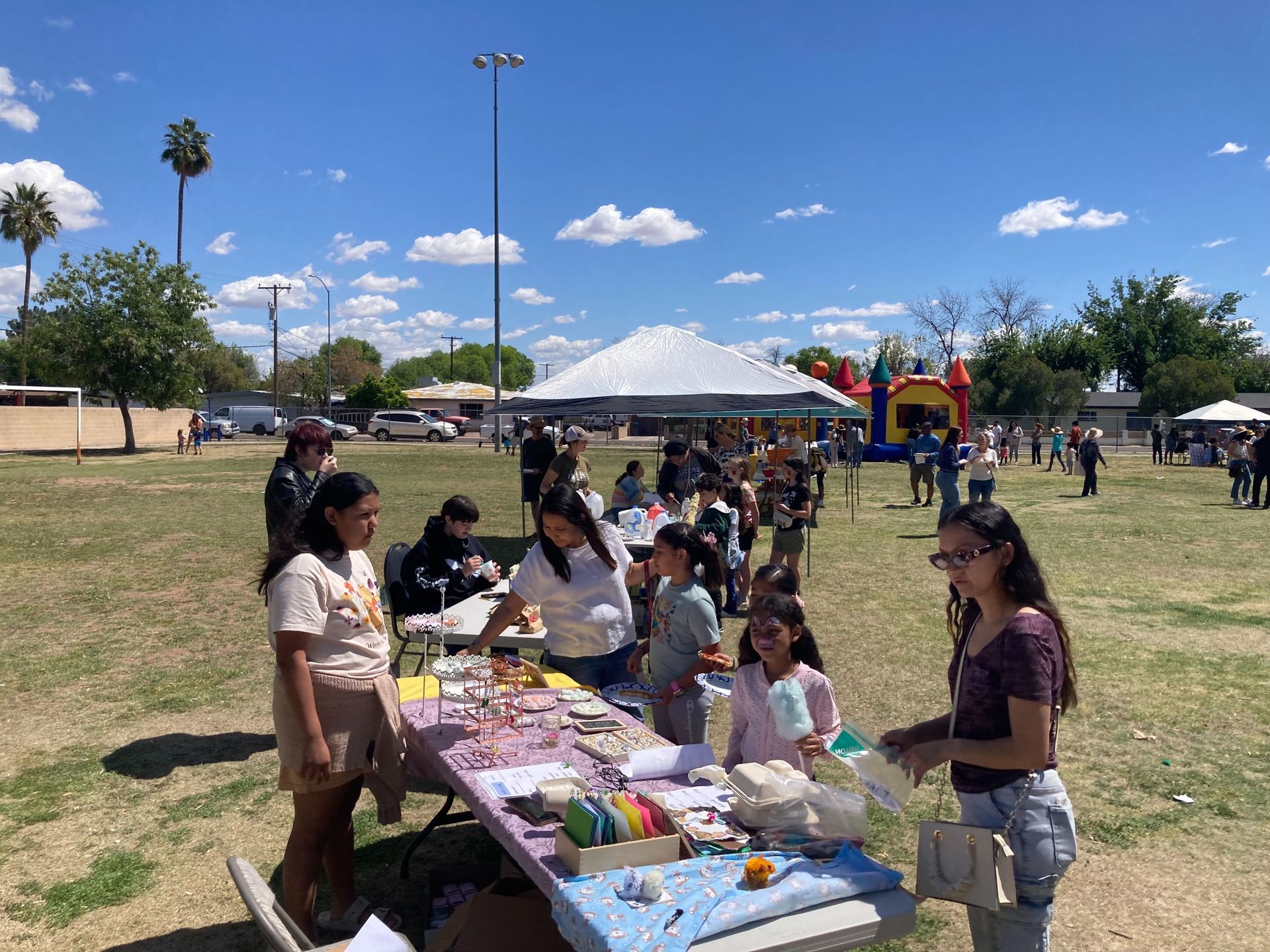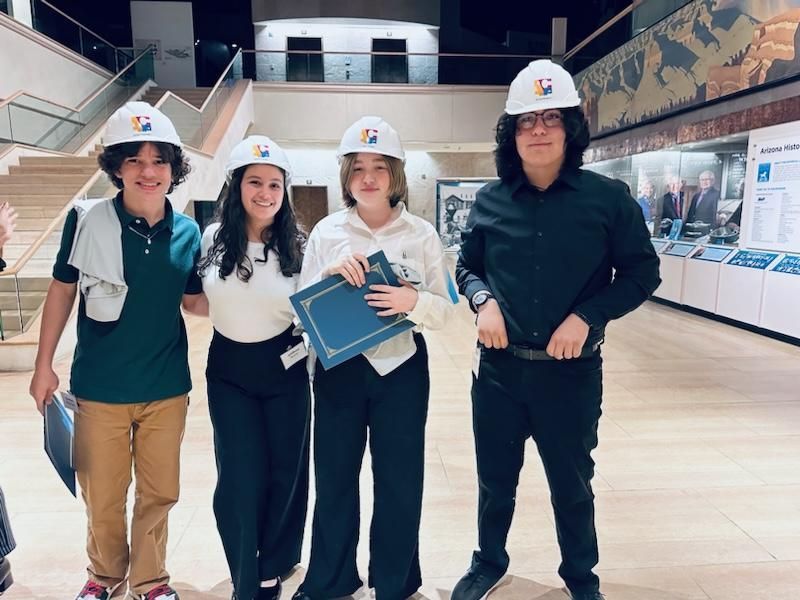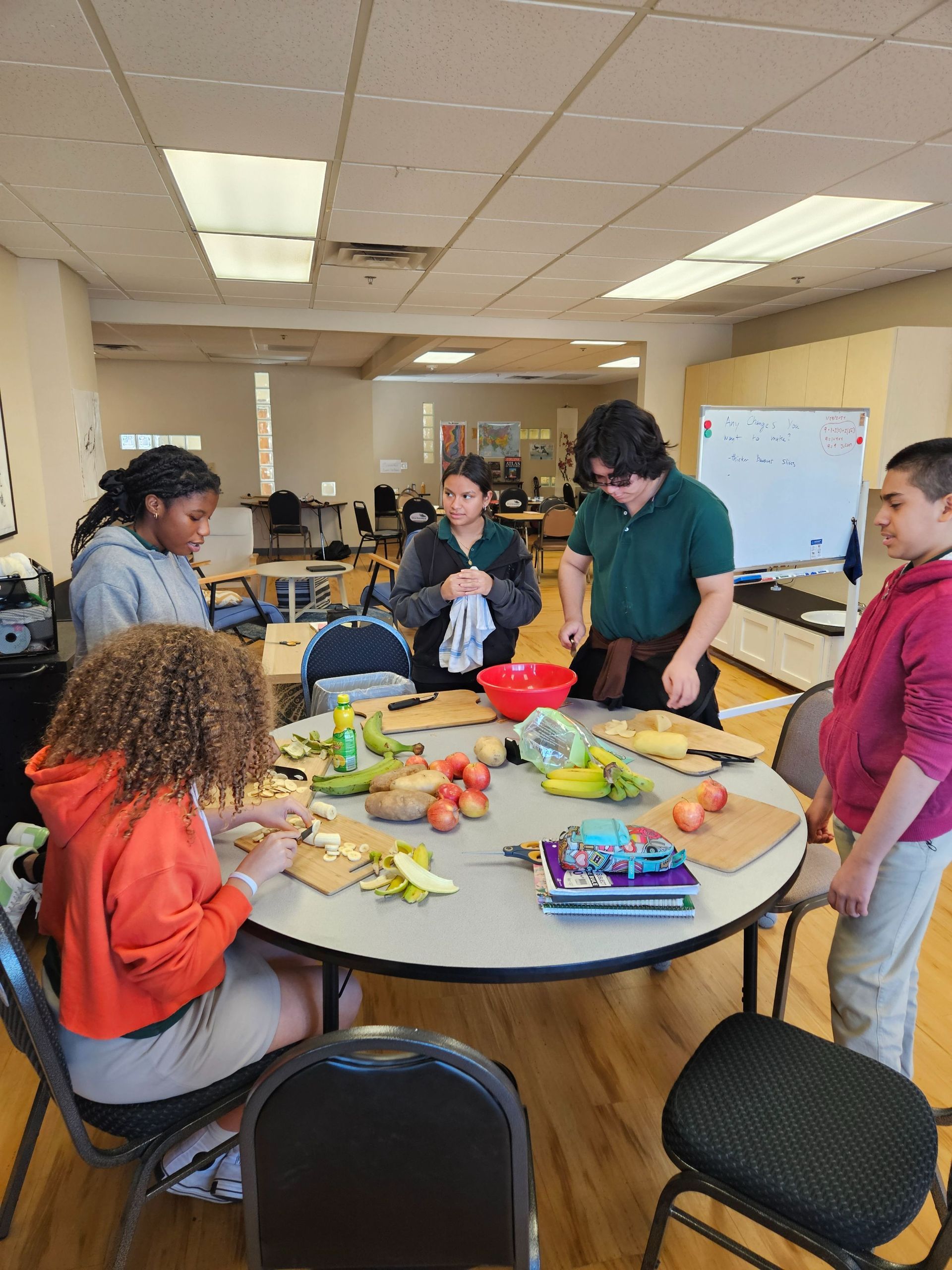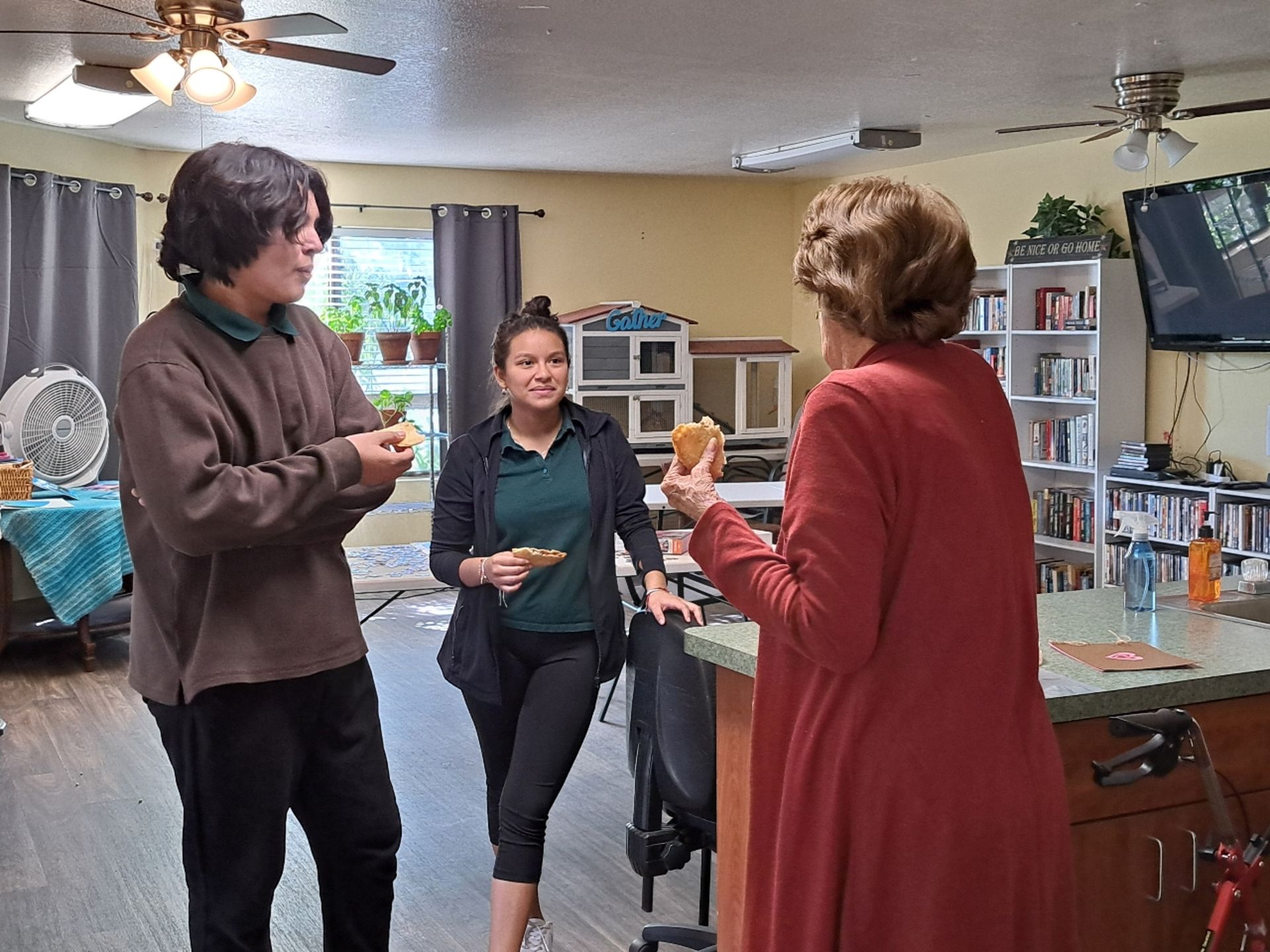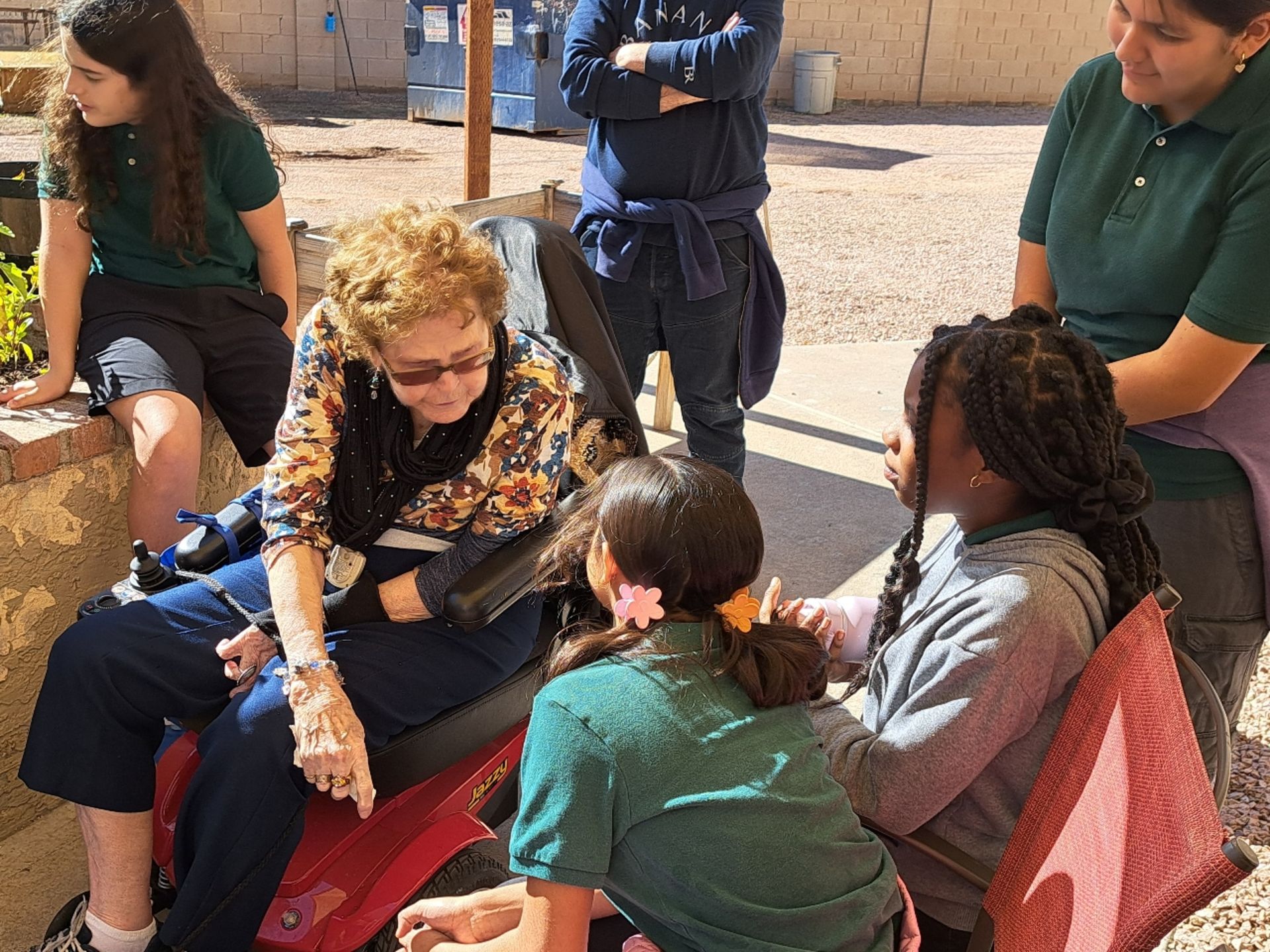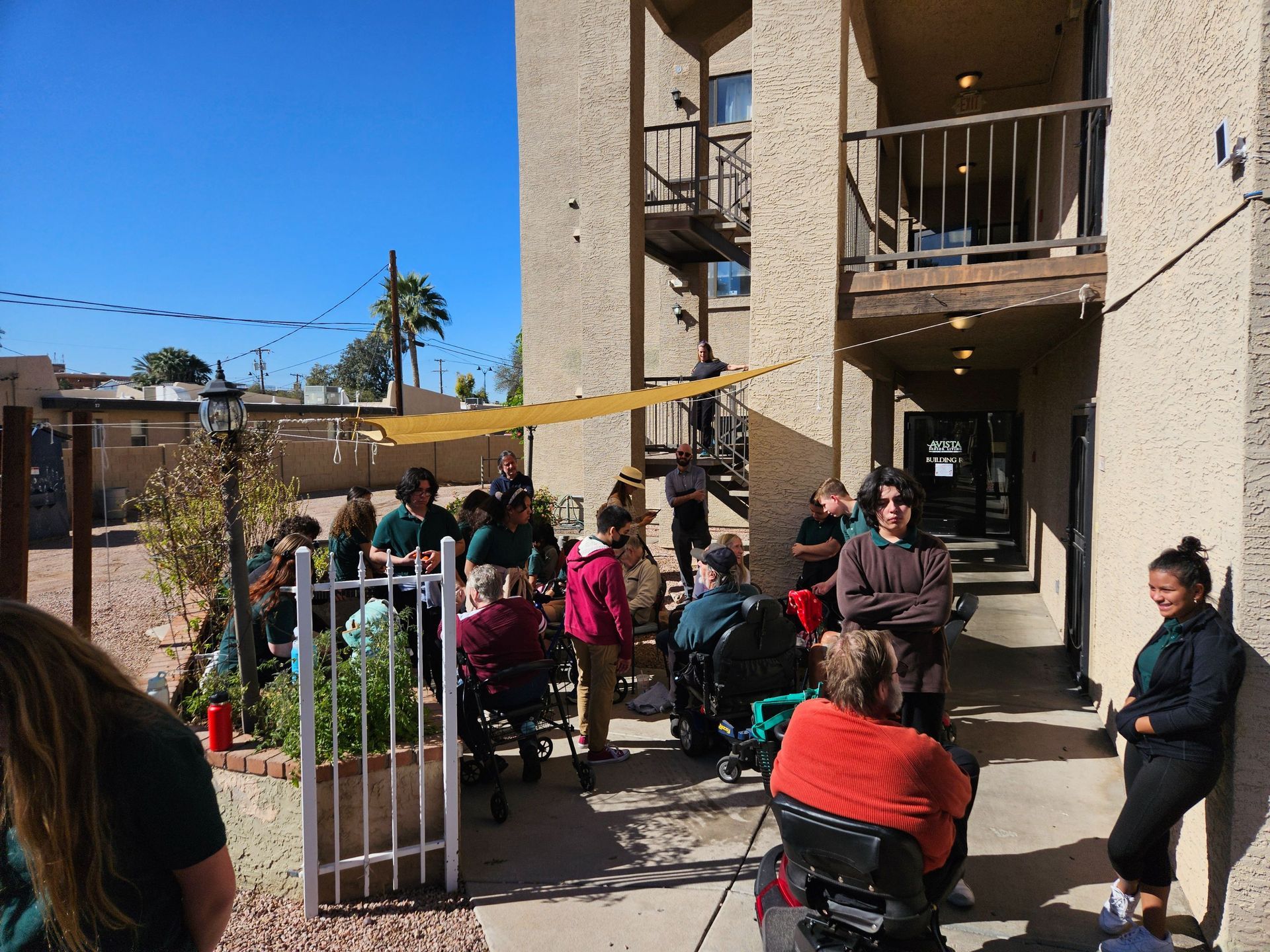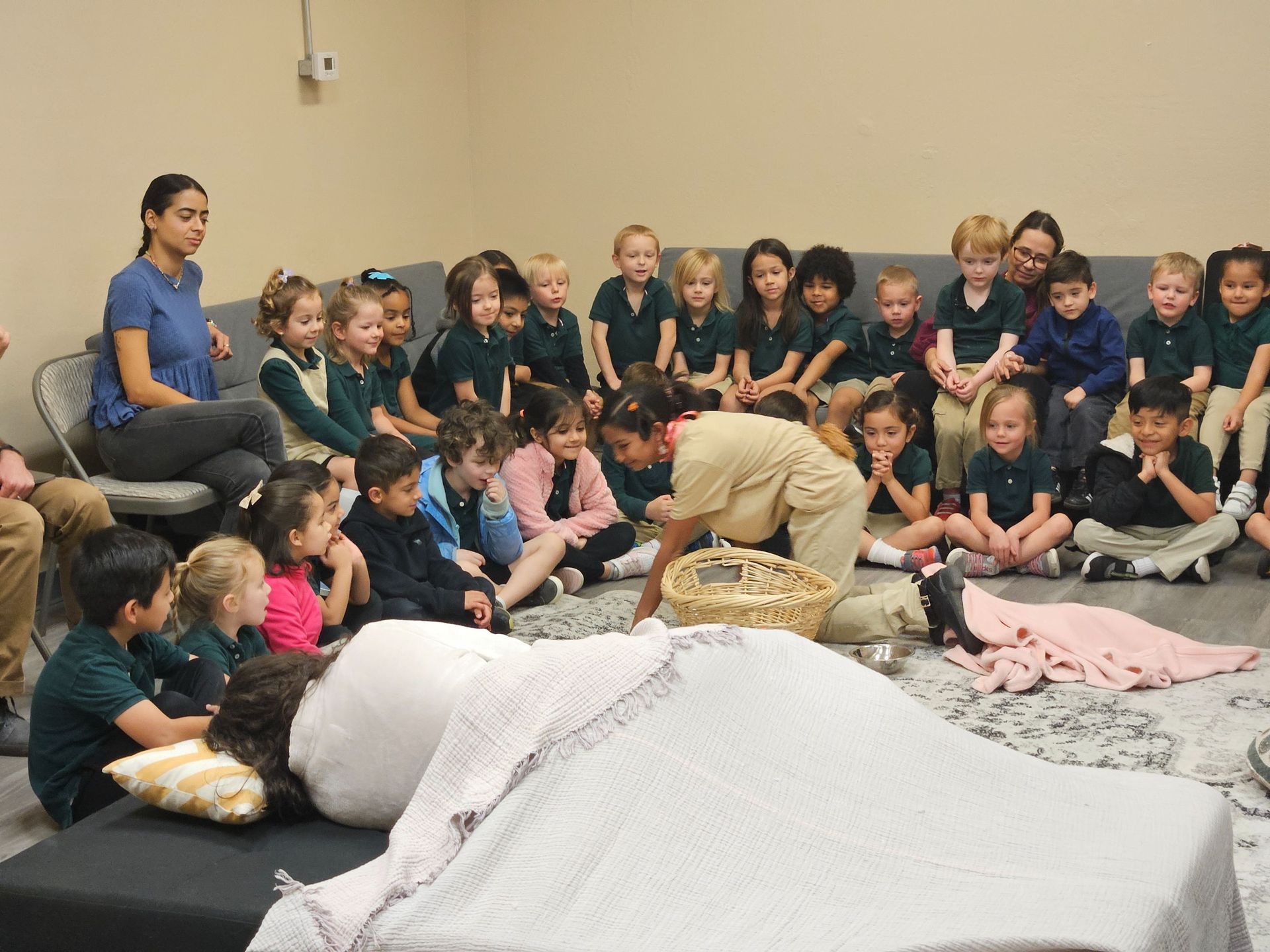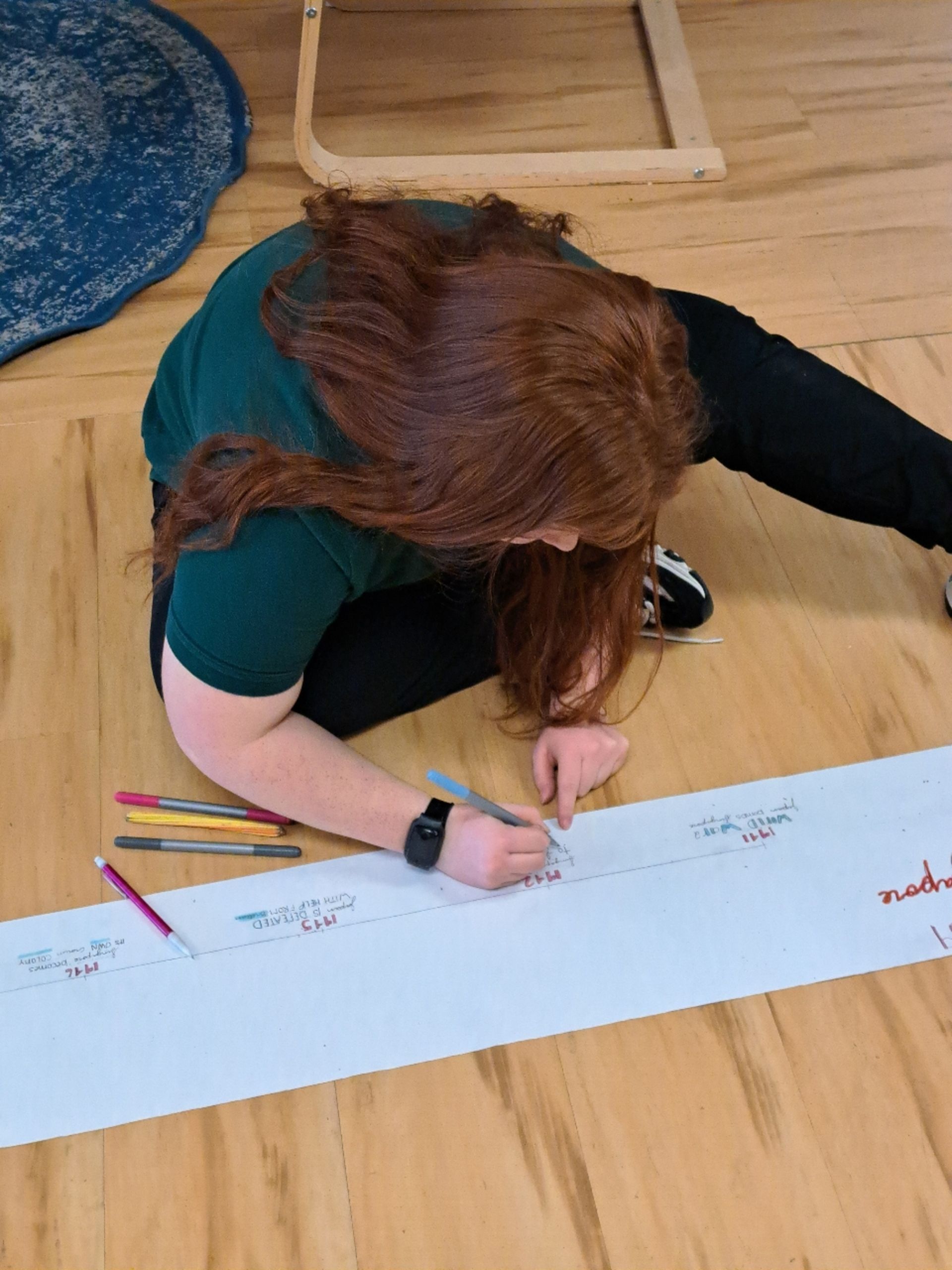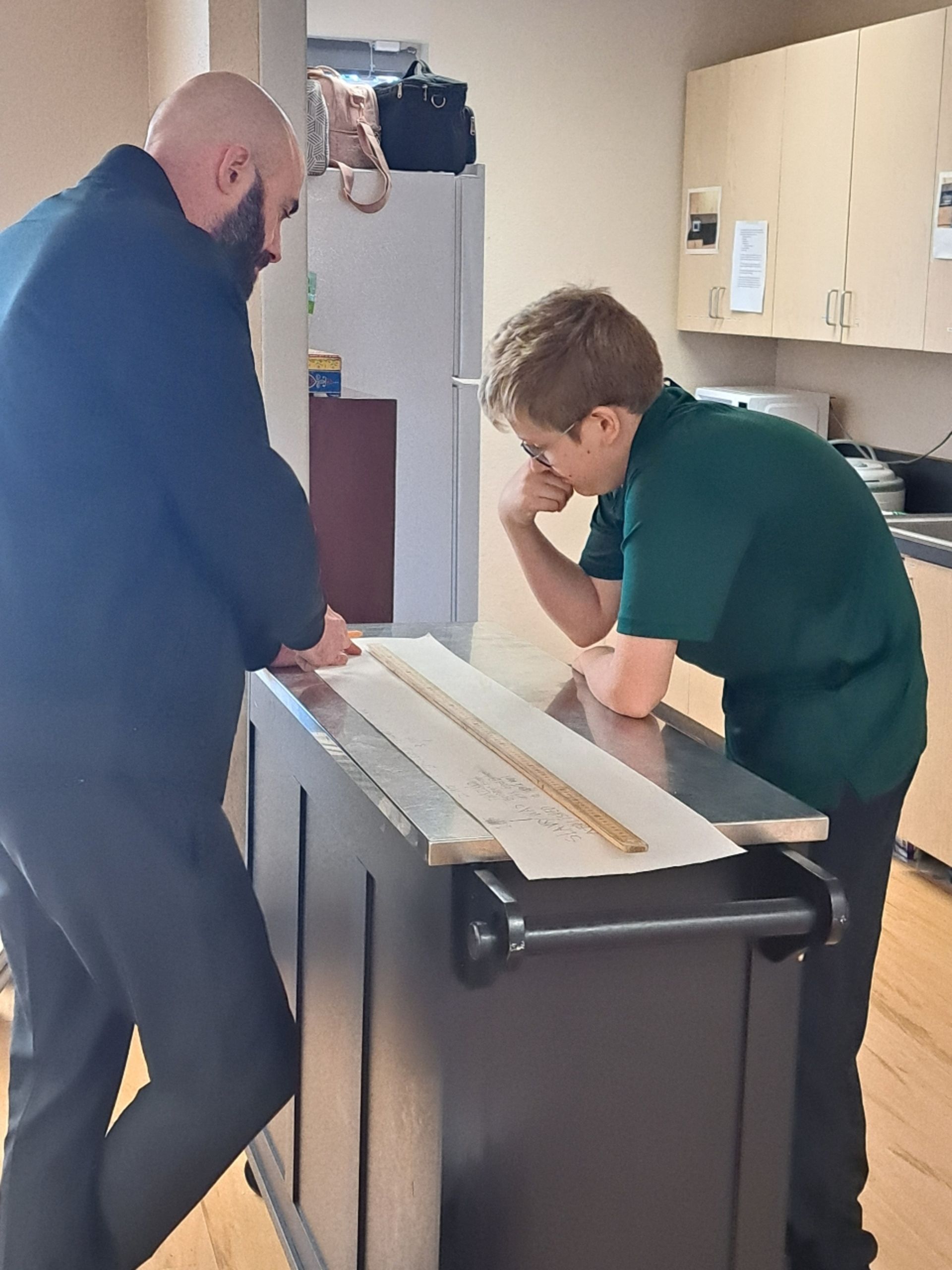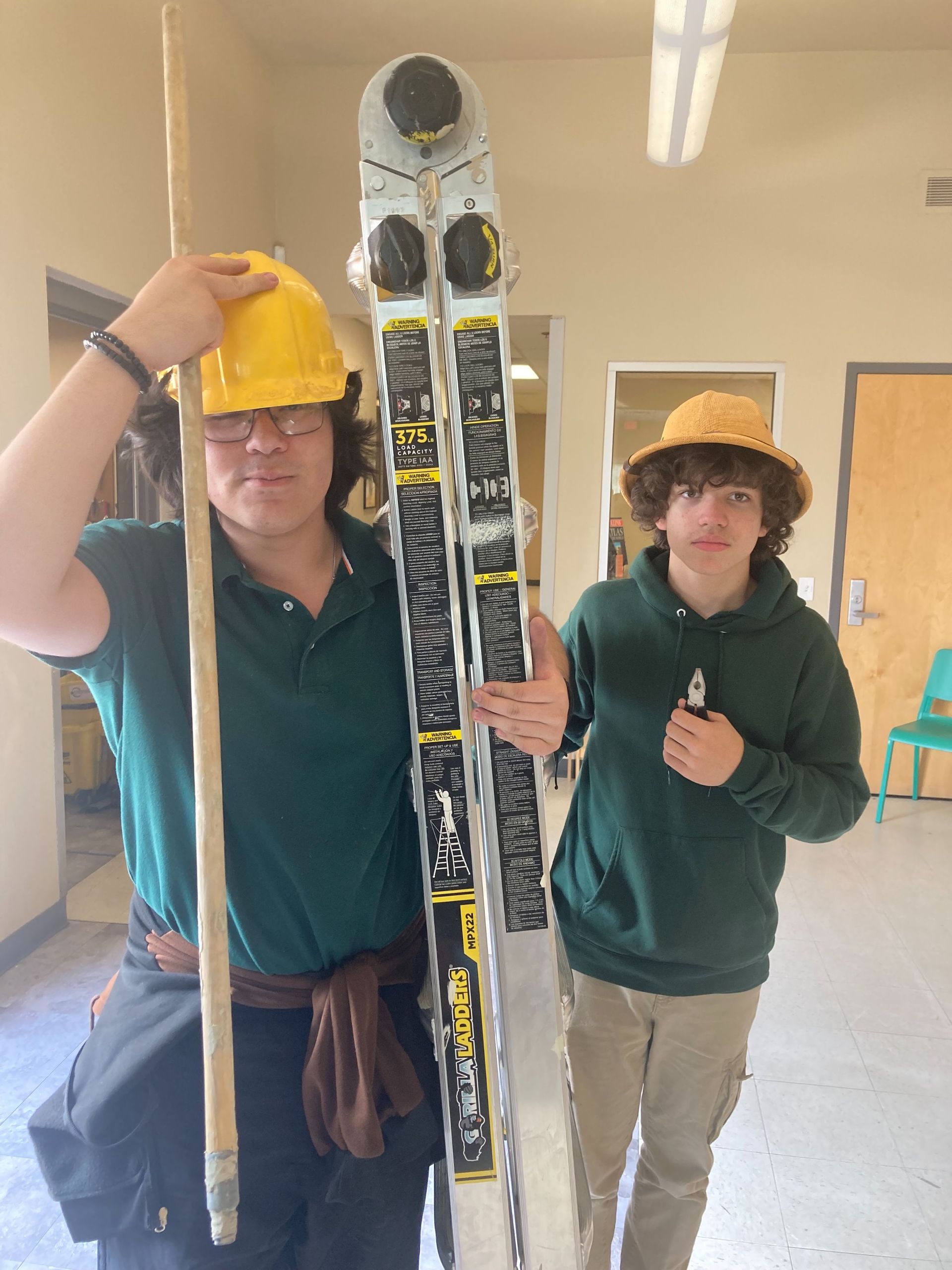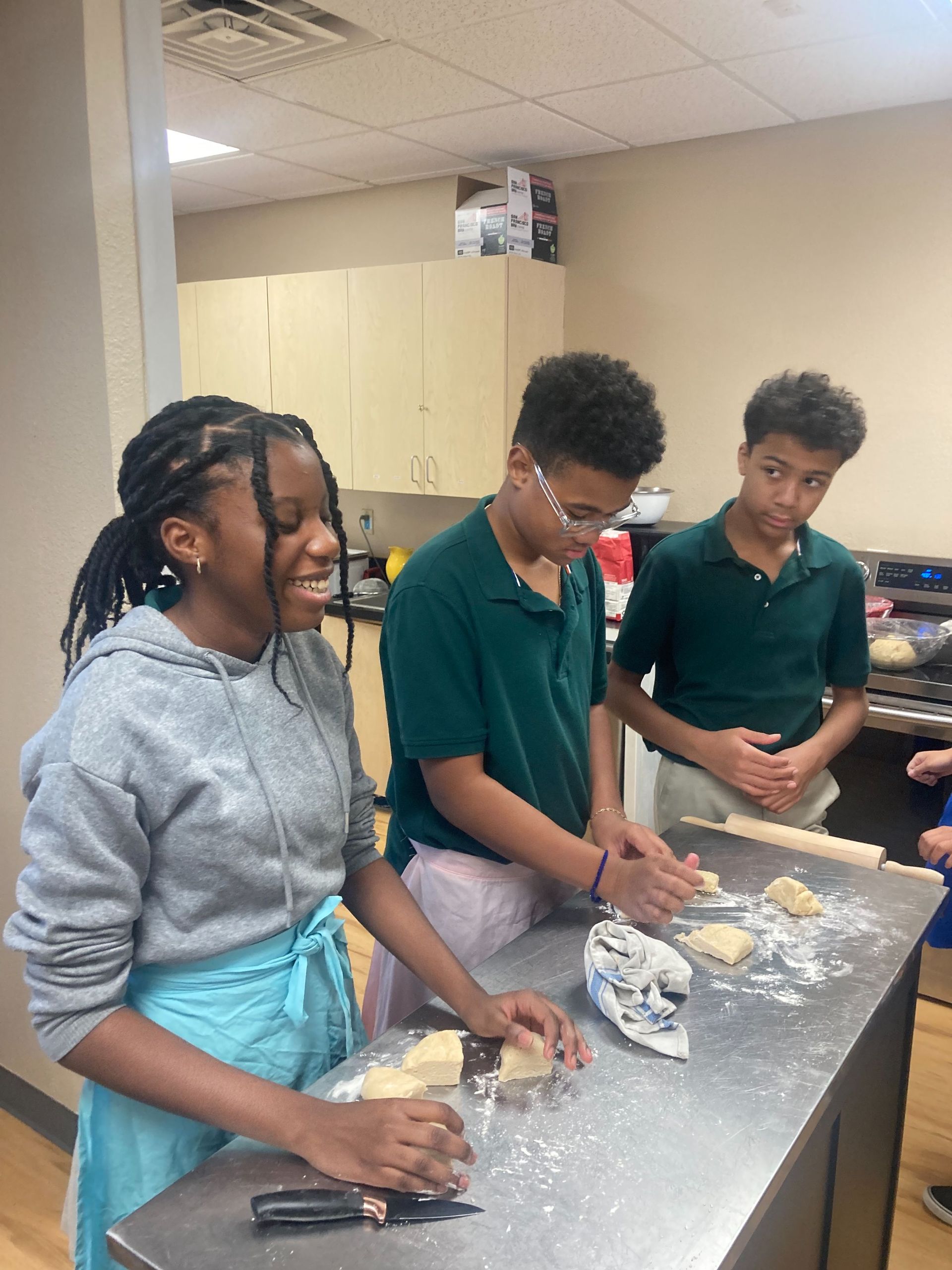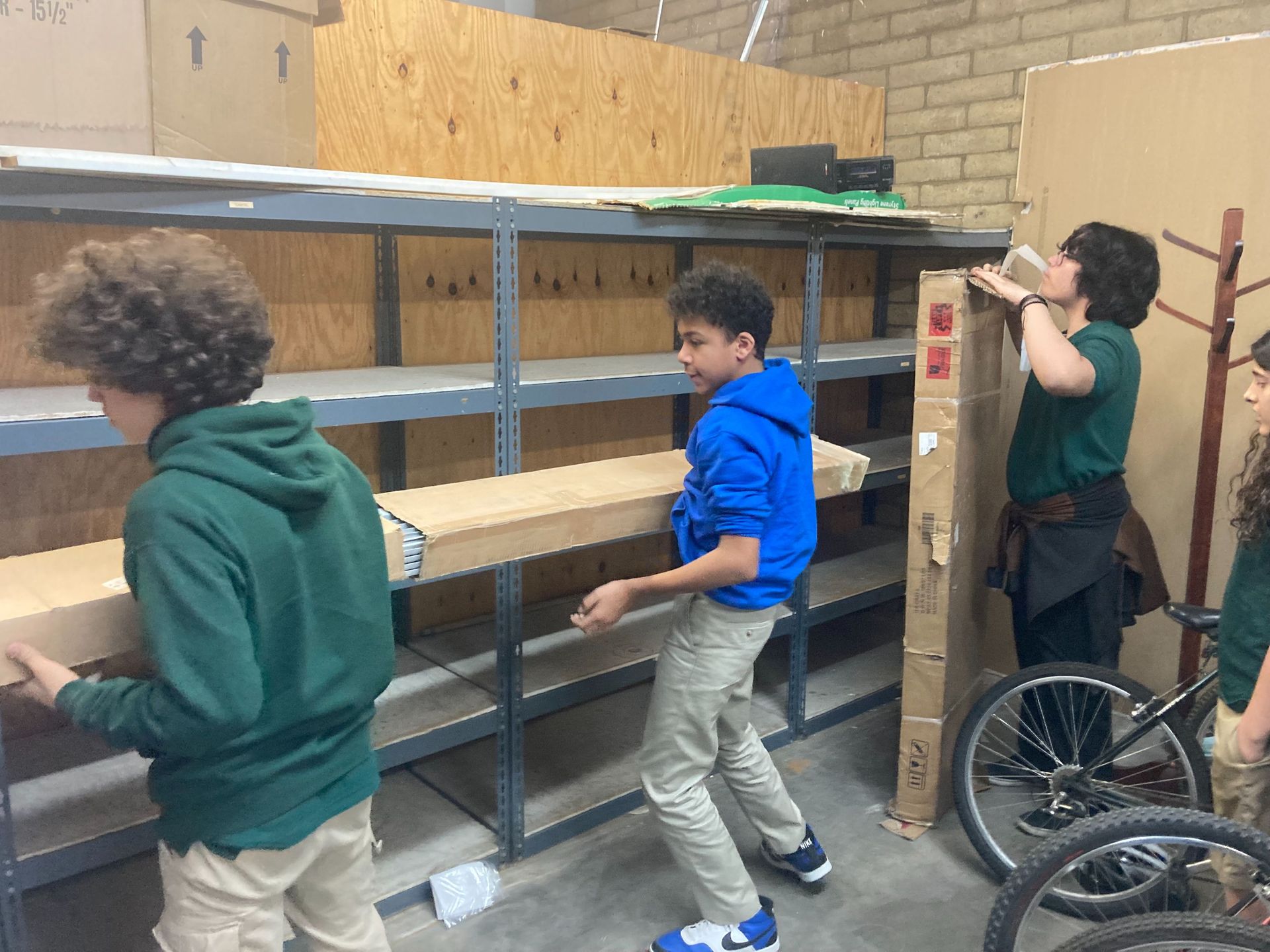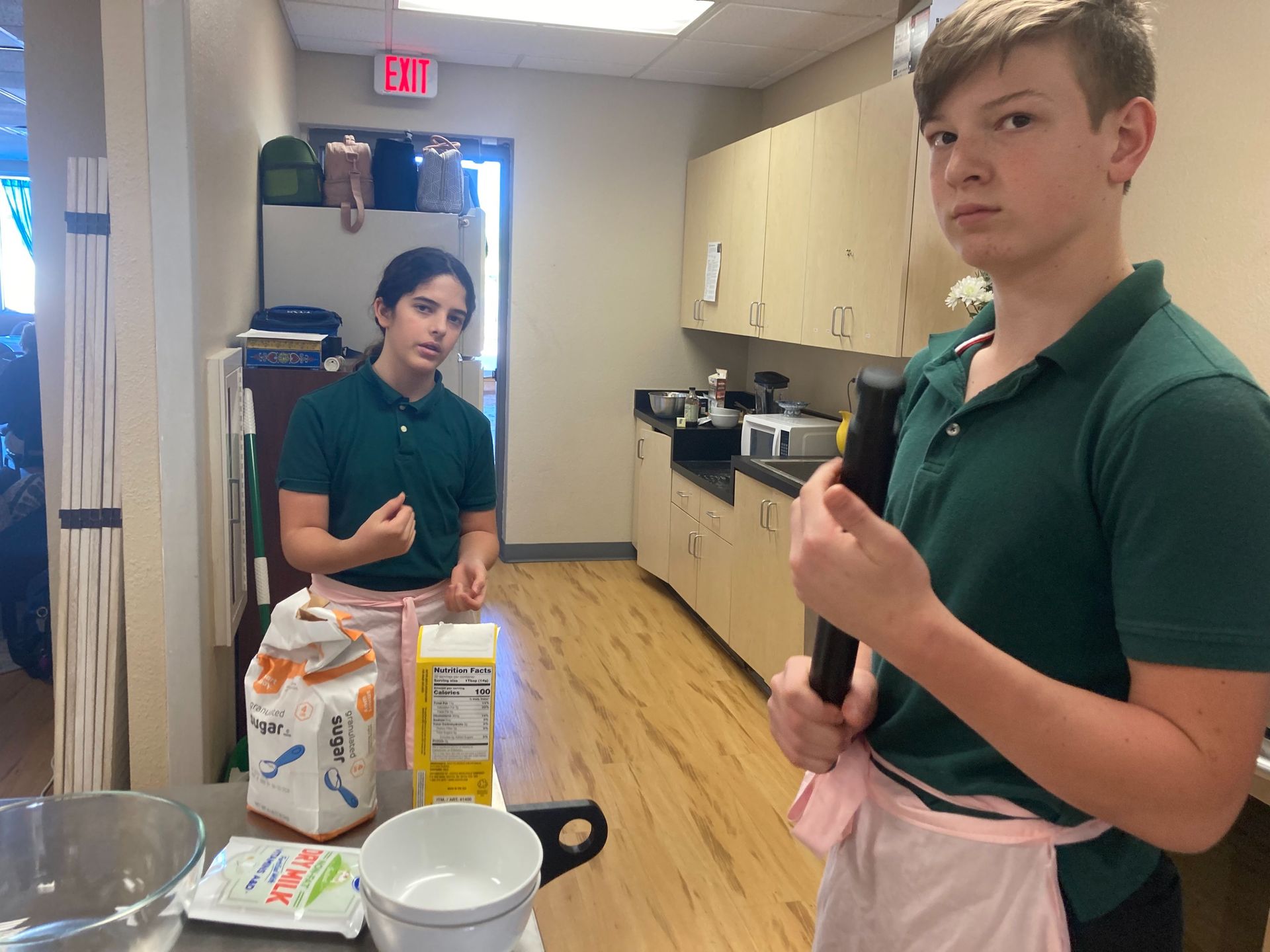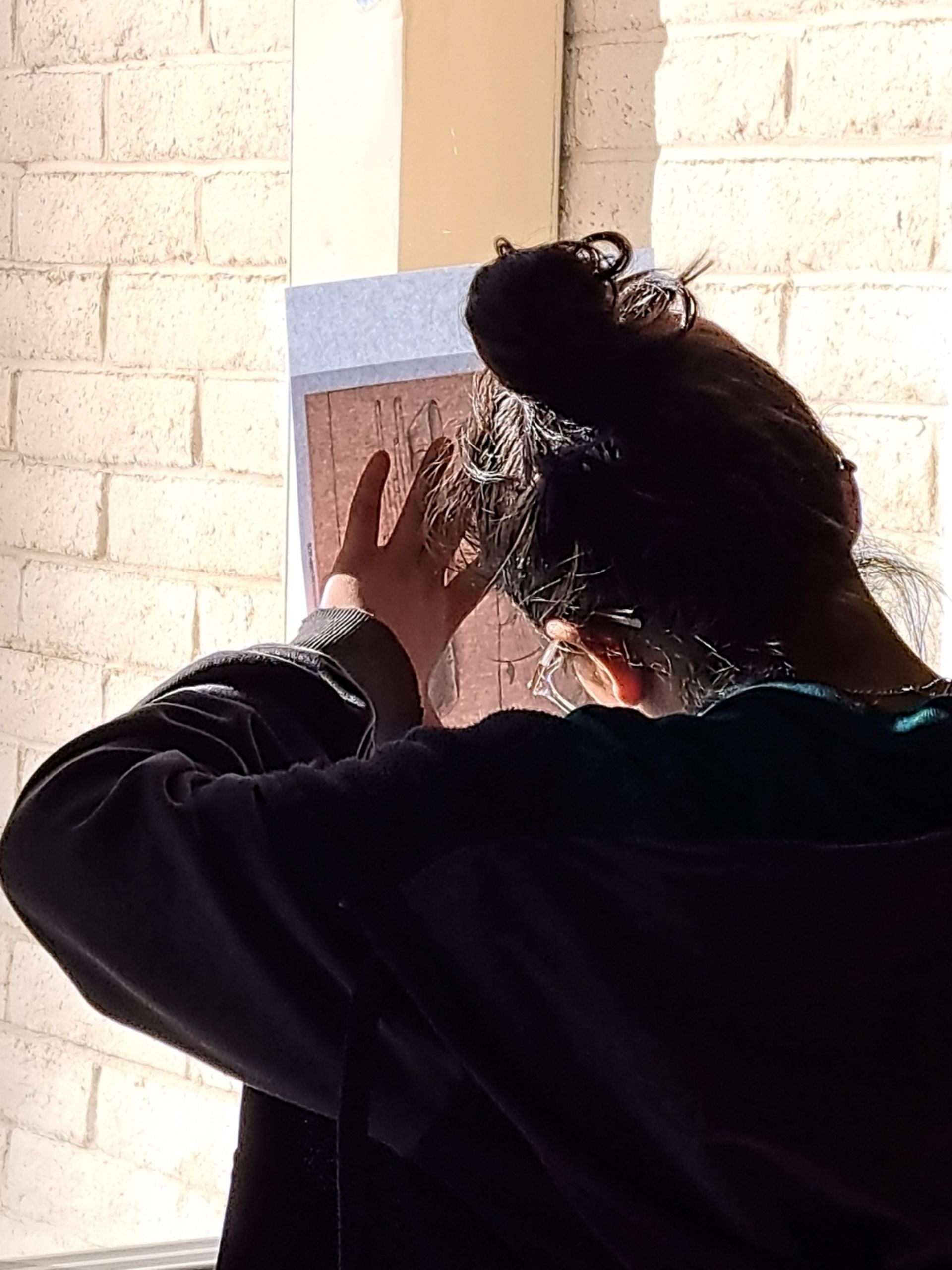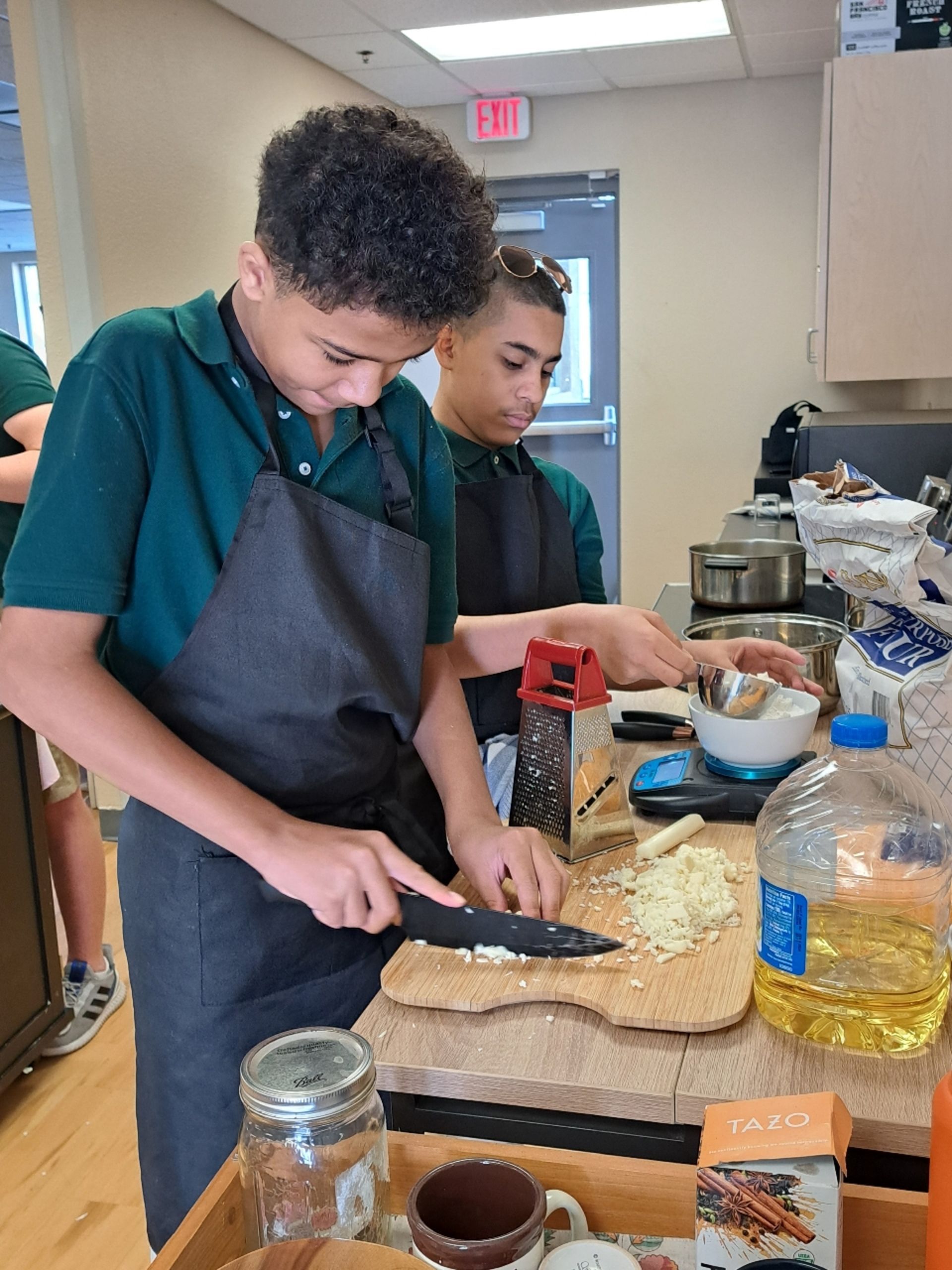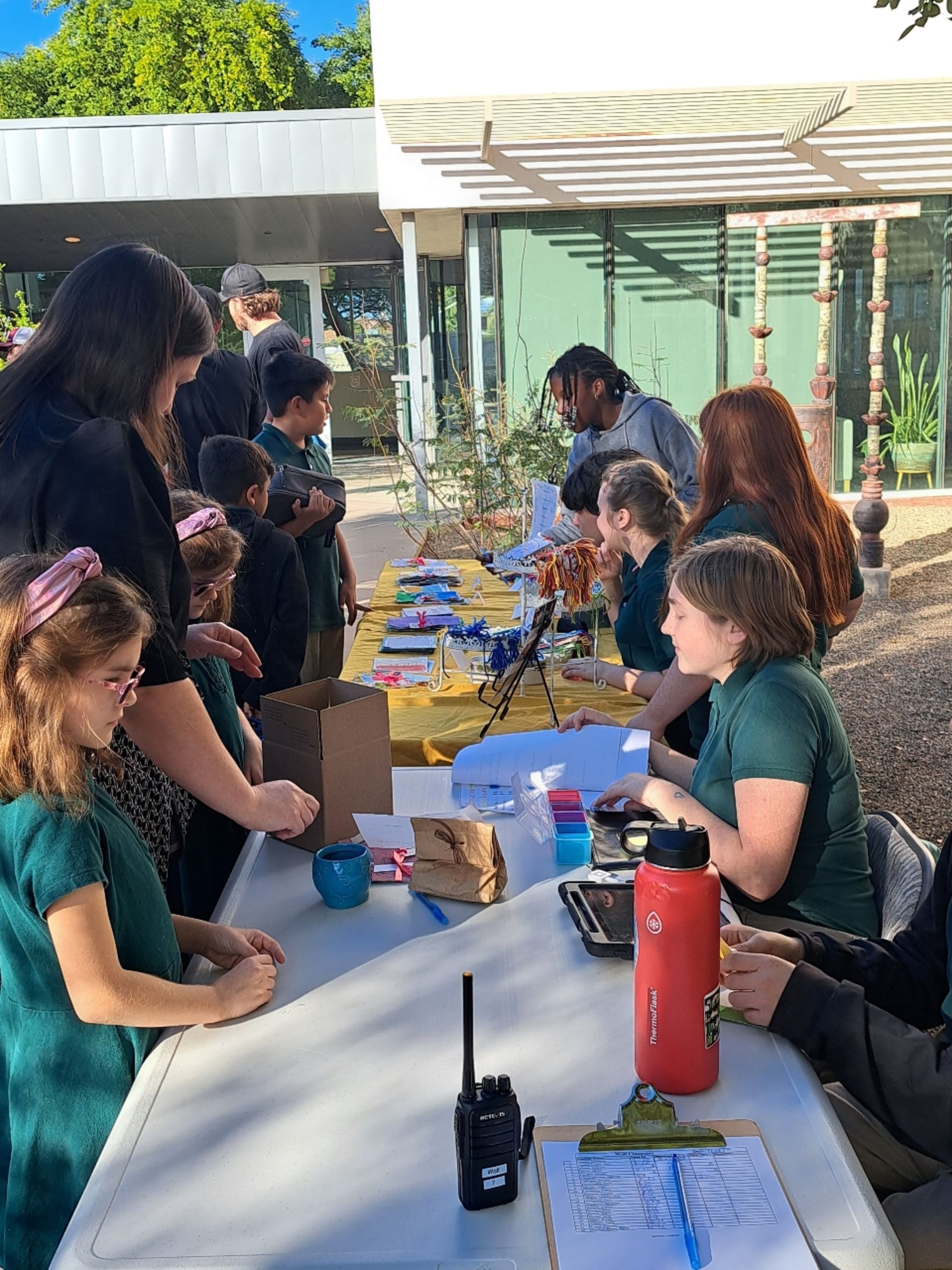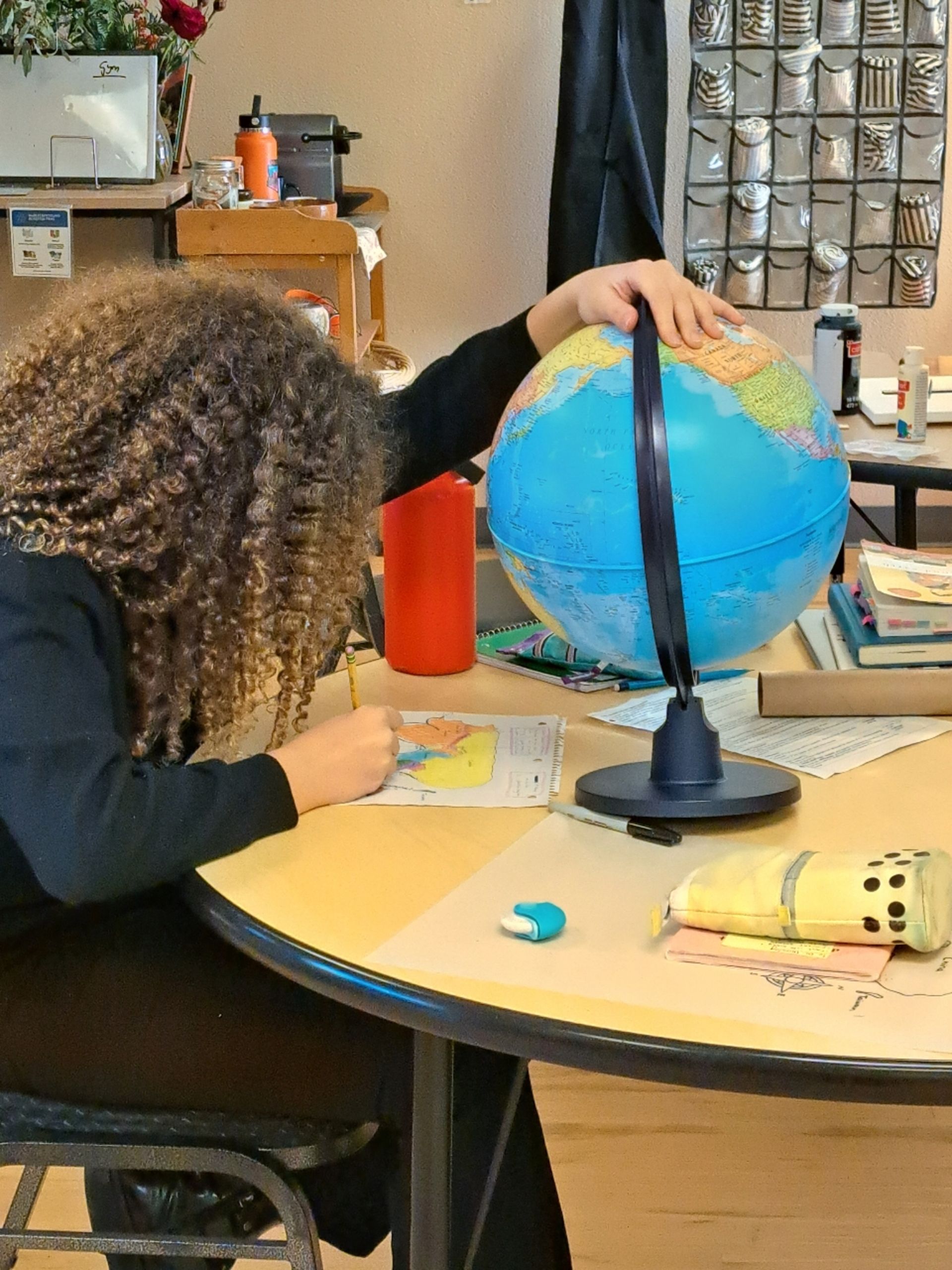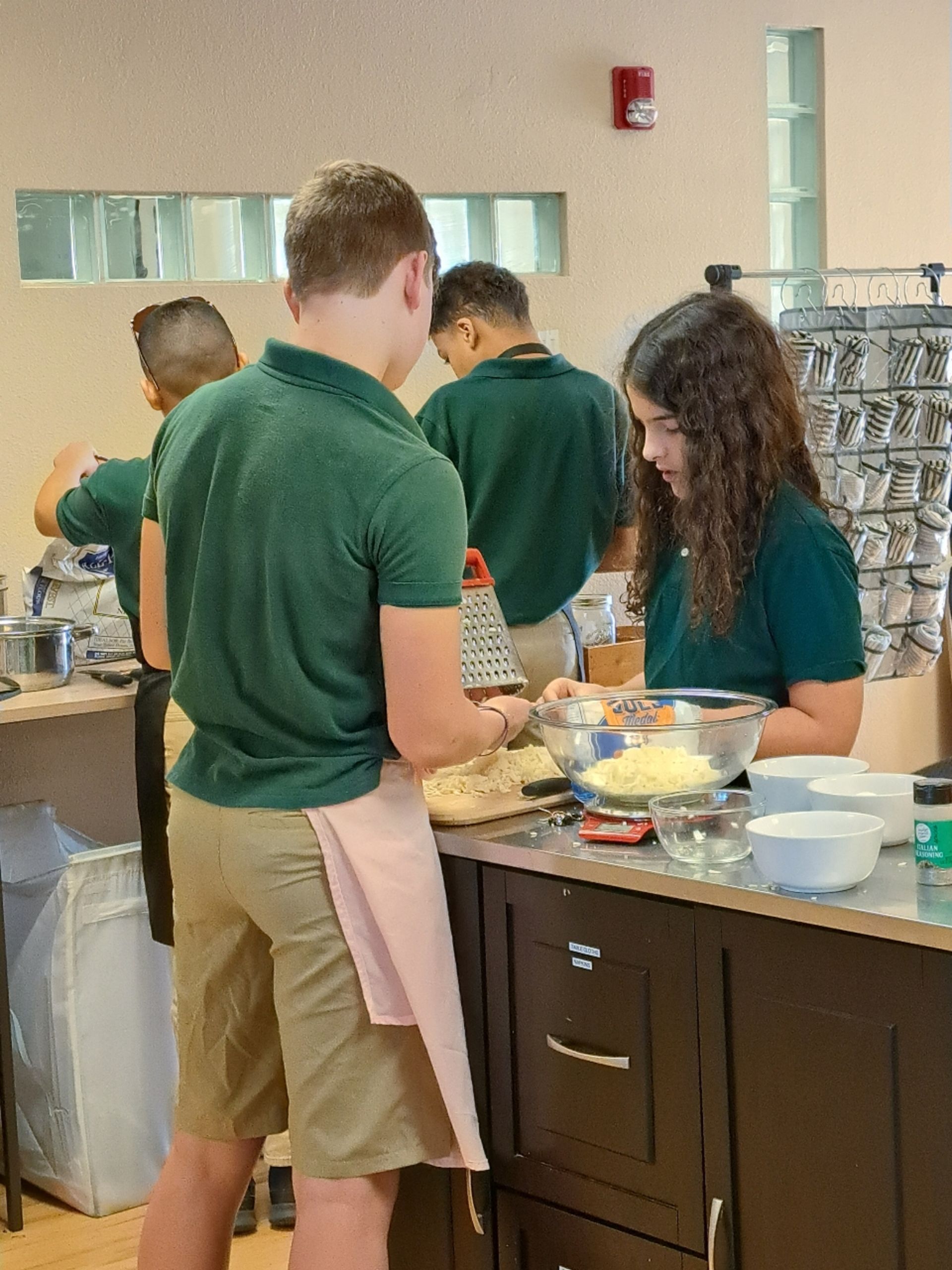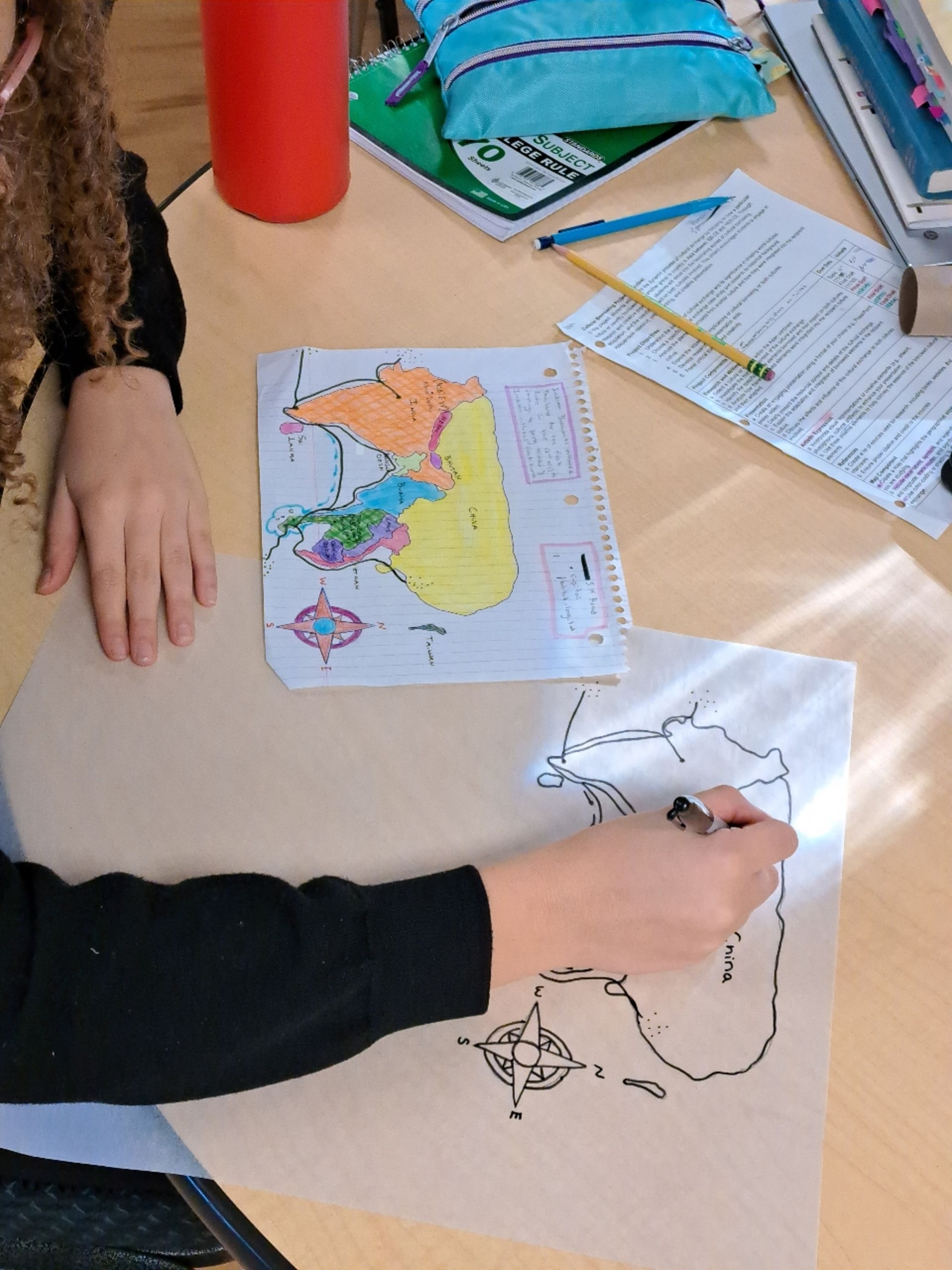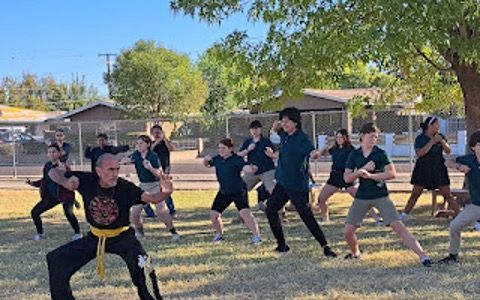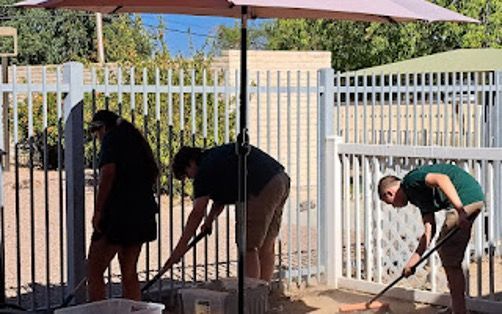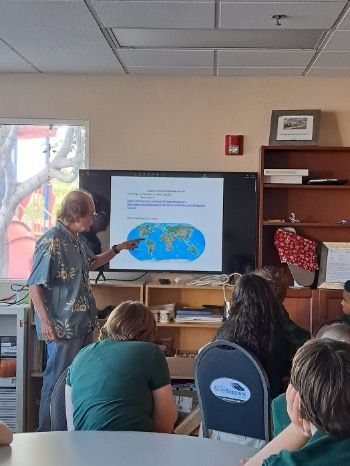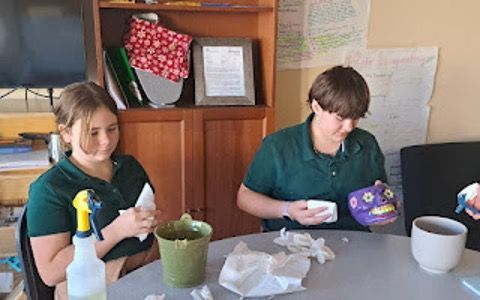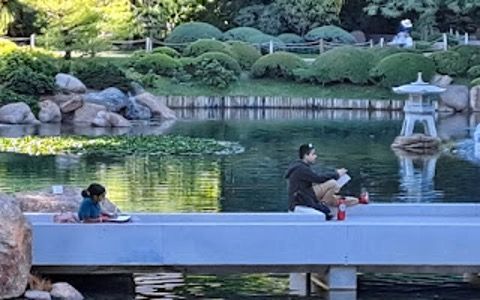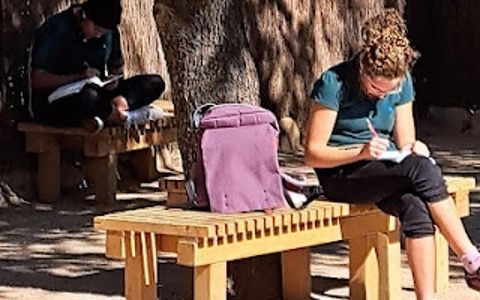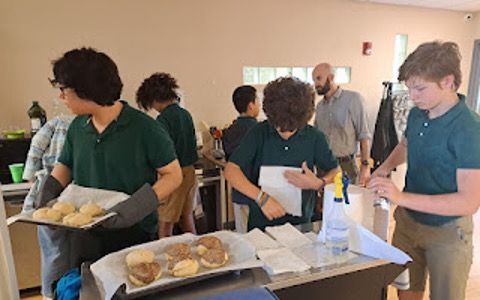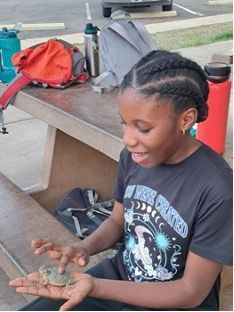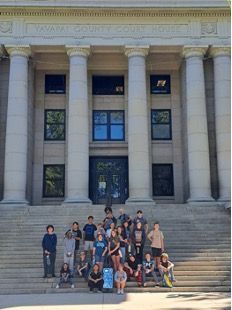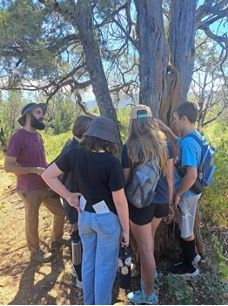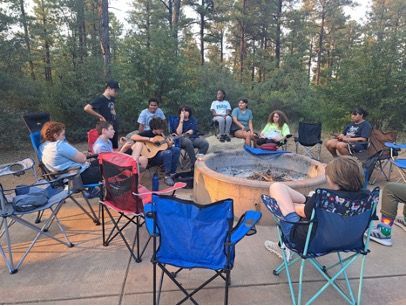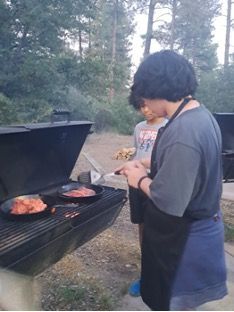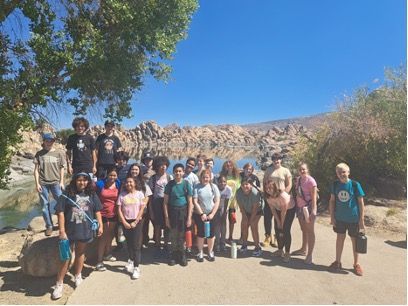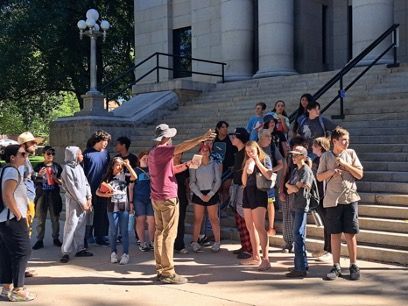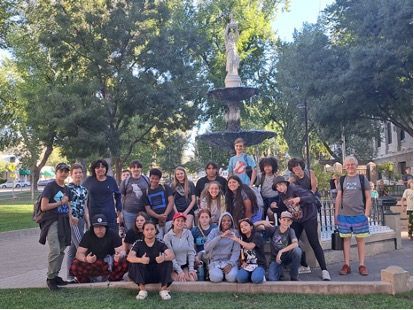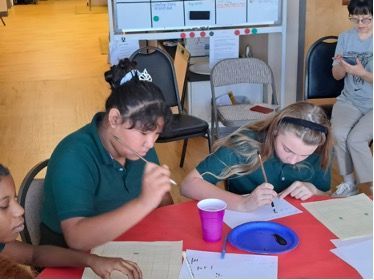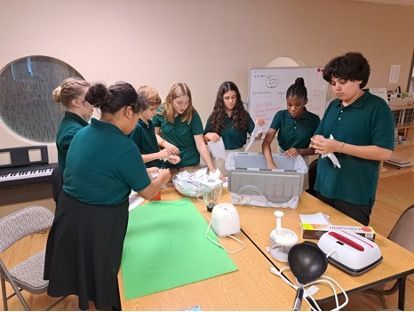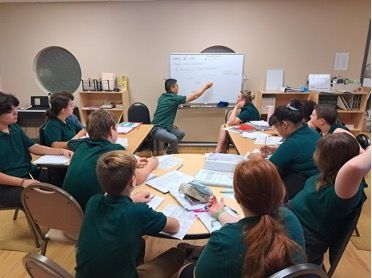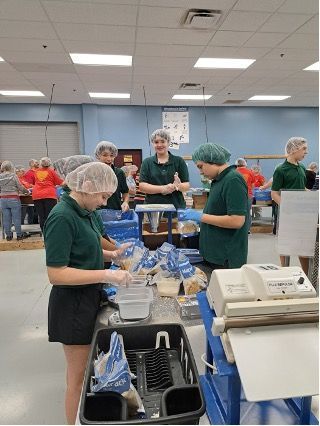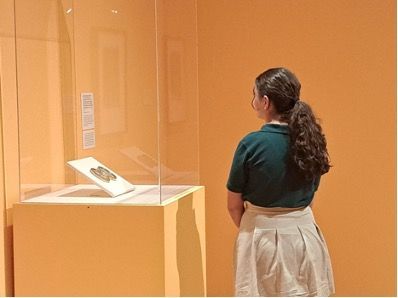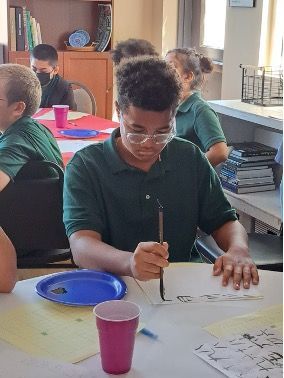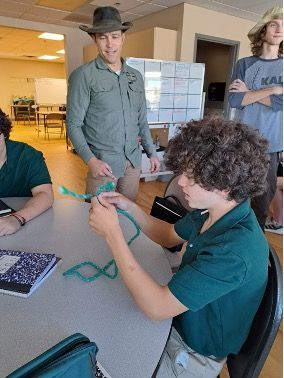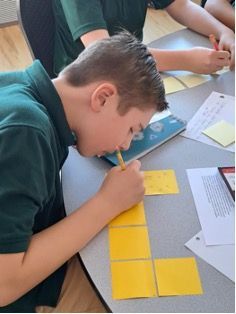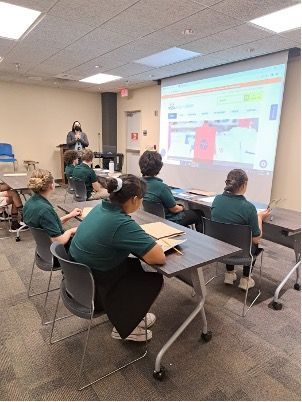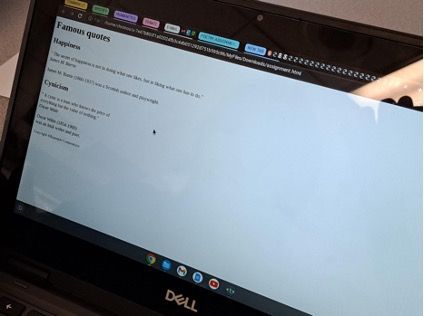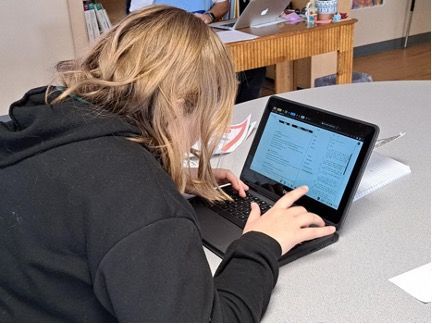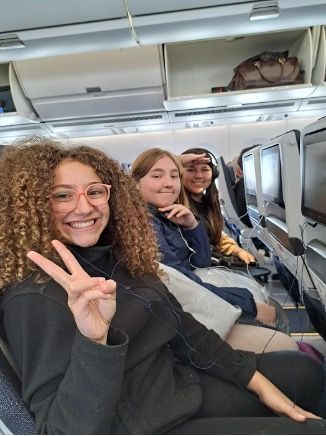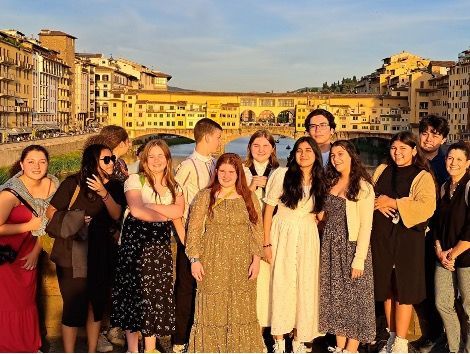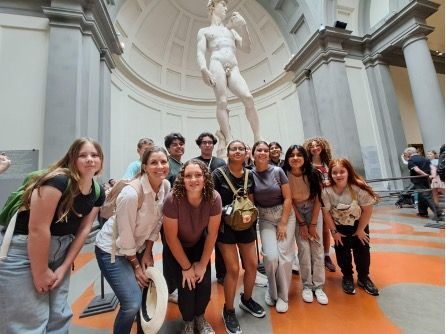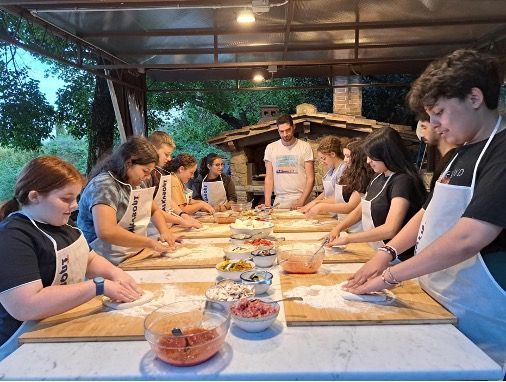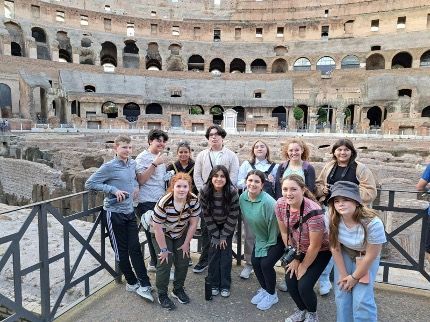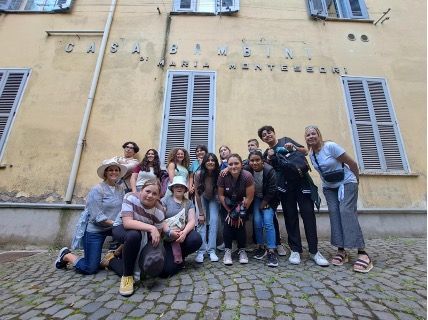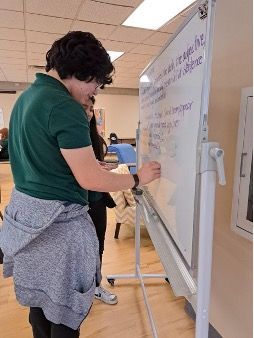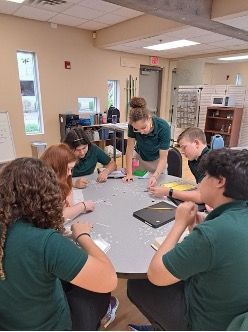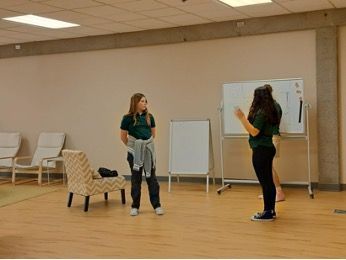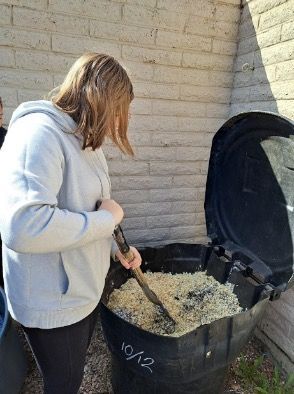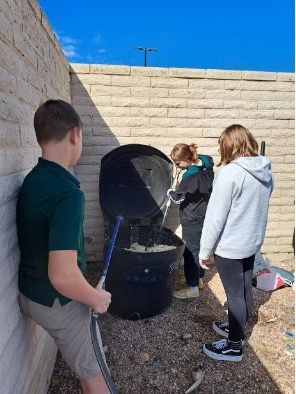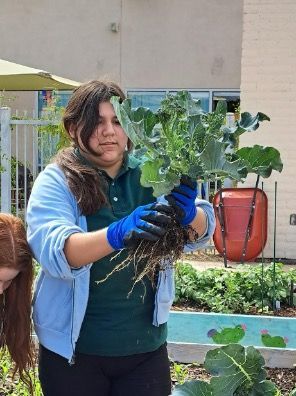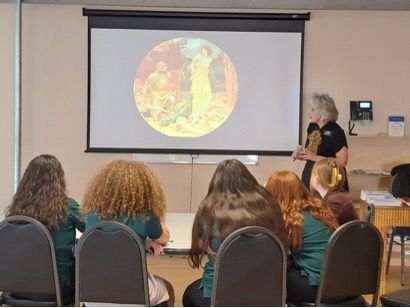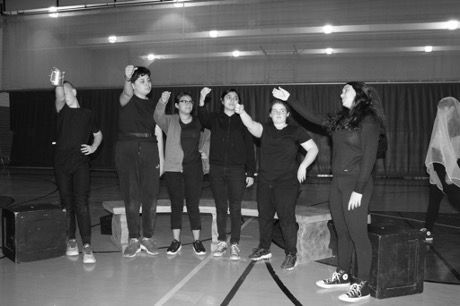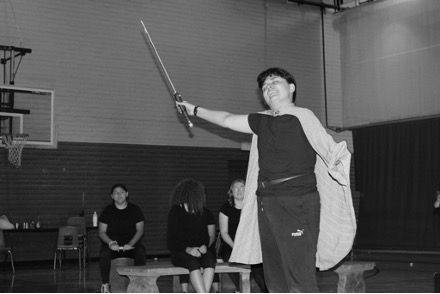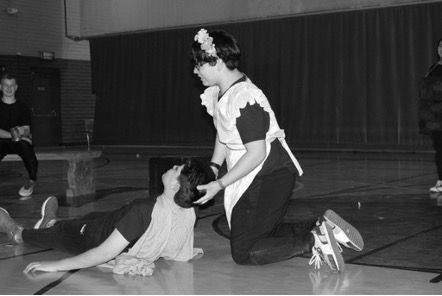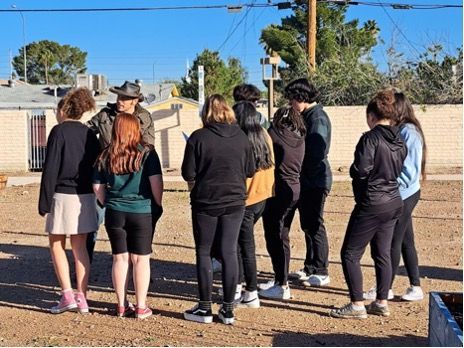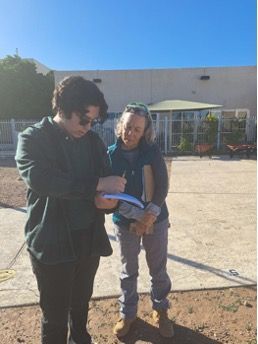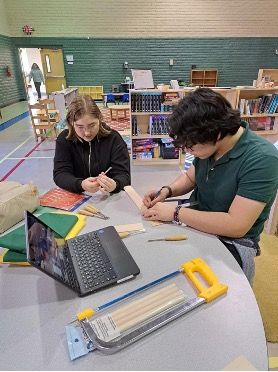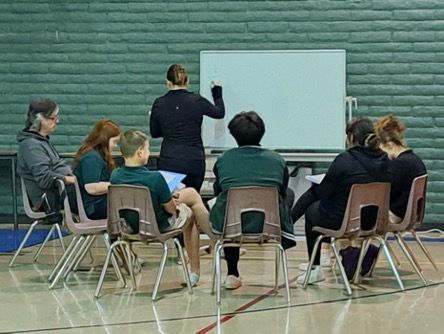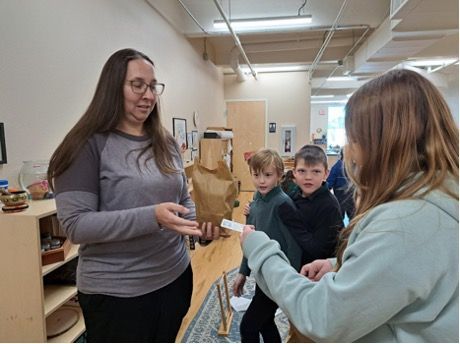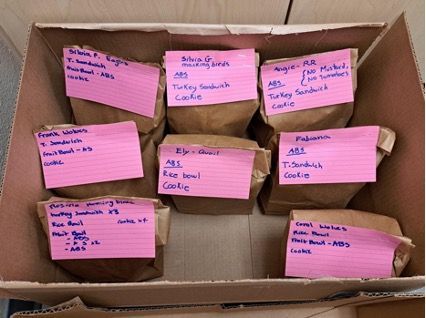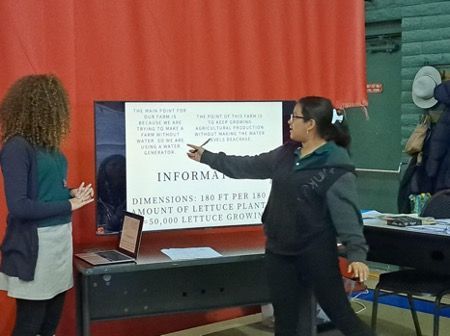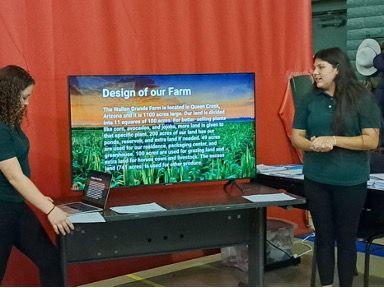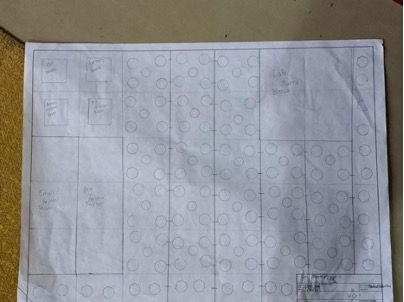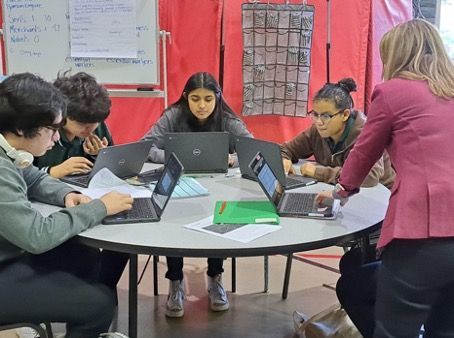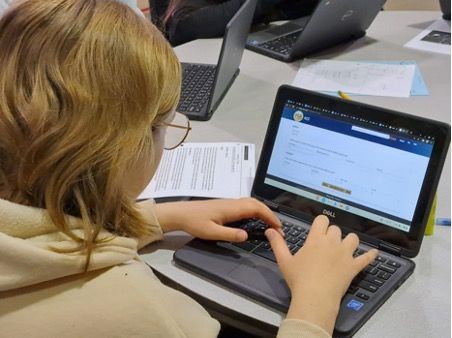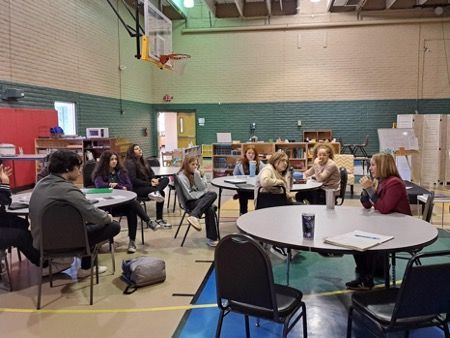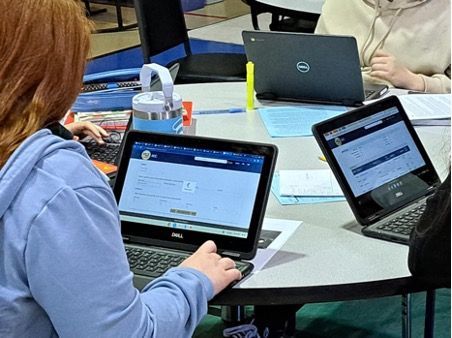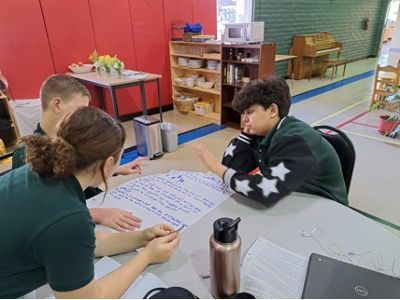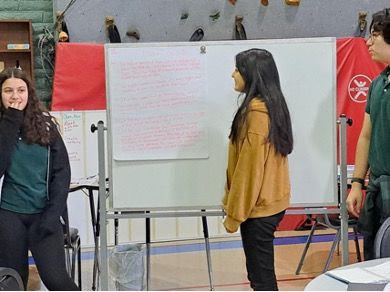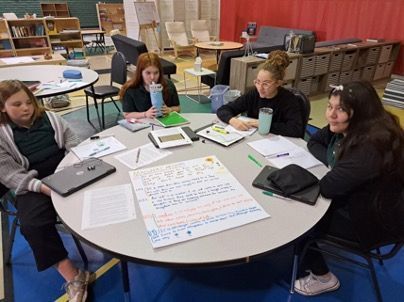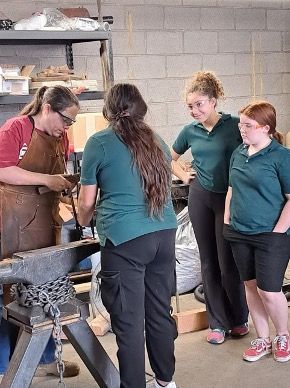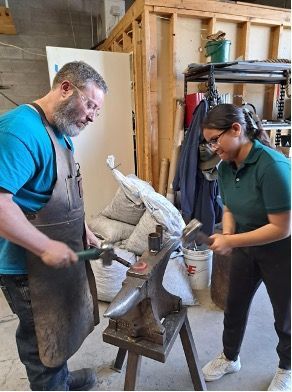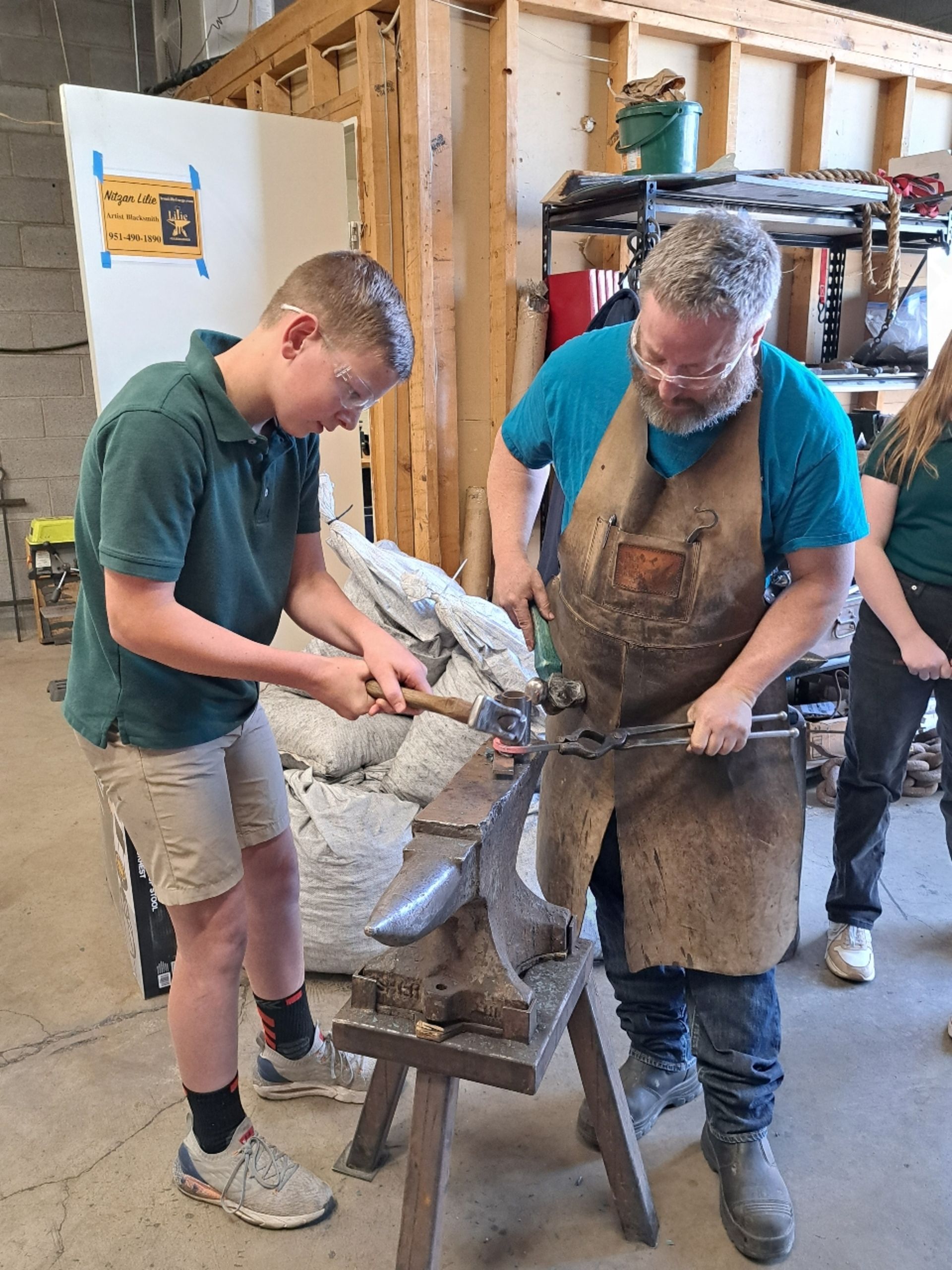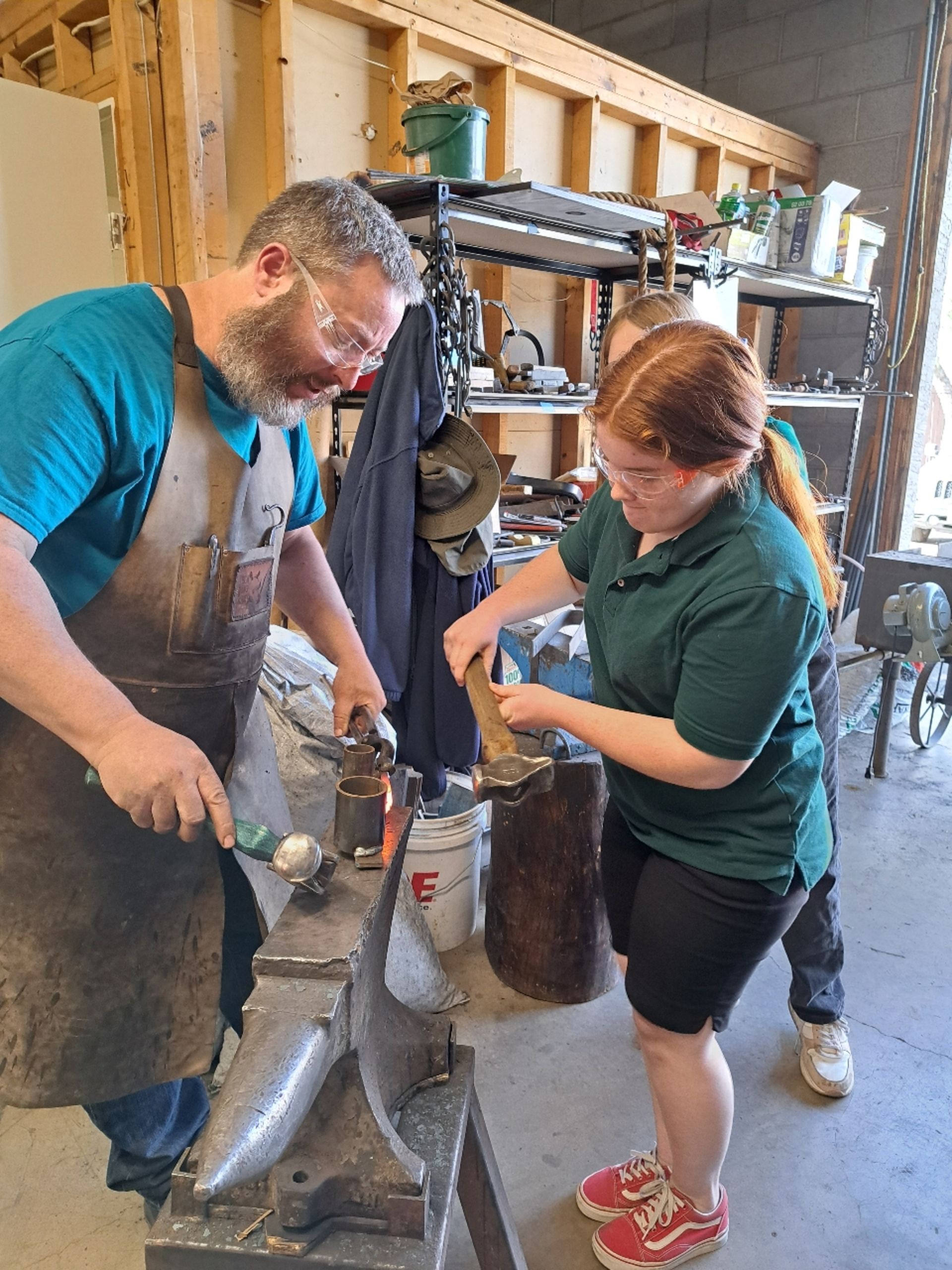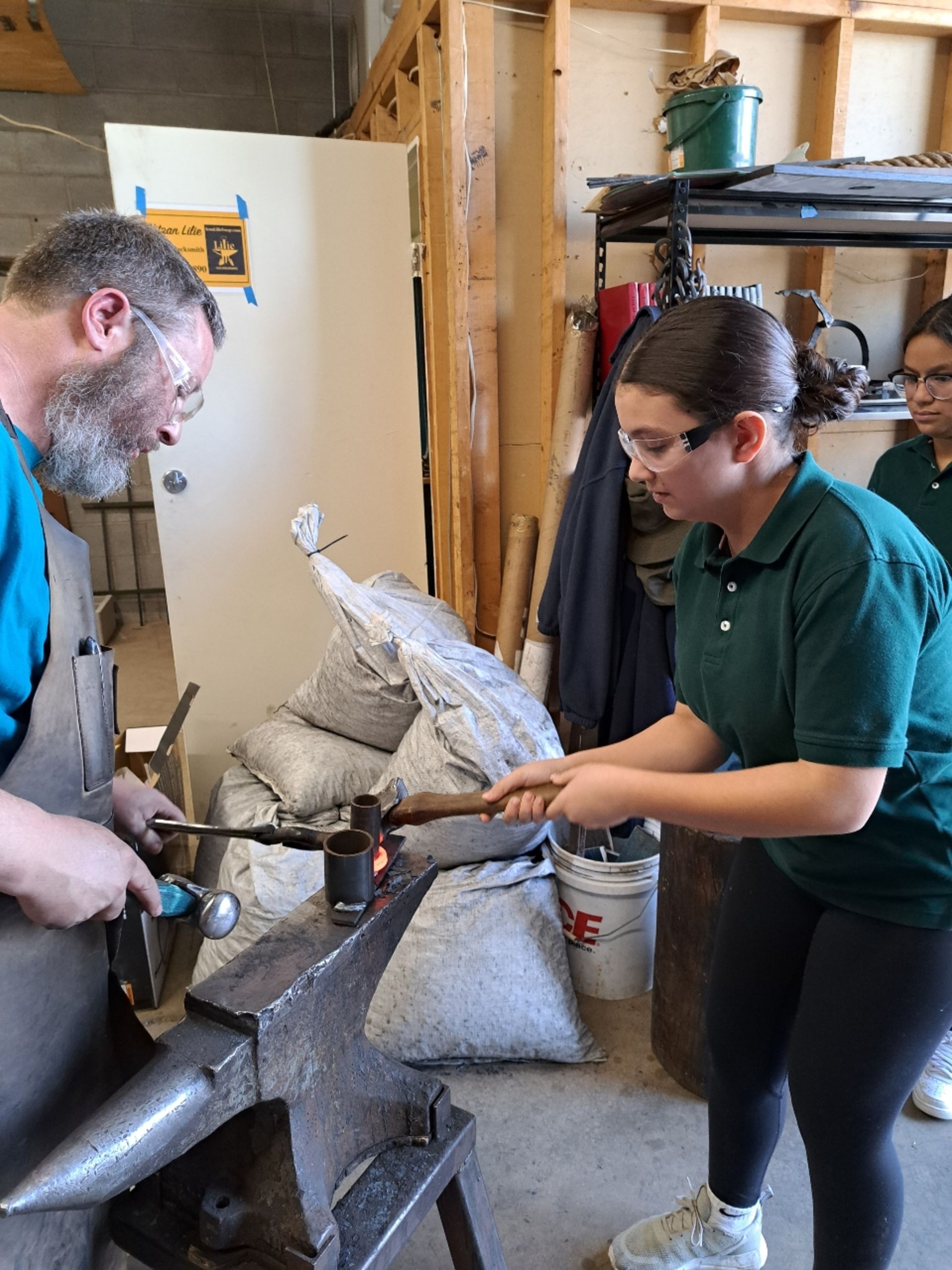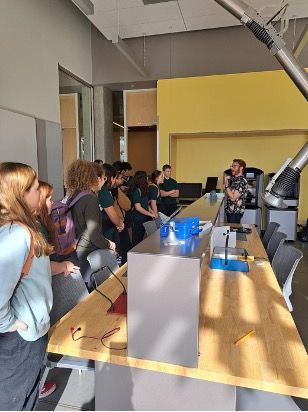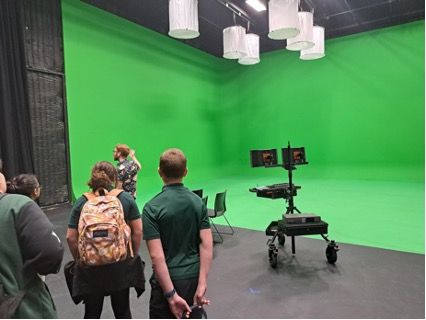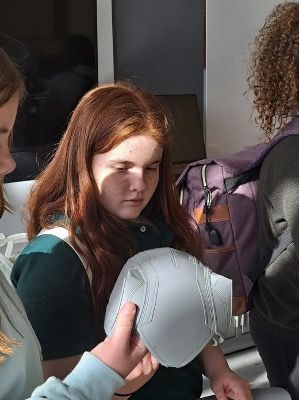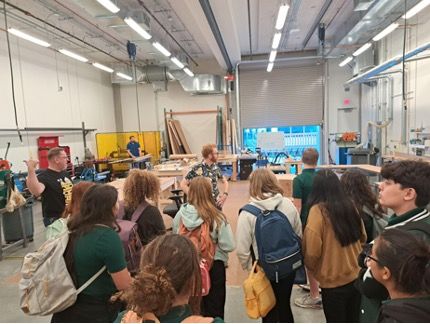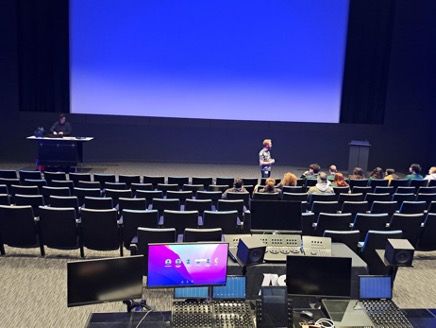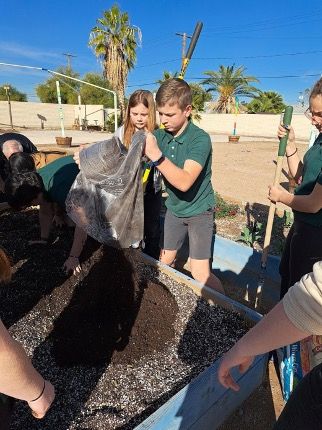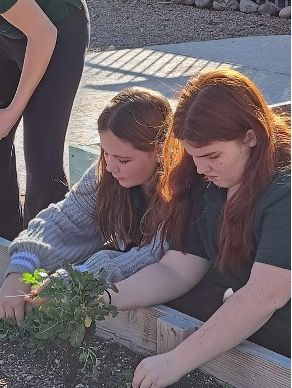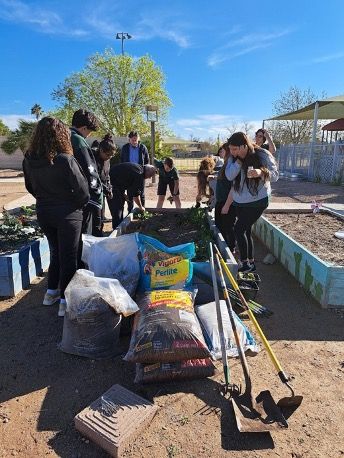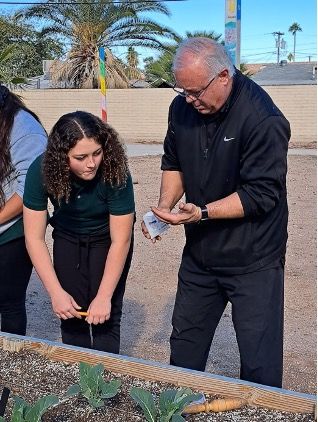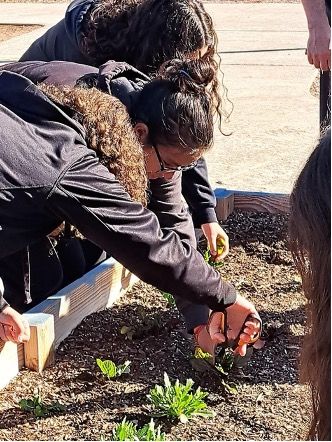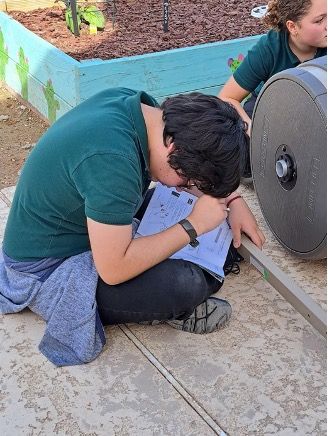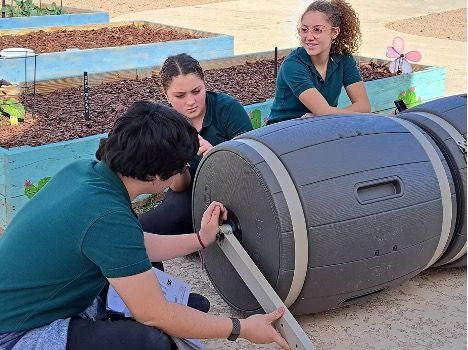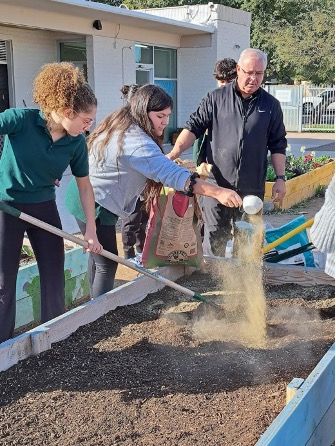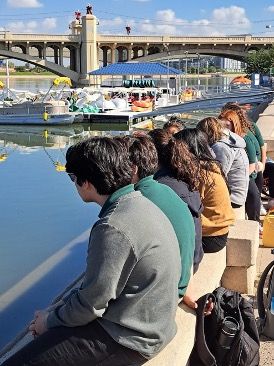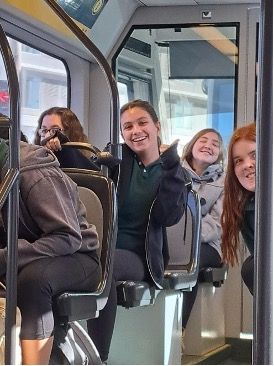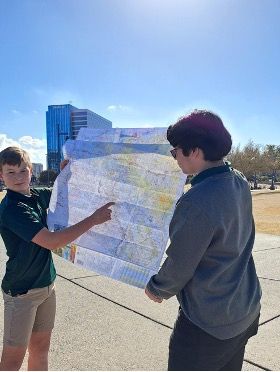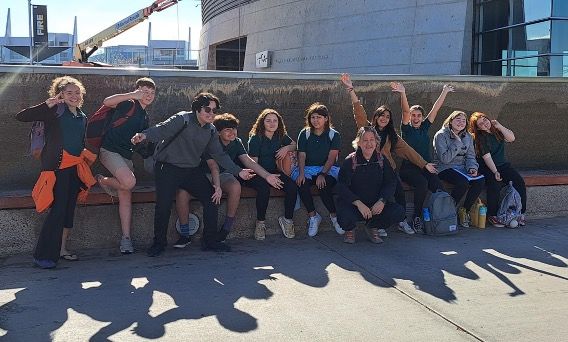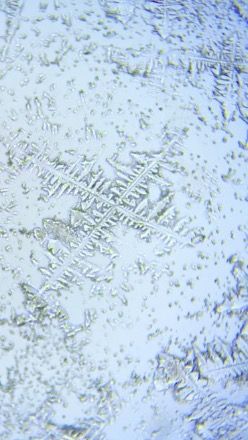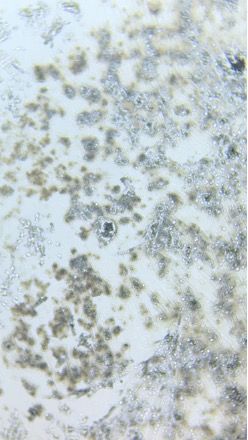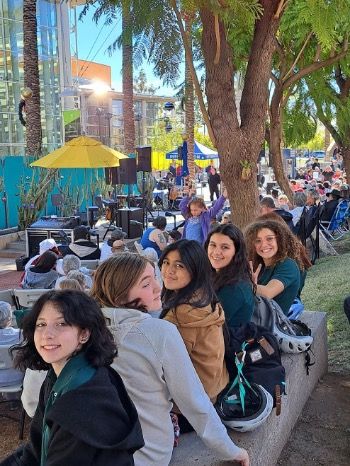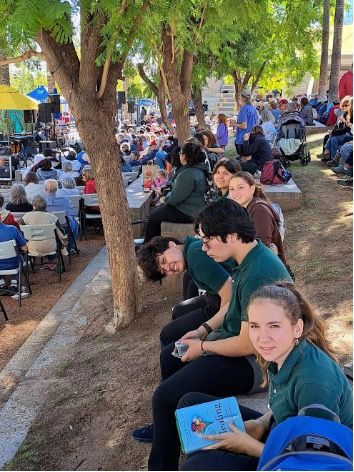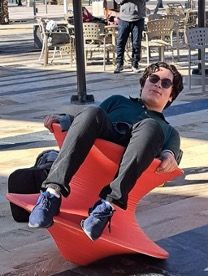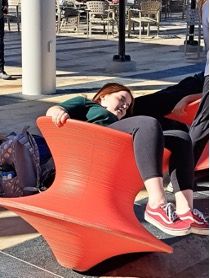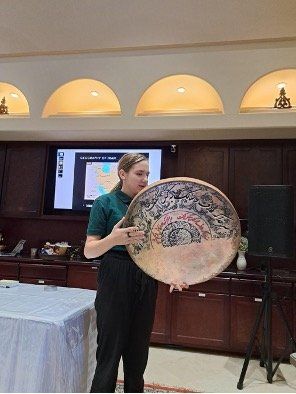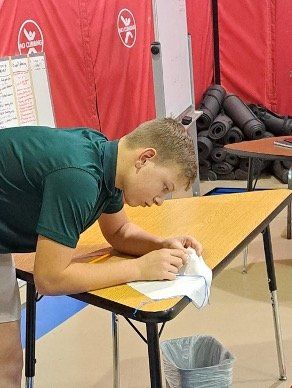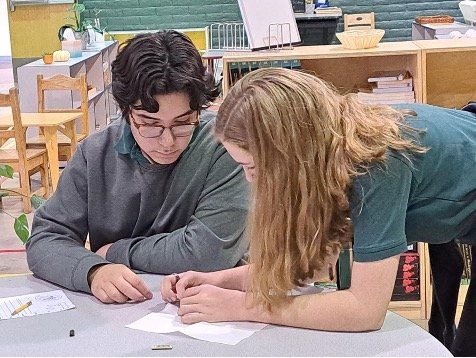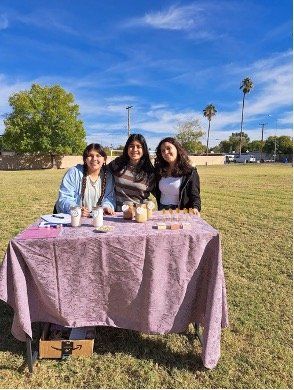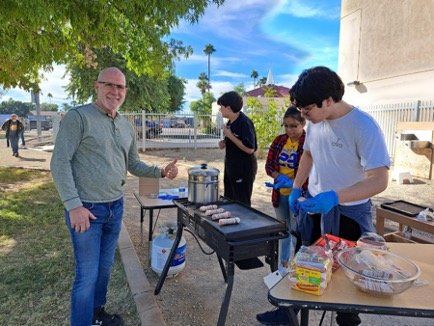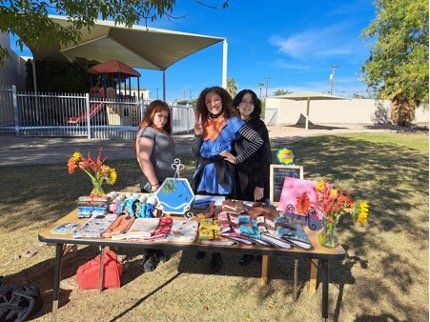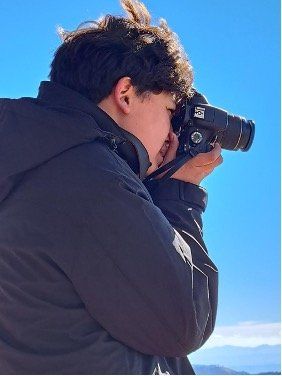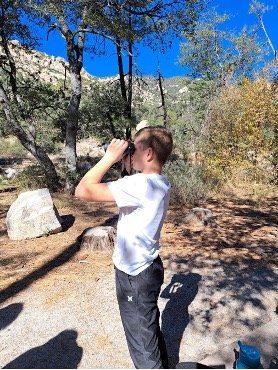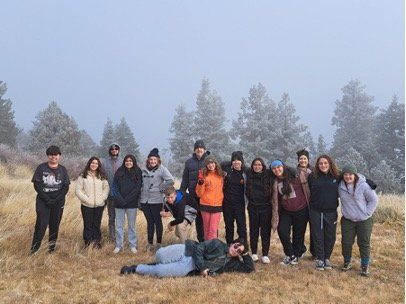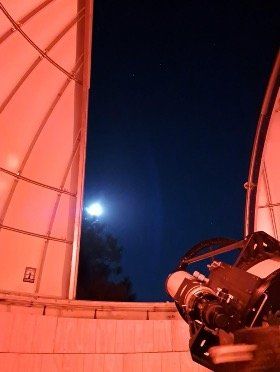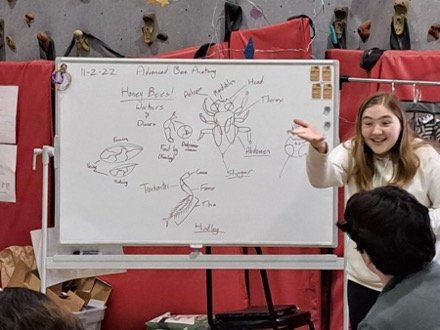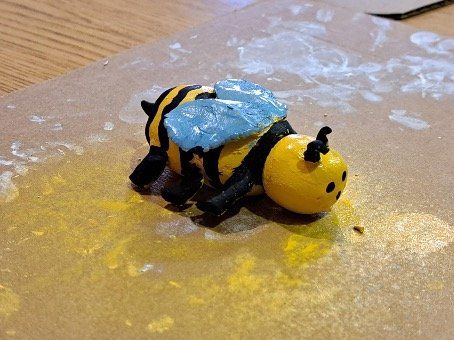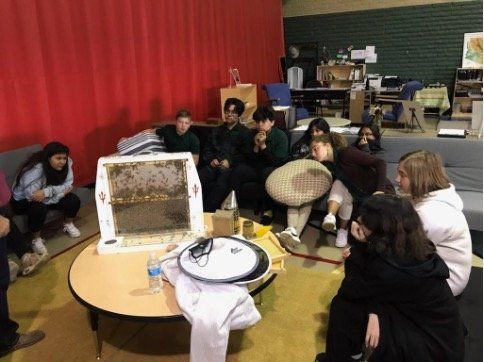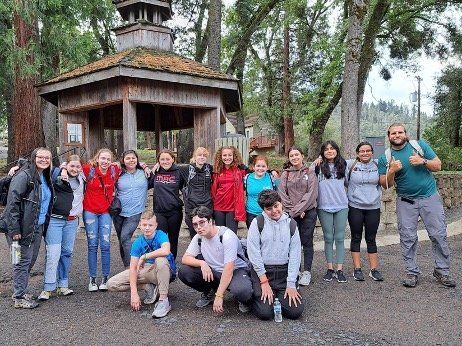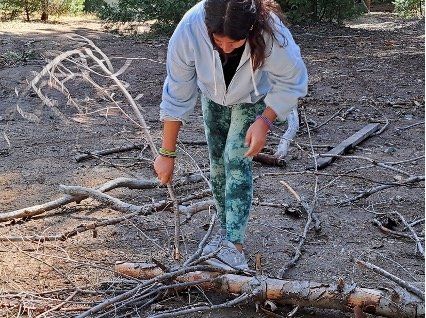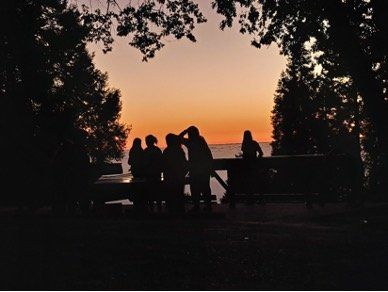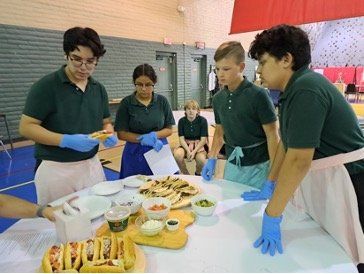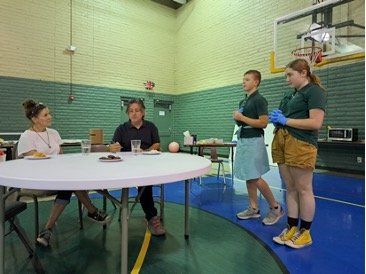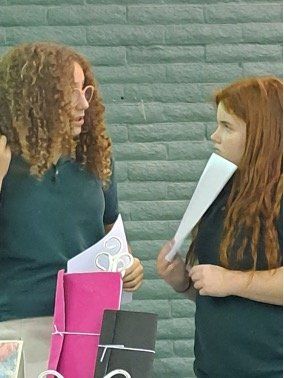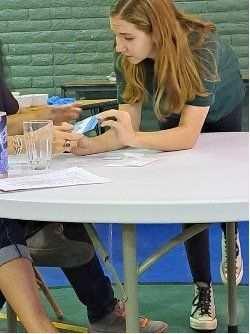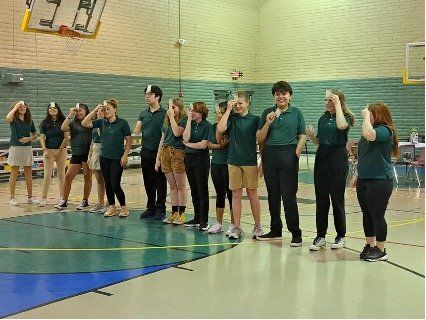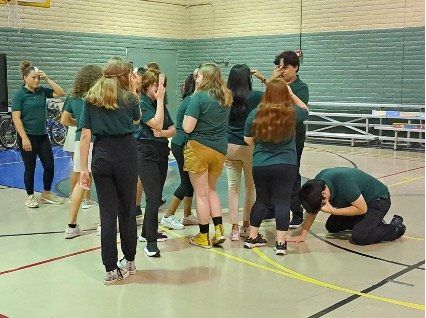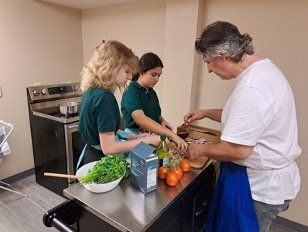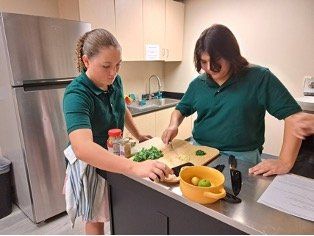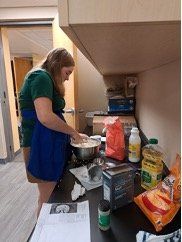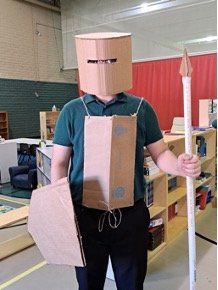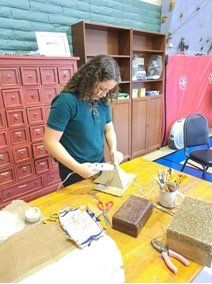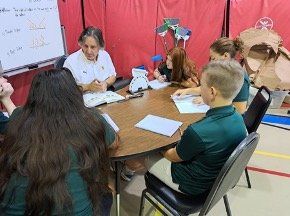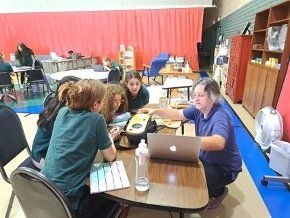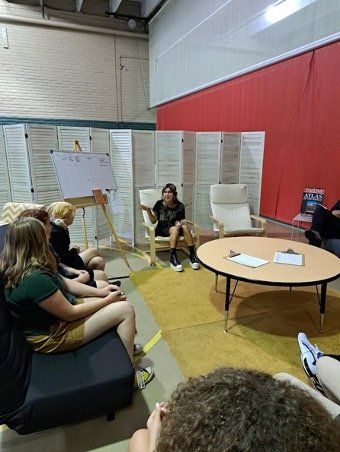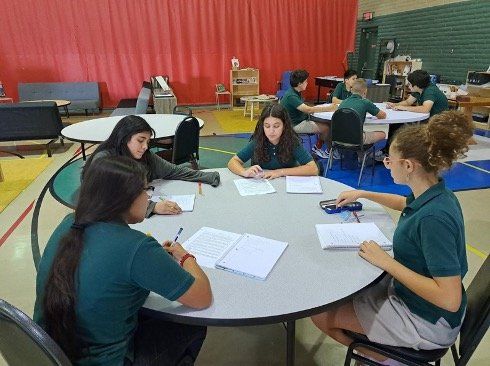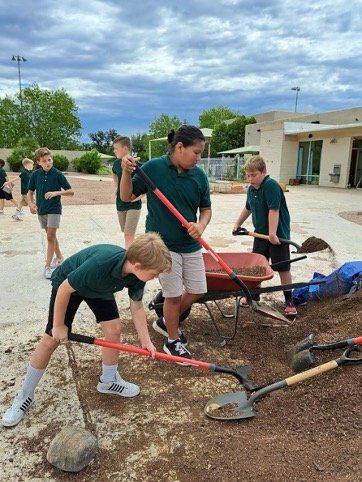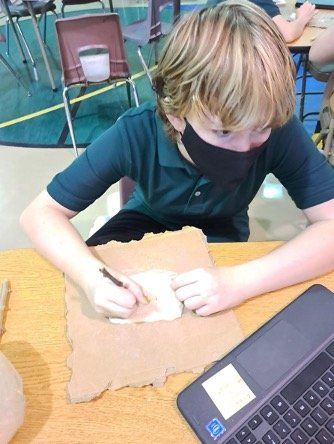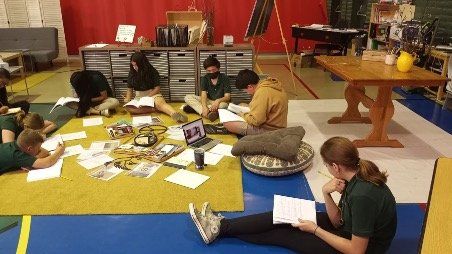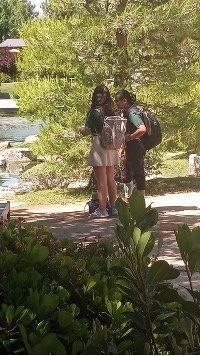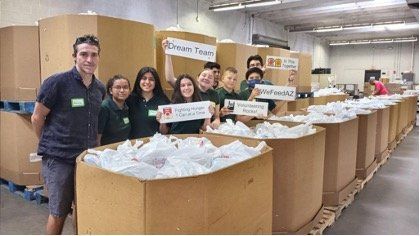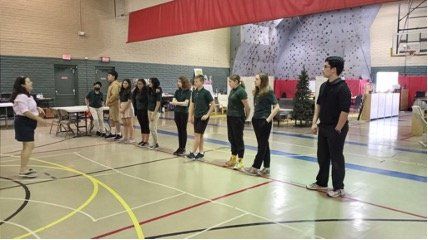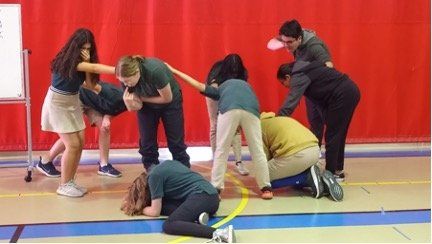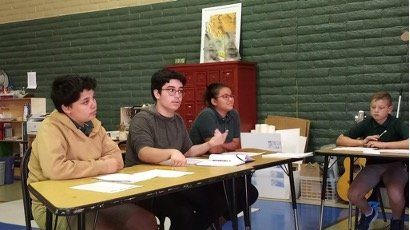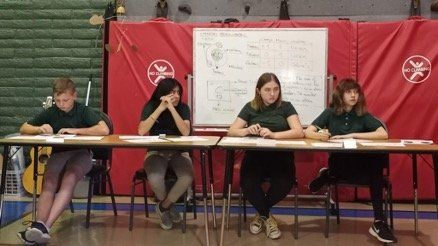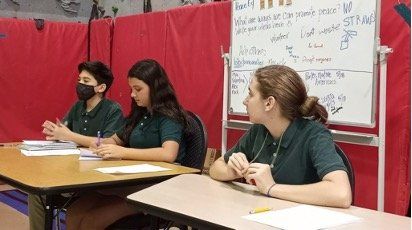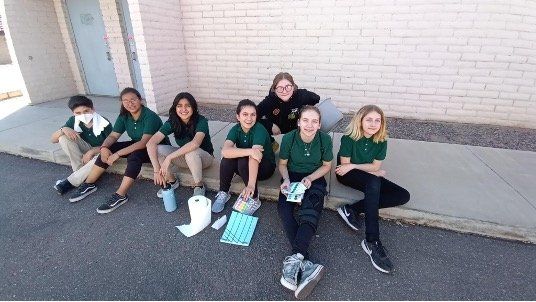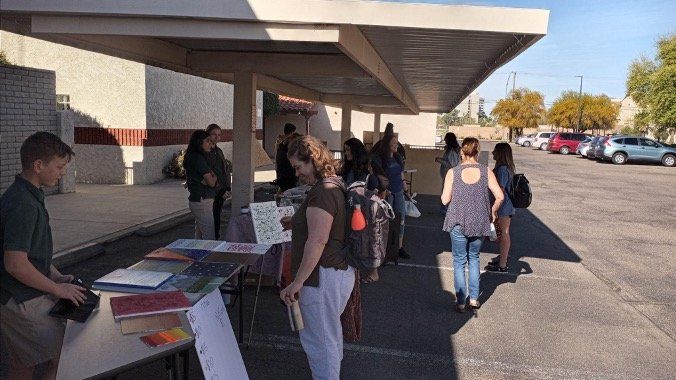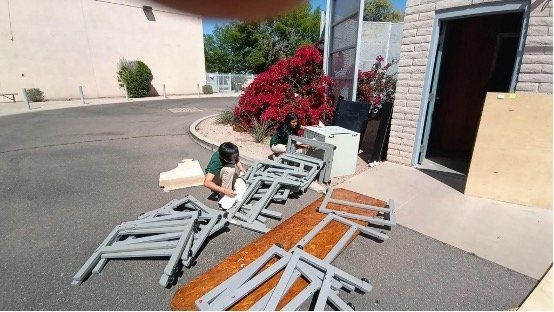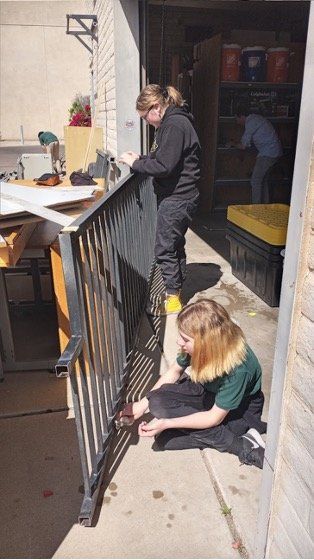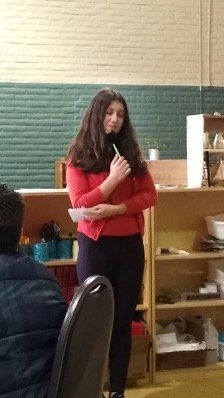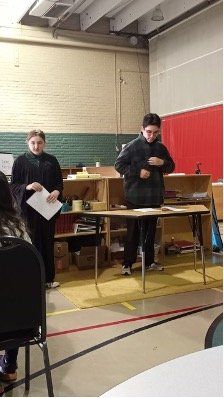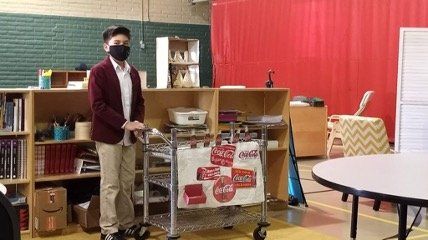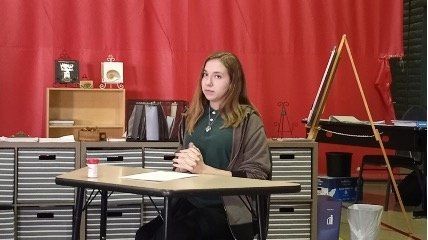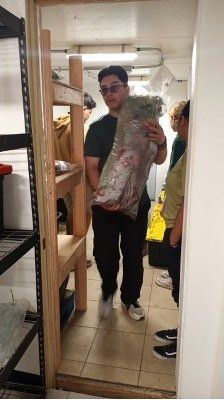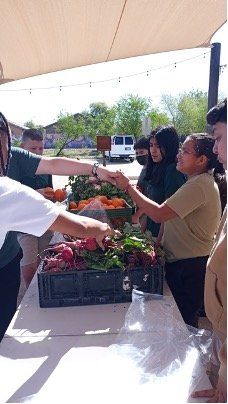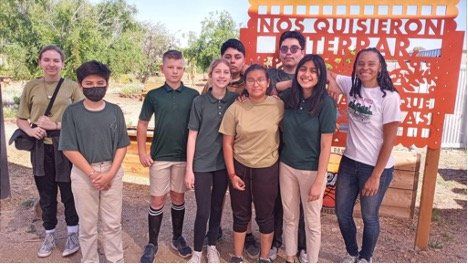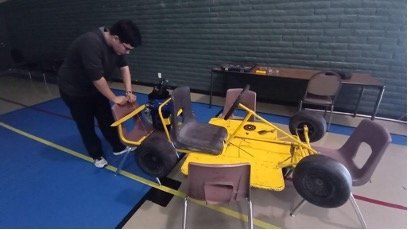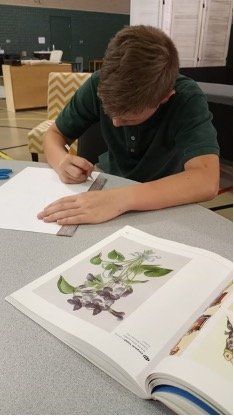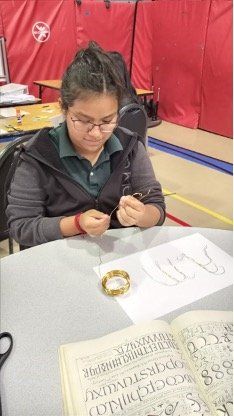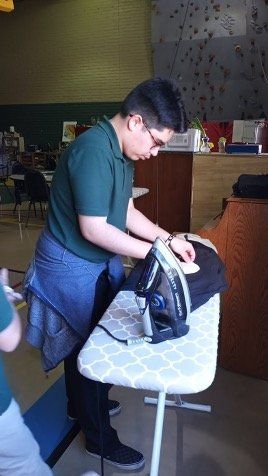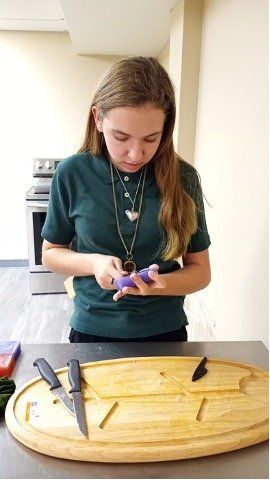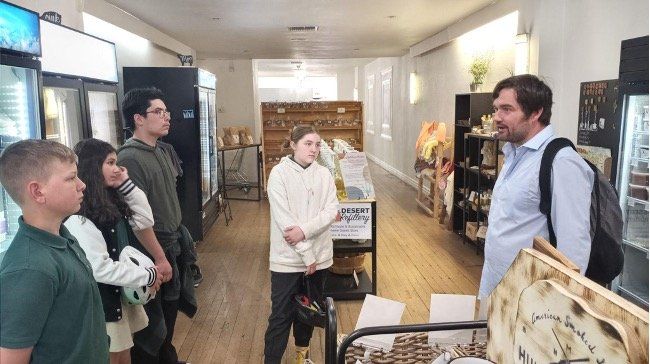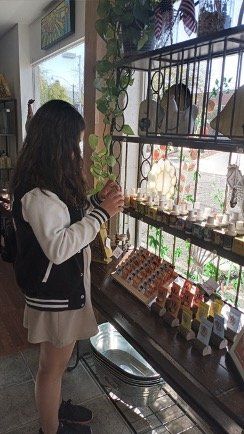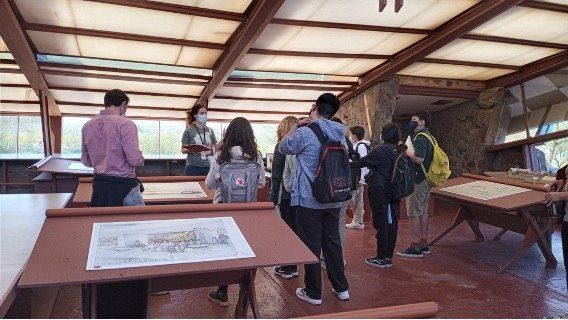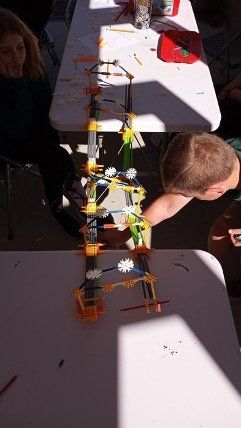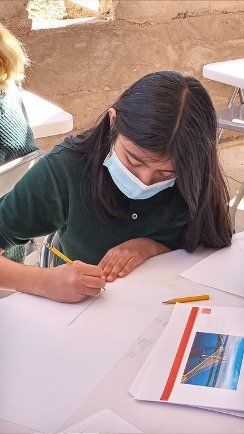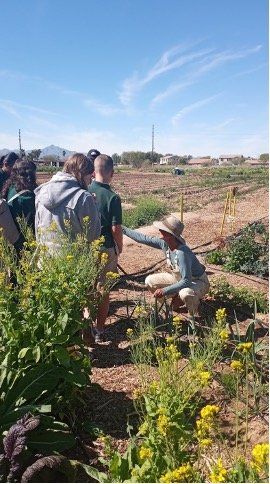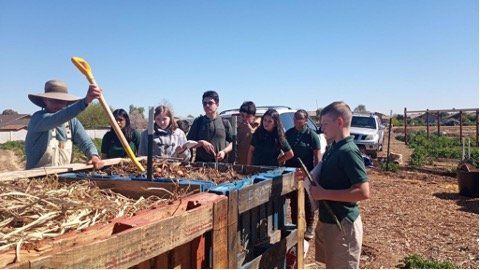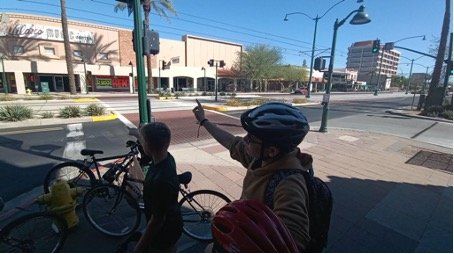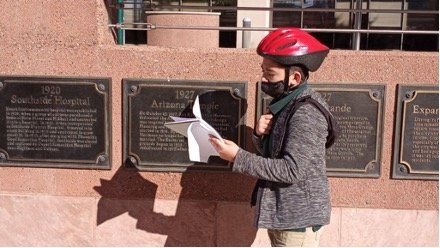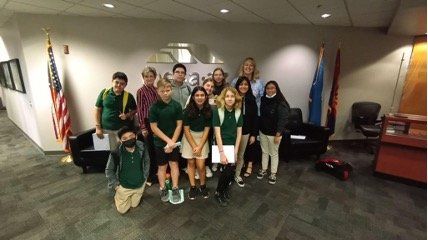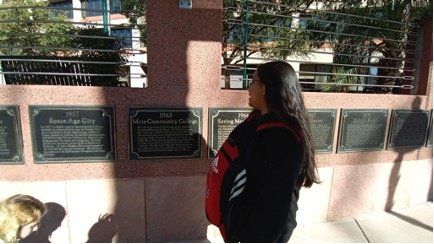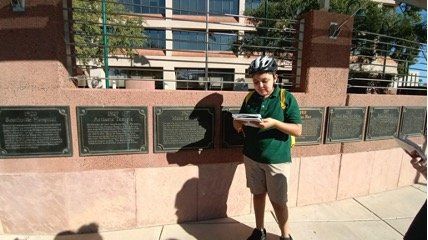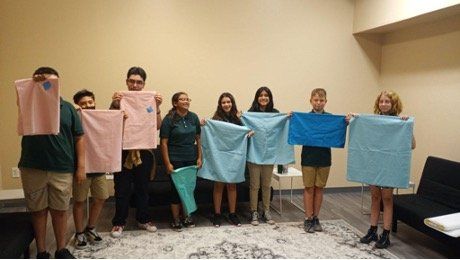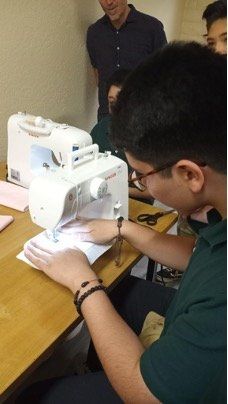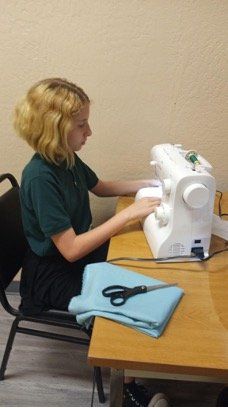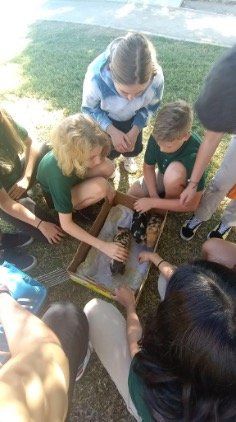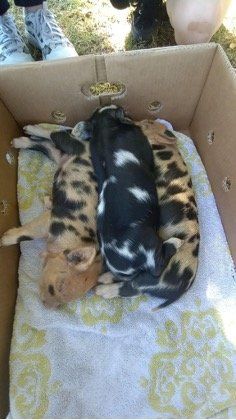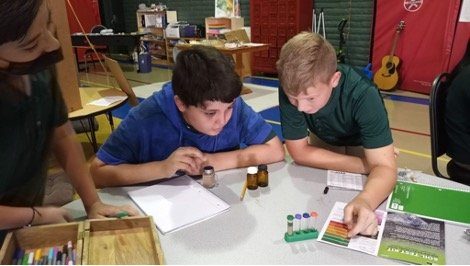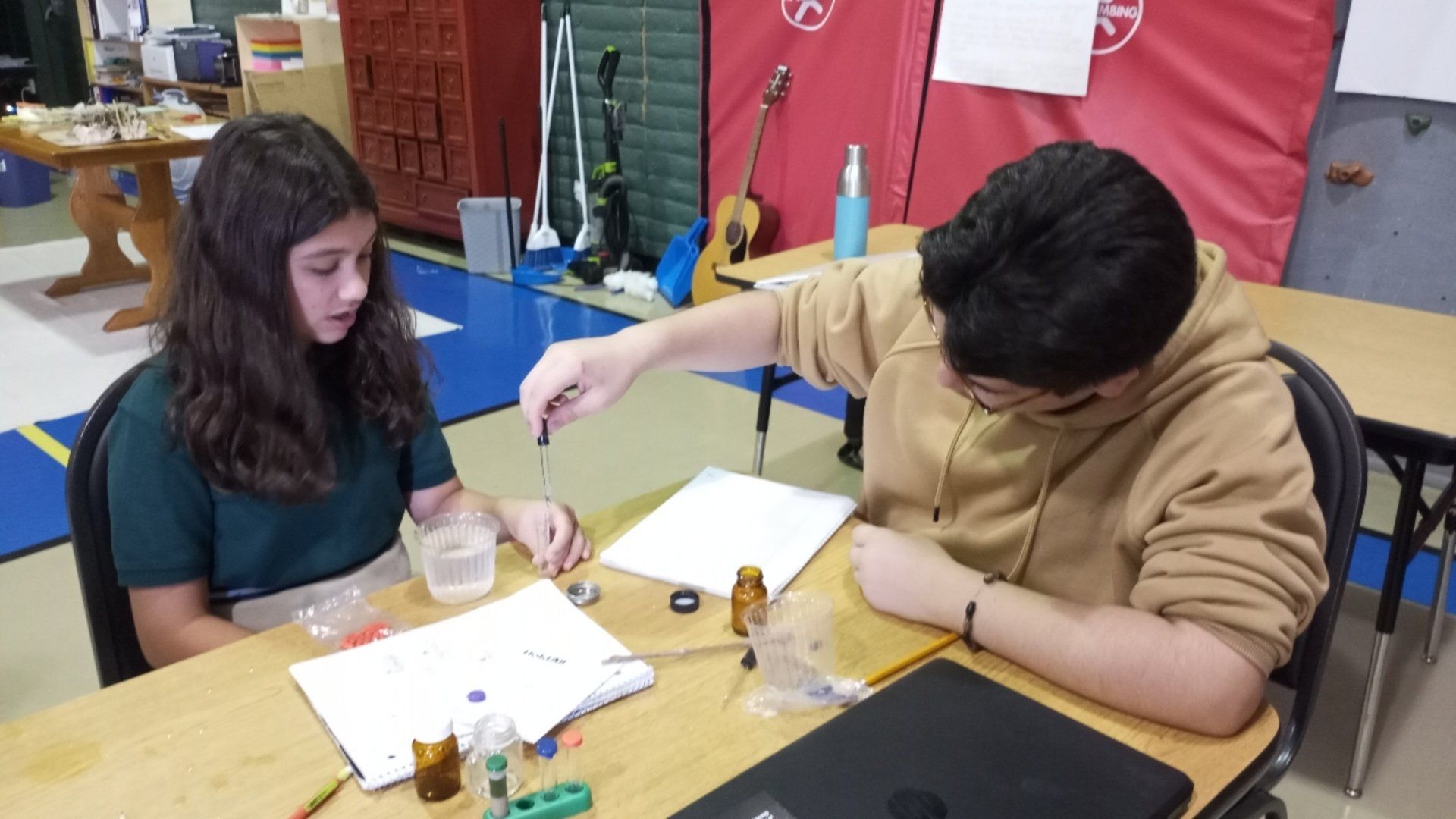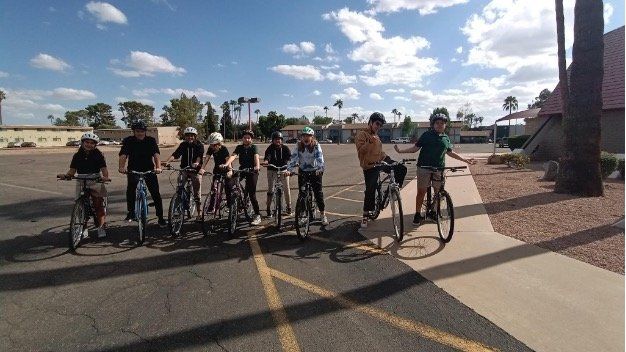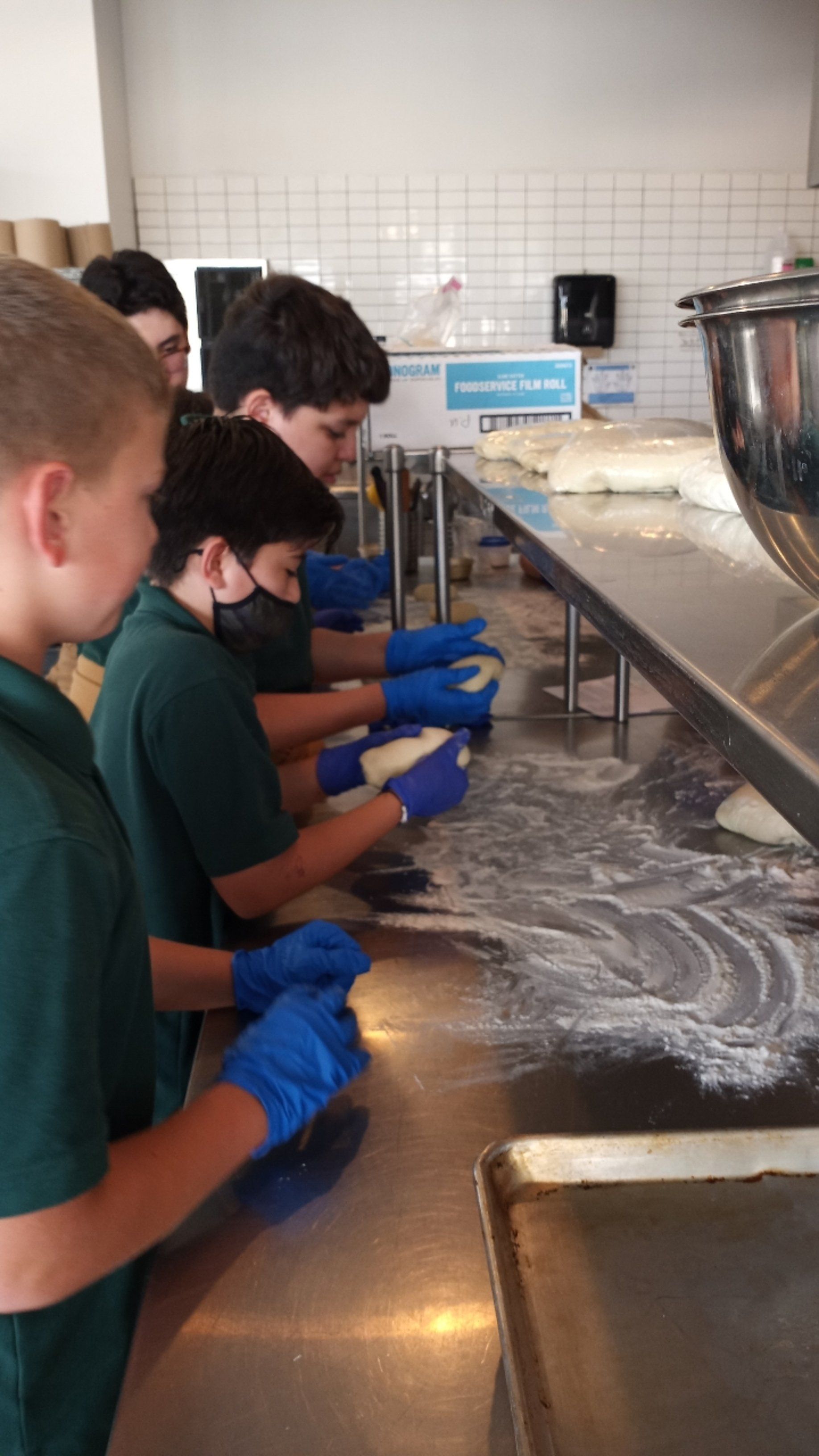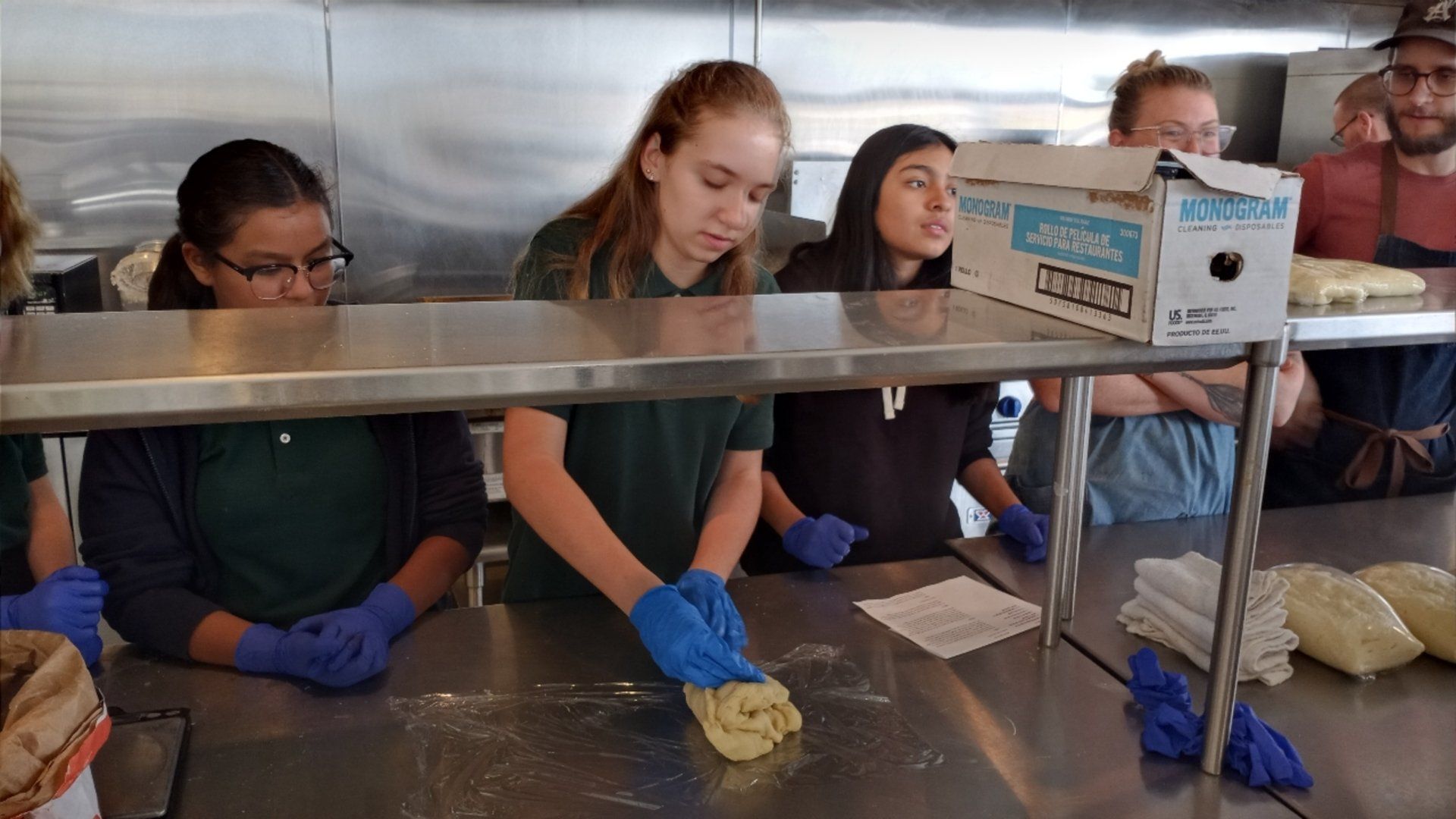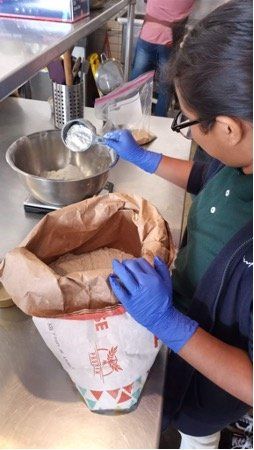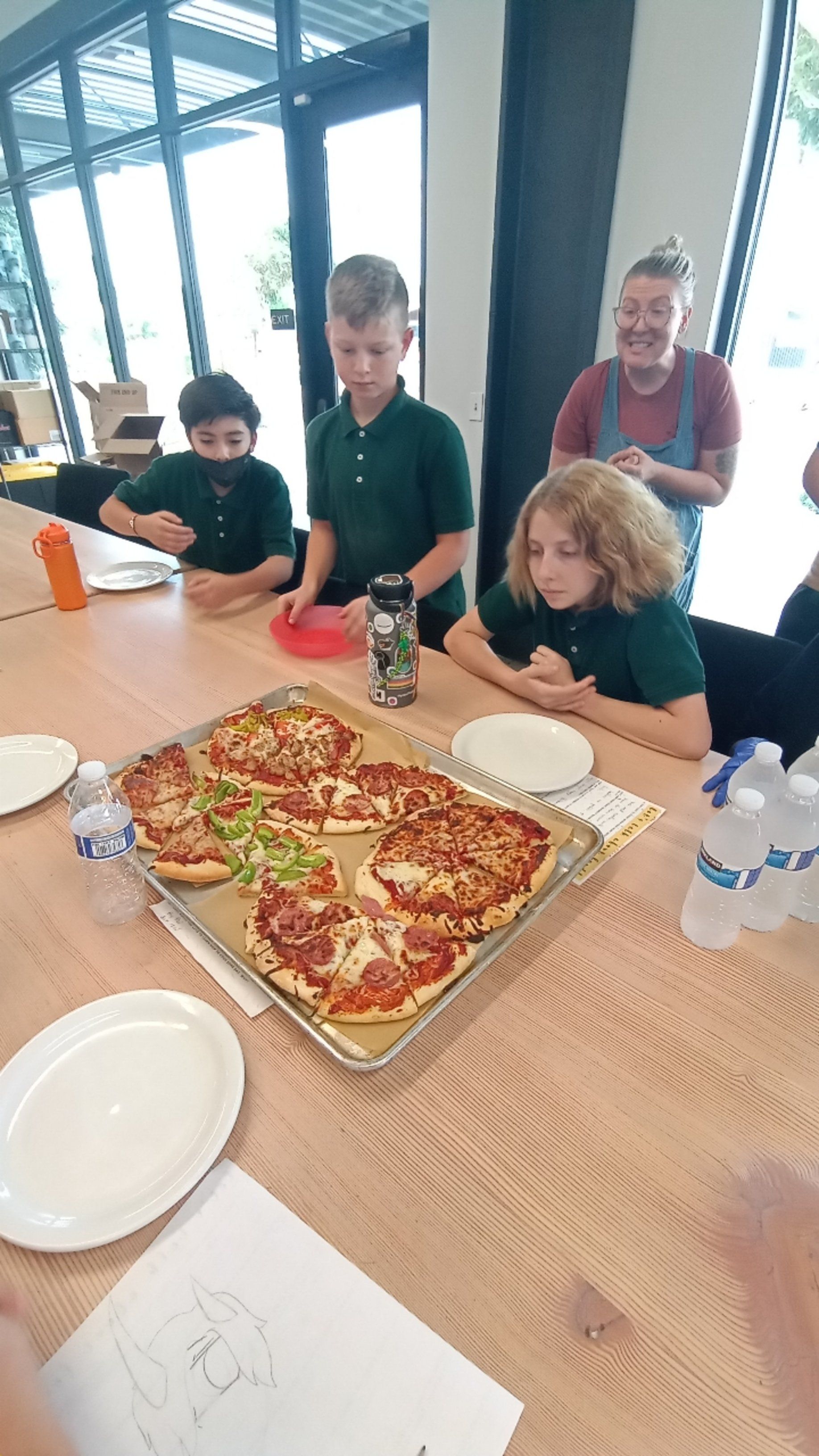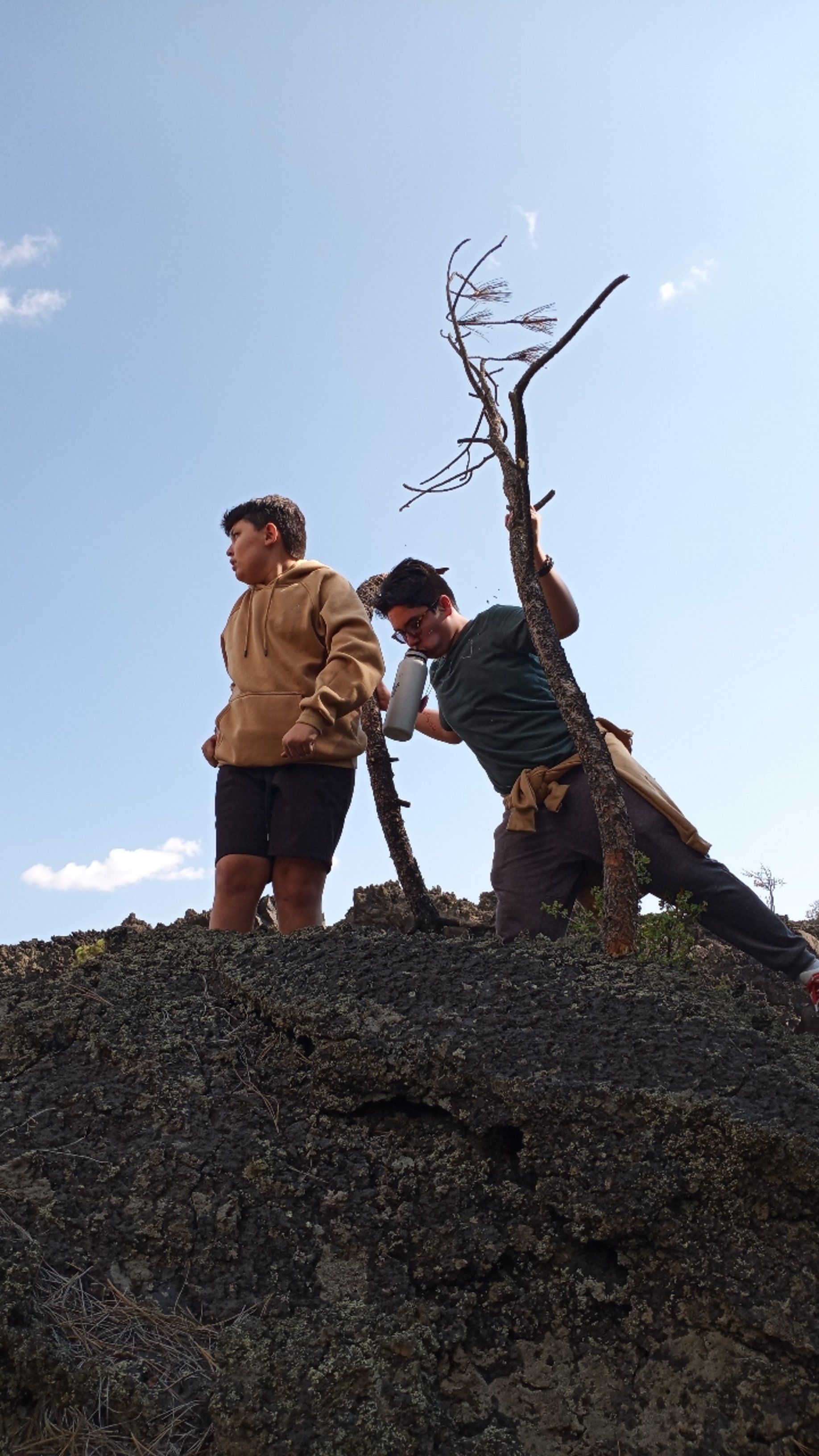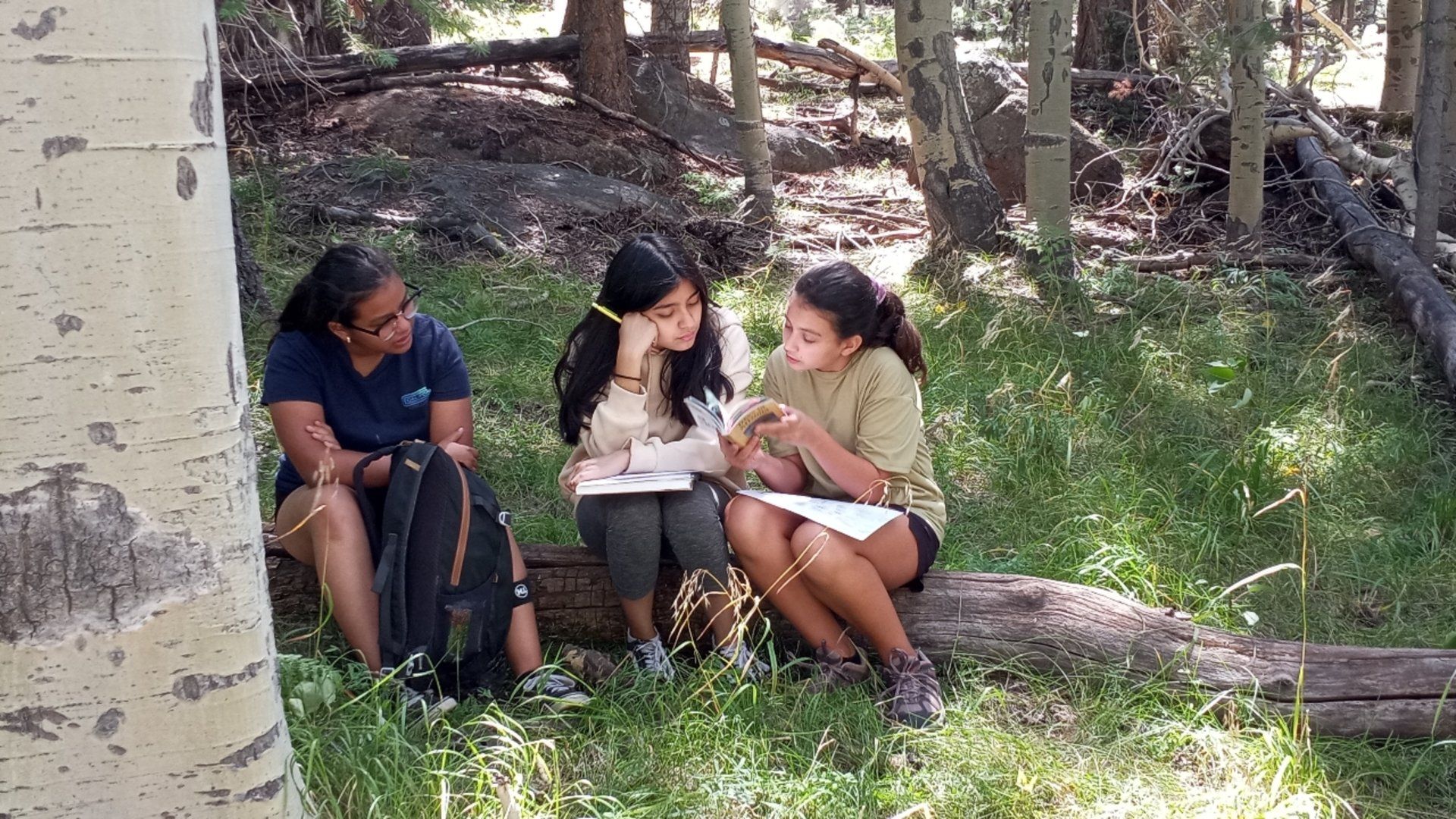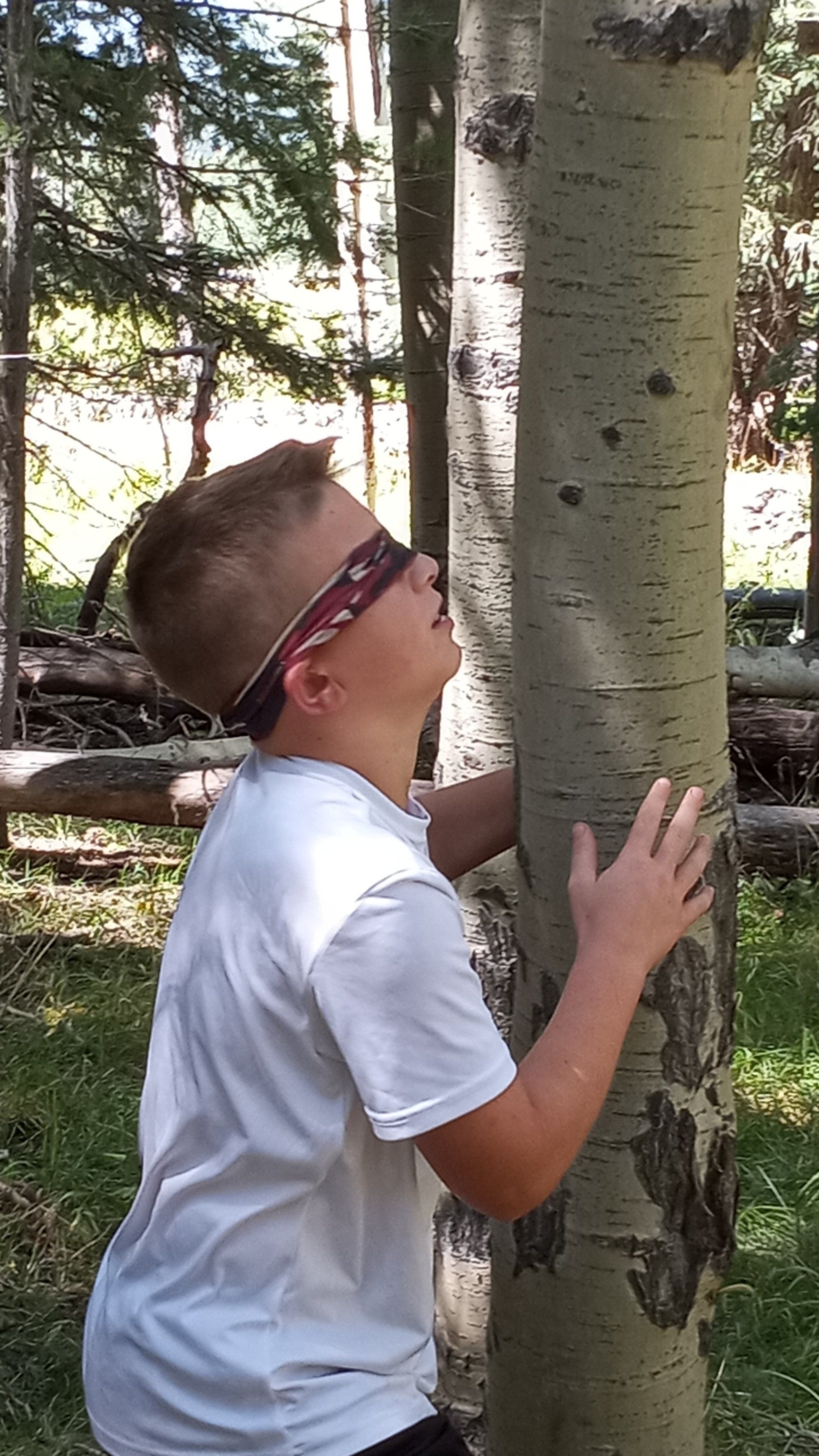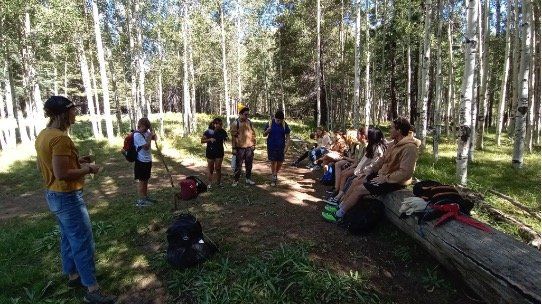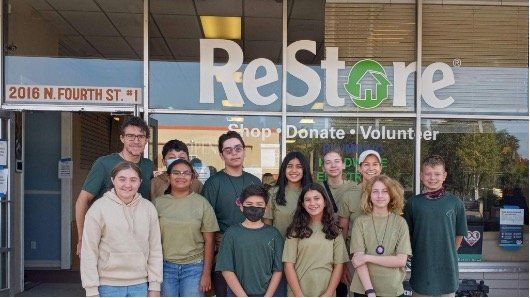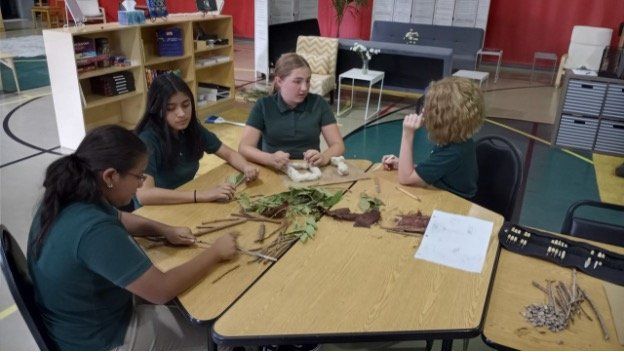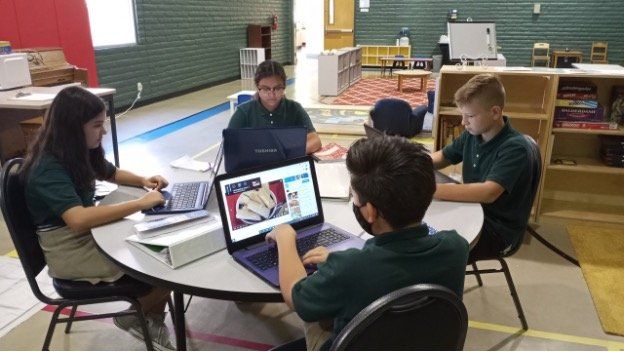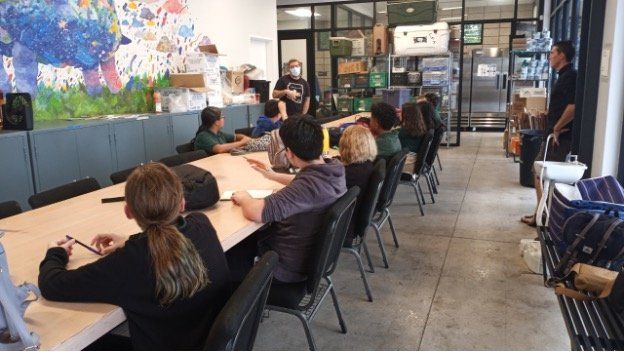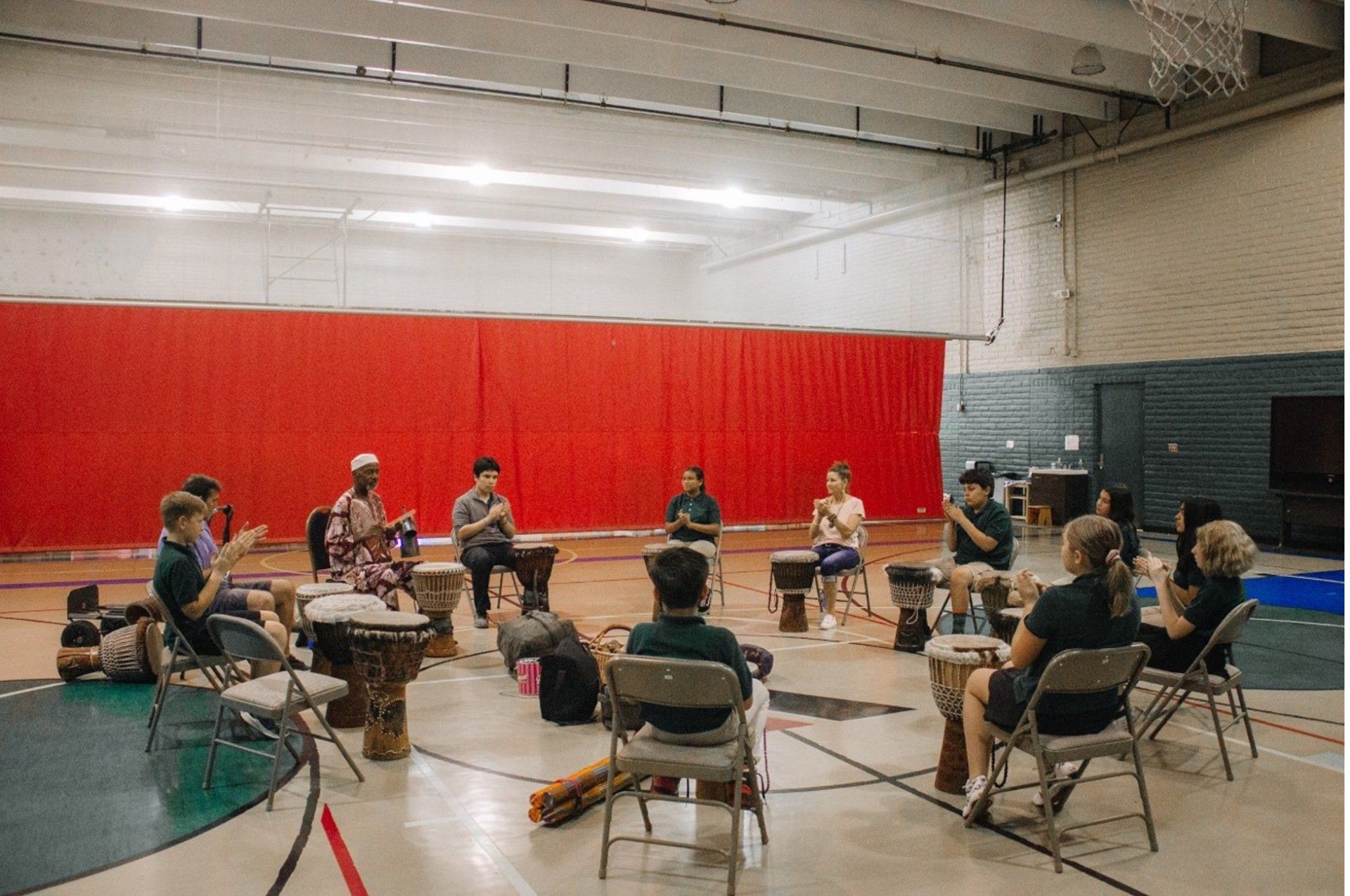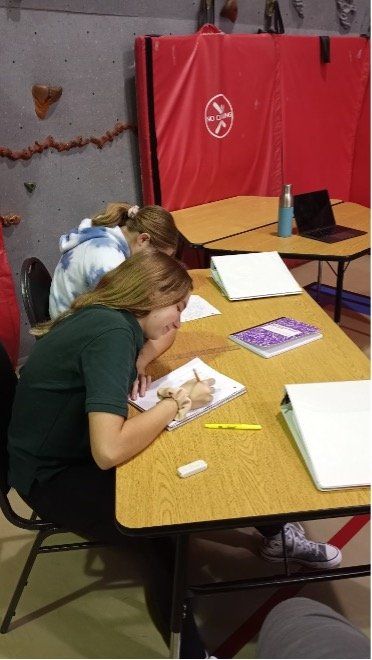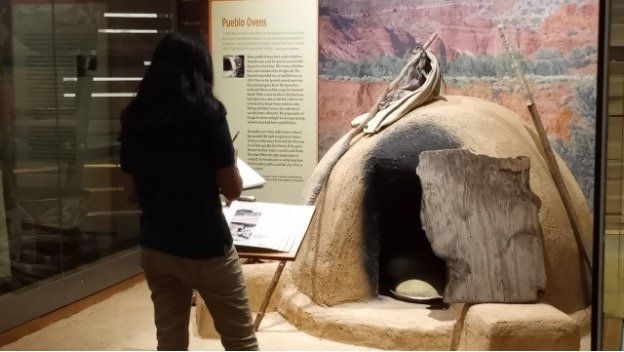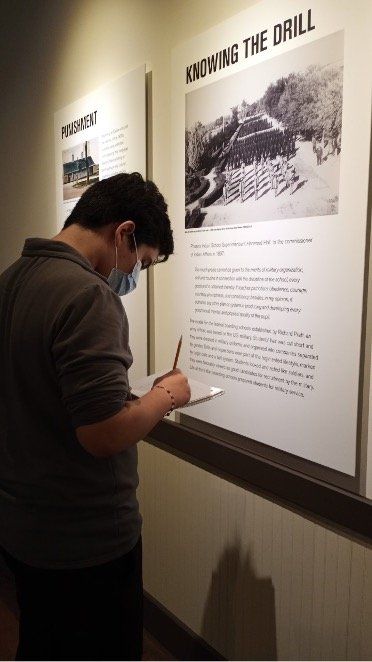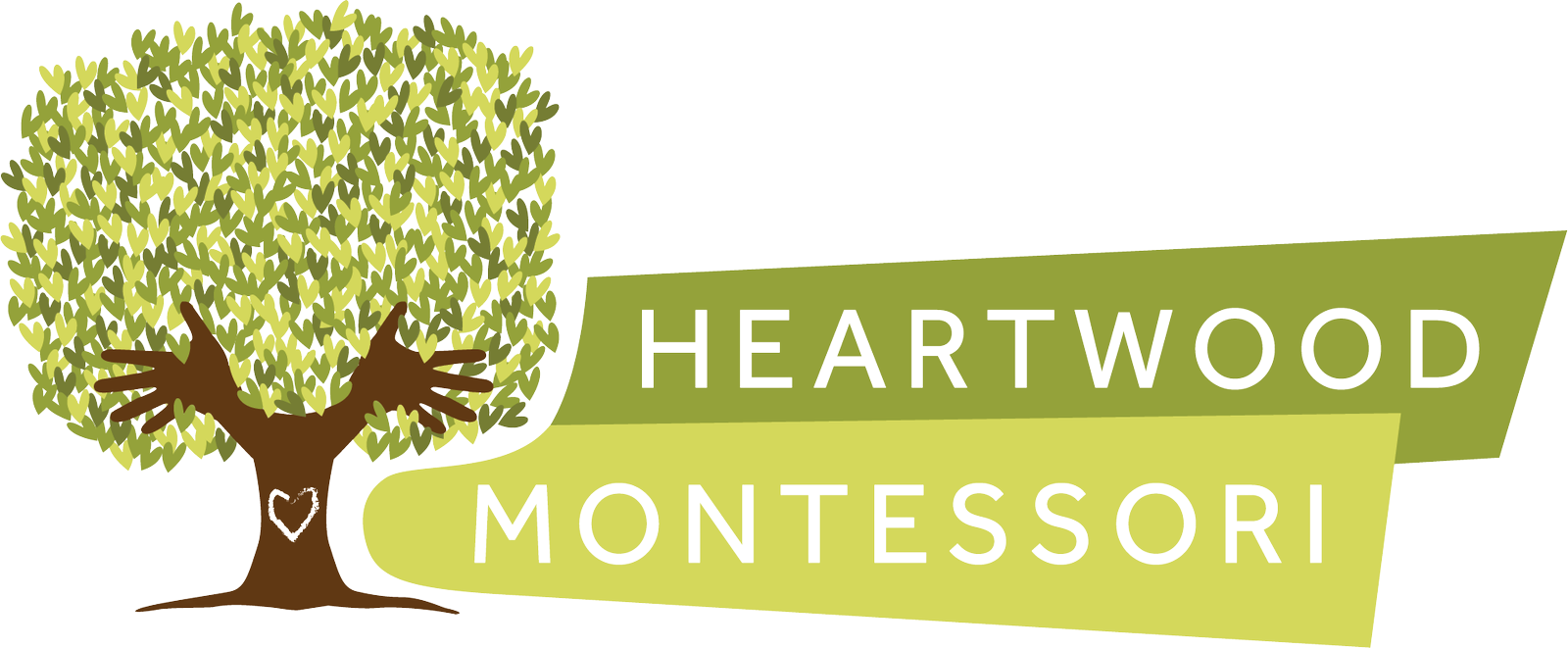SECONDARY ARTICLES
Published: April 2025
Side-by-Side Work
“But, above all it is the education of adolescents that is important, because adolescence is the time when the child enters the state of manhood and becomes a member of society.” “If puberty is on the physical side a transition from an infantile to an adult state, there is also, on the psychological side, a transition from the child who has to live in a family, to the man who has to live in society . These two needs of the adolescent: for protection during the time of the difficult physical transition, and for an understanding of the society which he is about to enter to play his part as a man.” -Maria Montessori
For the guides and the students, working side-by-side is of the utmost importance. The role of the guide is not to fill the “vessel” with knowledge, but rather to observe, facilitate, question, discover, and model. Students take on various duties and responsibilities to ensure our “society” within the environment mimics duties and responsibilities of the “real” world outside of the four walls. One example of side-by-side work is Production and Exchange work. The guides facilitate the process for applying for jobs. Students write resumés, apply for jobs (managers and assistants), and interview for positions. Once the various positions have been fulfilled, the work begins. Student managers meet weekly to determine what needs to be done with a guide facilitating the meeting and assisting them on how to conduct a productive meeting. They then meet with their assistants to complete the tasks by the given deadline. The adolescents are guided by adults to learn about responsibility and the outcomes of their actions in a suitable and organized setting. Additionally, through this process, they are building and refining their soft and hard skills for the future.
Families can build the same side-by-side work at home, giving adolescents duties and responsibilities within the framework of structure and organization. By allowing them to practice at home, they are better suited to make decisions and run their own homes when the time comes. Some ways to include your adolescent in side-by-side work are: meal planning, shopping, budgeting, and preparation; create a budget of spending and saving with them; determine deadlines or times for chores and responsibilities; ask for their opinions and elicit solutions to problems; and honor their growth, their process, and their need for independence within boundaries.
Resources:
Published: March 2025
The Third Plane of Development: Absorption vs. Crystallization
One of the most impactful discoveries from Maria Montessori was that humans develop in stages or, as she called the, planes of development. These planes happen from 0-6, 6-12, 12-18, and 18-24 years. Each plane has unique needs and characteristics and develops in unique ways. The third plane of development (ages 12-18) is a plane that Maria Montessori found has two distinct sub-planes of 12-15 and 15-18 years of age. These sub-planes exhibit notable differences in how human tendencies manifest. The 12-15 age range is characterized by a re-orientation to the physical body, community, and peers, with an emphasis on social belonging and identity formation. This stage is highly emotional, with repetition and mastery of skills being driven by feelings and a desire for meaningful work within a social group. Intellectual exploration remains significant, but it is deeply tied to social experiences and self-expression. Work in this phase involves initiating manual tasks with stories and engaging in adult-like responsibilities. In contrast, the 15-18 age range is marked by a more refined social orientation, where individuals start integrating into broader societal structures, understanding social hierarchies, and taking on economic and moral responsibilities. Intellectual development becomes more abstract, with a focus on philosophical and idealistic applications. Work transitions from self-discovery to contribution, with adolescents using manual labor as a foundation for intellectual studies that resemble adult work. Repetition in this phase is driven by logic and reasoning, emphasizing mastery through complexity rather than emotional intensity. Finally, communication evolves from being socially driven to engaging in intellectual discourse aimed at collaboration and problem-solving on a global scale. (see Barrameda below)
Another way to consider the differences between these sub-planes is that the first sub-plane is a period of absorption, while the second sub-plane is a period of crystallization. Students 12 to 15 years old are often absorbing all things social. They are coming to understand the ways of society, both large and small. Students ages 15 to 18 are consolidating their knowledge, practicing roles in society, and trying out the things they absorb during the first sub-plane of development.
Our environment is designed for these differences between our lower and upper secondary students. We offer numerous opportunities for absorbing social norms through a carefully designed community in lower secondary. This includes our production and exchange through small business and entrepreneurial endeavors, performing manager positions, supervising maintenance and restoration of our environment, conducting whole group council to discuss issues, challenges, and successes, and several other opportunities.
For our upper secondary group, we aim to provide a step into the broader community to practice the roles students have adopted through absorbing during the first sub-plane. These opportunities have included service projects designed and implemented by students, hosting guest speakers from a range of backgrounds, visiting places of importance for study in a range of subjects, hosting events for community members to attend, and much more.
Parents can support the needs of students ages 12-15 and 15-18 by trying to offer similar opportunities for absorbing and practicing social engagement. This could include the following:
Encouraging participation in structured and unstructured social settings, such as youth organizations, sports teams, volunteer groups, or student-led initiatives- Providing opportunities for independence within a supportive framework, such as allowing teens to plan outings with friends, manage their own schedules, or take on leadership roles in extracurricular activities
- Facilitating meaningful family and community interactions, such as hosting group study sessions, family discussions on current events, or multi-generational gatherings
- Modeling and discussing healthy social habits, including conflict resolution, active listening, and respectful dialogue
- Supporting self-directed social initiatives, such as allowing teens to start a club, organize an event, or lead a service project
Resources
Social and Emotional Skills Resources for Families: The Jed Foundation provides candid and practical advice to help parents foster emotional wellness and self-awareness in their teens.
Parent-Child Communication Toolkit: ACT for Youth offers resources to enhance communication between parents and adolescents, covering topics like positive parenting and sexual development.
Parents of Adolescents and Teens Program: PEPS (Program for Early Parent Support) offers programs designed to support, inform, and build community among parents and caregivers of adolescents and teens aged 10 to 19 years old.
Resources for Families: Youth.gov provides a series of tips for parents and caregivers to help them talk with teens about a range of topics, including alcohol, drugs, relationships, and online safety.
Take Action for Adolescents™: Resources for Each Goal: The Office of Population Affairs offers a selection of resources organized by eight goals to support adolescent development.
Keeping Teens Safe on Social Media: The American Psychological Association provides guidance on monitoring and discussing your child's social media use to promote healthy online behavior.
American Psychological Association
Center for Parent Information and Resources: This hub offers a wealth of information and resources to support families of children who have disabilities.
Resources for Families | U.S. Department of Education: The Department of Education provides resources and tools to empower parents in helping their children succeed in and out of the classroom.
Barrameda, Xavier P.A. “Human Tendencies Authentic Guideposts to Human Characteristics Across the Planes.”
AMI Journal, vol. 1, no. 2, 2020, pp. 106-120.
amijournal2020.pdf, https://montessori-ami.org/sites/default/files/downloads/AMIJournal2020.pdf.
Published: February 2025
Moral Education and Development
“Moral education is the source of that spiritual equilibrium on which everything else depends and which may be compared to the physical equilibrium or sense of balance without which it is impossible to stand upright or to move into any other position.” -Maria Montessori
Building a culture and community of care and compassion is the important work of the secondary community in helping the students find their voice, serve others, problem-solve, and to discover what is morally right. This is not academic work, but rather social work. Moral development requires students to advocate for themselves, to speak up, to voice thoughts and ideas and to respectfully approach others. Guides encourage students to speak directly and honestly.
At this stage, students are encouraged to voice their opinions through several different avenues. One way is during the Socratic Seminar. They read the assignment of a novel, article, or primary source, and gather in a circle to present thought-provoking questions and to discuss what they have read, while constantly referencing the text or other connections to life. The discussion groups are small and each individual is asked to contribute and engage in the conversation. When disagreements arise, students address one another with “grace and courtesy” in respectful discourse.
Another way is that students work collaboratively on projects and debates, where each member must contribute to the overall outcome. This requires teamwork and self-direction, understanding that the good of the group is paramount. Again, if disagreements occur, respectful discourse and compromise is encouraged.
At the secondary level, we meet weekly for Council meetings, which is a safe space for students to voice their issues or challenges; generally, these are problems that they observe or have experienced. It is up to the collective group to find a solution and to follow through with the solution. If the solution does not work, the challenge is discussed again at the next Council meeting. We also celebrate the successes that we have experienced and voice gratitude to others.
Lastly, the students complete community service, allowing them to understand and receive others who have different cultural backgrounds or are in need. This purpose serves as validation for the developing adolescent in cultivating care and compassion for others.
Resources:
https://parentandteen.com/building-character-in-teens-one-of-the-7-cs-of-resilience/
https://opa.hhs.gov/adolescent-health/adolescent-development-explained/moral-development
Published: January 2025
Creative Expression in the Third Plane of Development
“For this purpose there would be all kinds of artistic occupations open to free choice both as to the time and the nature of the work. Some must be for the individual and some would require the cooperation of a group.” - Dr. Maria Montessori
Adolescence is a time of great change for an individual. In addition to the physical and biological changes that a person undergoes during this time, they also experience a great shift in their forming of an identity and a personality. They decide on the key aspects of who they are through a challenging and ongoing process. This extends further into the fourth plane of development, but it is ignited beginning around the age of 12. During this period, students require great patience and careful guidance.
One key need for students in the third plane of development is an opportunity to express themselves. Students at this age are regularly trying new forms of artistic expression and seeing what fits. In addition, they greatly benefit from expressing their inner turmoils as they try to sort out who they will be heading into adulthood. As a result, a prepared environment must offer numerous opportunities to express themselves, but it must also aim to educate them in ways to express as well.
In the Heartwood Secondary Program, we regularly encourage students to fold creative expression into all areas of work and study. These opportunities have included work in ceramics, music, two-dimensional art, animation, film, photography, graphic design, and more. Most recently, students in the program engaged in a theater intensive over two and a half weeks. Students were able to contribute to the overall production through acting, sound, scenery, costume, and lighting design. All students engaged in acting, but they were also able to find their own unique ways of contributing in other ways.
Beyond expression using art forms, we also encourage creative expression through regular opportunity to choose in work and study. Students are often allowed to determine how they would like to demonstrate their learning through projects and other larger works. These final products have included videos, panel discussions, debates, graphic novels, songs, TED Talks, and more. Affording students a chance to be more creative in their demonstration of learning provides them even more opportunities to express themselves creatively.
We encourage parents to provide opportunities for creative expression beyond the classroom. These can range from signing up for an art class to learning a new art form at home. In addition, we encourage parents to engage in creative approaches to the problems students face at home. Working together with students to find new ways to solve these problems can model for them methods of creativity that they may be less familiar with.
Published: December 2024
The Work of Head and Hands
“... education must be very wide and very thorough, and not only in the case of the professional intellectuals, but for all men who are living at a time that is characterized by the progress of science and its technical applications. Now, even laborers need education. They must understand the complex problems of our times, otherwise they are just a pair of hands acting without seeing what relation their work has in the pattern of society. Such as they are today, they may be said to have no head. Meanwhile, the intellectuals of today are all cripples as long as their hands remain useless. Their spirit will dry up if the grandeur of the practical reality of our days is completely shut away from them, as if it did not exist.
Men with hands and no head, and men with head and no hands are equally out of place in the modern community.”
- Maria Montessori
In the third plane of development, we incorporate head and hands into units and lessons. The collaboration of the two helps to engage the students, so they feel the power of learning and knowledge by applying concepts.
We give opportunities for the students to apply the “hand and head” philosophy through meaningful work. The students are exposed to hand work through painting, sculpting, weaving, pottery and ceramics, crochet, constructing and building, cooking, and sewing to name a few. As students maneuver, they must use critical thinking and are building problem-solving skills, many times brainstorming ideas for finding solutions. While the students regularly use laptops to complete assignments, the idea of hand and head translates specifically to the classroom environment where students are still required to handwrite notes, Math problems, and essays.
The students get into “flow”, the uninterrupted flow and focus of real work when they use the hands and the head in conjunction. When students are engaged in their work, they experience flow, when time seems to fly and they are surprised to discover that hours have passed.
In the home environment, there are numerous ways to incorporate head and hands and to create flow. Some ideas are cooking together, cleaning, working on cars, gardening, playing games (indoors and outdoors), reducing multitasking and staying focused on the activity of the moment, and creating quiet spaces free of distractions to allow for flow and uninterrupted concentration.
Resource
Published: November 2024
Confidence in the Third Plane
"Adolescents must become self-confident, aware of their own powers and aptitudes, sure of themselves and their humanity," Dr. Maria Montessori.
In the third plane of development, we observe a great lack of confidence, particularly in the first three years (12-15). Adolescents will often second guess their abilities and this can impede their progress in developing their identity and their abilities. It is highly important in this stage of life that adolescents have countless opportunities to succeed in order to improve their confidence and give them a stronger sense of self.
Our environment features these opportunities through several means. In the lower secondary level, students apply for and carry out meaningful jobs within the secondary community. These include business and project management, garden management, community outreach, culinary management, and more. In addition, the upper secondary level features opportunities to develop and implement service projects. These project are highly complex, and students regularly face challenges that they must overcome in order to see the projects through. Students in the secondary program also see several opportunities to try, fail and try again. These happen throughout our curriculum academically, socially, and emotionally.
As adolescents are vulnerable to criticism due to their lack of confidence, it is extremely important for parents to encourage healthy habits with social media. Plenty of scientific evidence points to a negative impact on mental health due to excessive and unhealthy use of social media (see source below for some helpful advice). Parents would do well to monitor their children when it comes to how and how often they use social media. In addition, parents should provide numerous opportunities to their children to succeed in new and challenging activities. These activities could include learning a new skill in art, volunteering together, allowing the adolescent to assist in or independently plan an upcoming trip, tackling a physical challenge like a 5k race or learning to rock climb, working on problem solving like finishing a puzzle or putting together a piece of furniture, encouraging reflection like having a moment of gratitude at dinner, and many more. The point is to provide students new opportunities to be successful and to help support them while they experience such low confidence.
Resource
Published: October 2024
Solitude and Nature
“Life in the open air, in the sunshine, and a diet high in nutritional content coming from the produce of neighboring fields improve the physical health, while the calm surroundings, the silence, the wonders of nature satisfy the need of the adolescent mind for reflection and meditation.” Maria Montessori From Childhood to Adolescence, p. 67
In the secondary program, we know how important it is to give opportunities for silence and self-reflection in the ever-changing adolescent brain. Daily, their brains are bombarded with stimuli, never allowing it to calm. They participate in yoga, deep breathing, silent journaling, and walking in nature. This allows them time to self-reflect and to gain a sense of self. If a child is anxious, it is beneficial for them to write or draw to get to the root of their anxiety. If they are happy, writing positive and inspirational thoughts or quotes help them to return to when they need uplifting.
We offer self-reflection in daily practice and throughout the year. Daily, students are to reflect on their participation, engagement, time management, and preparedness. In addition, at the end of every area of study or unit, students reflect on their research, the challenges, and successes they had. Lastly, the opportunity for silence and self-reflection is incorporated into the trips that we take. To connect with nature, students may walk silently along a beach or a mountain trail to ponder who they are and their role in the world. During the Odyssey in Northern Arizona, the students walked Canyon de Chelly and considered the people who came before and the role the students themselves will play for future generations. Guides often discuss self-discoveries with the students to encourage them on their journey.
It is highly recommended that adolescents have quiet moments, free of all distractions, and getting into nature. At home, it can become routine where all family members are enjoying silence and self-reflection, or family walks without cell phones, television, music, and other interruptions.
Resources:
https://www.edutopia.org/article/value-silence-schools/
https://health.clevelandclinic.org/why-you-need-more-silence-in-your-life
https://holdsworthcenter.org/blog/benefits-of-silence/
https://www.apa.org/monitor/2020/04/nurtured-nature
Published: August, 2024
Movement at the Secondary Level
Movement is a key feature of the Montessori learning environment, and it is clearly a need amongst adolescents. An enormous amount of research has been conducted and suggests a clear relationship between higher levels of physical activity and improved mental health and functioning. Though much of this research was conducted with adults, research shows that the same results can be expected from youth.
In our program, we engage students in movement in a myriad of ways. This semester, secondary students are participating in basketball and yoga in our movement class. Students have shown great improvement in their physical skills, but they also have reported a better understanding of how their body works physically. We strive to improve their confidence and to give them tools to continue their physical activity outside the school environment.
In addition to our movement class, we also aim to get students up and moving around in our learning environments. This can involve activities where students move within a given classroom, but it also includes walking to other locations on campus. Furthermore, we regularly do learning and volunteer work in the community that requires a higher degree of movement from the students.
It is highly recommended that adolescents engage in at least 60 minutes of physical activity a day (see Elson resource below). While we cover a large portion of this requirement in all the activities students participate in, there is still more for students to do at home. We strongly recommend that you join your children in moving and getting the essential benefits of physical activity. It is also a great way to engage your child in more meaningful discussion as adolescents tend to open up while moving and engaging in physical activity. See the second resource below for some ideas for how you can move with your child.
Resources:
Published: April 2024
Production and Exchange
“Social life is not sitting in a room together or living in a city. It does not regard social relations. The essence is that something is produced which is useful to the whole of society and is exchanged for something else. Production and exchange are the essence of social existence. It is a production and exchange which does not only bring in the people living near to one, but those far distant. Division of labour enters into it too. Well, the youth should experience this in life. This is the secret of social life. The other is only casual. He must live it and feel it deeply. This, for me is the most important, I mean, the boy must produce and sell what he wants; sell it so that he may buy something else. Produce for people unknown to him. This represents a linking up.” - Dr. Maria Montessori, Lecture at the Montessori Congress in Oxford, England, 1936
Production and exchange are an essential part of the Montessori approach with adolescent students. Guides should strive to provide numerous opportunities for students to experience this inherent component of being part of society and contributing in their own way. Through these experiences, students come to better understand their role in society and how they might want to contribute. These experiences offer invaluable opportunities for learning through doing. Mistakes are encouraged, and we aim to provide a supportive environment where students are not expected to produce and exchange perfectly so that they may learn to do so before leaving our little community for the wider world.
Some of the ways that we try to give students these learning opportunities are through our small businesses and entrepreneurial ventures. This year, they have included a culinary project providing baked goods, staff lunch service, and more, a horticulture program aimed at sharing the joys of gardening with our community, and an arts and crafts group that has created jewelry, ceramics, placemats and napkins, soap, and many more handicrafts.
In addition, we have been lucky enough to see smaller groups of students start small businesses within our microeconomy. These include Tres Scoops and Apple Fry Guy. Starting a business involves a business proposal for funding, and then implementation of the plan through careful deliberation over how to produce goods and services, pricing, inventory, and customer service to name a few.
Our students have engaged in meeting the needs of the people in our community and they have been able to become a part of social life in their own ways. This has also included volunteering their time at Feed My Starving Children and Avista Senior Center. It is essential for our students to truly understand that production and exchange is not only a monetary endeavor, and that they offer to society much more than the tangible goods and services that they can produce.
Dr. Montessori so wisely pointed out that production and exchange is what ties us together. Over the past year, we have seen the fruits of students engaging in production and exchange. They have dipped their toes into the grand pool of society by offering their unique contributions. It has been remarkable to see, and we look forward to more of it in years to come.
Published: March 2024
Valorisation for Secondary Students
“The ‘valorisation’ of the individual is in close relationship with maximum effort. As a consequence, the child is always urged to a more difficult life. Instead, we have the instinct to give always an easier life. To make things easier means that a child is not satisfied, and his development will have many defects. He needs to feel capable of overcoming obstacles, of doing always more difficult things. The instinct of the adult tends to make it impossible for the child to achieve this development. The idea of helping and protecting is too much in our minds. I mean the direct protection that the child feels, not the protection that should take the form of organising the society necessary for his development,” - Dr. Maria Montessori, Moral and Social Education lecture, 1938
The concept of valorisation is essential in creating a program to help our lower and upper secondary students to develop themselves and to become adults who navigate their needs versus the needs of society. We strive to offer numerous opportunities for students’ personalities to be valorized, valued, embraced, and celebrated. These opportunities come in the form of work with the hands and head. Collaboration on projects, obtaining roles as managers or assistants for production and exchange, creating art through self-expression, and side-by-side work with guides are all examples of how we try to support our students’ valorisation.
Throughout this year, we have seen the results of such valorisation in each and every student in our program. We have seen our students becoming who they truly are in academic and social ways. They have had many opportunities to engage in our school community, and they have also had countless chances to engage in our society at large. These experiences have formed a foundation for how we support the valorisation that Dr. Montessori emphasized in her work.
Published: February 2024
Maria Montessori’s Plan of Work and Study
Dr. Maria Montessori strived to better understand the cycles of human development. Her speeches and publications were always centered on that important part of being a human in the world. Her aim was not to establish a working curriculum for educators to use wholesale for developing their students academic abilities. As a result, we must rely on Dr. Montessori’s descriptions of planes of development and our own observations of the adolescents we work with to inform our curricular choices. This process is iterative and requires a strong dedication to observing the needs and characteristics of students on a daily basis.
One way that curricular choices are aided is through a helpful breakdown of curriculum and aims for a Montessori adolescent program. This is commonly referred to as a plan of work and study. See the chart below for the plan of work and study for adolescents.
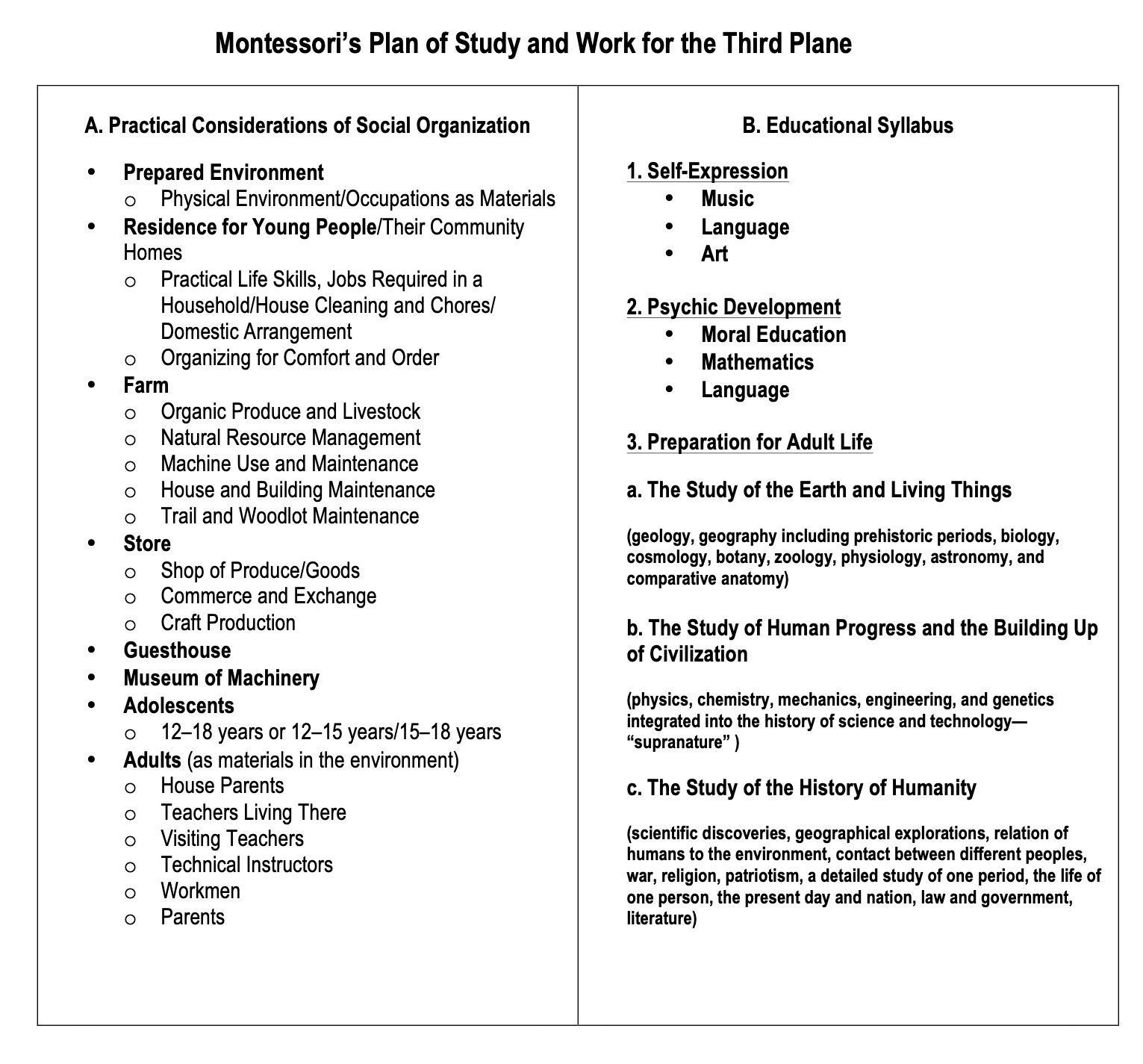
Published: January 2024
The Prepared Environment for Adolescent Programs of Study and Work
In response to the unique characteristics of adolescents (see previous articles below), it is the role of the adult as an adolescent practitioner to take great care in preparing an environment that responds appropriately and meets the needs of the adolescents they engage with. They must carefully observe to see the ways in which the characteristics of adolescents manifest themselves through each individual, and they must respond accordingly. In part, this involves providing a smaller version of society at large in which adolescents can develop and find their true selves.
Some important components of a prepared environment for adolescents include a high degree of social interaction rooted in collaboration for productive work with peers, numerous avenues and opportunities for expressing oneself creatively, an opportunity to work with the hands and the head, and a safe environment in which adolescents can develop their social and economical independence while finding ways to contribute to the human interdependencies we rely on within society.
In creating such an environment, practitioners must consider the community within which they function. This includes the climate, people involved, space afforded, and resources available for the adolescent program. It also means finding ways to extend the learning environment to the community at large in order for adolescents to experience on a regular basis the world that they will soon enter as independent adults.
Dr. Montessori’s plan for study and work refers to several components of the prepared environment that will help adolescents to develop in the third stage. Namely, she suggested that an environment be prepared with social organization in mind through opportunities to work on the land, to provide for the community through production and exchange, and to collaborate with others through work on a farm and/or in a hotel. Though providing a farm or hotel may not always be a possibility for an adolescent program, the opportunities that they provide are worth striving for in order to meet the needs and characteristics of adolescents in the program.
Published: December 2023
A School of Experience in the Elements of Social Life: Adolescence Part 4
The role of the adult in the 3rd plane is one who works side-by-side with the adolescent. “The teachers must have the greatest respect for the young personality, realizing that in the soul of the adolescent, great values are hidden, and that in the minds of these boys and girls there lies all our hope of future progress and the judgment of ourselves and our times'' (From Childhood to Adolescence, 69). In the Montessori Method, “the adolescent is an apprenticing adult”. Consequently, the adult’s life is being used as a model by the adolescent and the adult must be aware of their actions, behaviors, and words, because it is under constant scrutiny. In addition, the adult creates and maintains a method of scaffolding.
This is easily achieved by utilizing the 3-period lesson. In the first lesson, the child is introduced to the concept through a series of stories or sensorial activities; the guide gives just enough information to pique the interest of the child, to leave them with a sense of wonder. The second period, the most concentrated area where the “real” learning occurs, enables the student to research areas of interest, with the adult giving minimal guidance, but still acting as a facilitator when needed. Lastly, the third period, where the adult is virtually non-existent, is an accumulation of the knowledge gained, and presented as a dramatic performance or some other creative means to demonstrate the knowledge.
The adult creates an environment that is authentic. One in which tools are consistent with that of adulthood and they provide real life application; isolating difficulties when and where as needed. The student must be able to learn from their mistakes and to deal with the natural consequences of those mistakes; hence, the adult must generate an environment which allows the fostering of a relationship between the adolescent and their mistakes. It is not the role of the adult to penalize them for trial and error.
The 3rd plane of development, the one of adolescence, is tumultuous and chaotic. It is during this period when the child experiences rapid growth physically, mentally, and emotionally. Great care must be taken not to damage the fragile being, which is on the threshold of adulthood. This social newborn is trying to discover who they will be as an adult, but are plagued by self-doubt; subsequently, they need “valorization”, through opportunities in production and exchange and creativity. The child is able to construct meaning in the studies of occupations, the practical side, and humanities, the creative side. The adult must understand the developmental characteristics of this plane and their important role in this development, with a careful understanding of the significance of the prepared environment. It is in preparation of adulthood where the adolescent needs support in both social and economic independence to become an educated, confident, productive, and responsible citizen.
Published: November 2023
A School of Experience in the Elements of Social Life: Adolescence Part 3
Due to the unsettled physical and psychological nature of the young adult, Dr. Montessori called for a reformation in education, whereby the child would experience life in nature, working with animals and the earth, on a farm. Montessori coined the term erdkinder, or land-children, “because they are learning about civilization through its origins in agriculture” (From Childhood to Adolescence, 65). The farm, or the land, incorporates working with the head and the hand; there is no learning without intellectual work coupled with the work of the hands. “Men with hands and no head, and men with head and no hands are equally out of place in the modern community” (From Childhood to Adolescence, 58). Working on the land, introduces the child to nature, later referenced in the study of occupations, and the historic studies, or humanities, via the secondary program’s syllabus of “The Plan of Work and Study” and satiates the tendency to want to create and to build and leave their mark on society.
The plan is outlined to cover a practical component, that being the work of the hands in conjunction with the head. Lauire Ewert-Krocker explains “The Plan of Work and Study” and the importance of the prepared environment. The right “hands'' side, occupations, gives the adolescent “...free development of the individual personality…” and satisfies the “...need for genuine experiences of social organizations…” Additionally, the practical work emphasizes economic development in the form of production and exchange, while the left “head” side of the plan, humanities, offers cultural, intellectual, and purposeful work. The micro-economy of a shop or store, a farm, and/or a hotel lends validity to the concept of real-life application. The adolescent will gain experience in finding a “problem” and the means to solve the issue, based on “...the culture of the community…” or a need within the community, such as a leaking roof gutter. It is then that they will begin to brainstorm materials or ideas, then assess their current resources, plan a concise list, budget, shop or order materials, craft, assemble, assess the product, decide on costs for the product, if it to be sold, and ultimately, execute the plan. This illustrates how the child will implement the use of their hands with their head, while fulfilling the practical and cultural side of the plan. Moreover, as an individual takes part in the process and gives purposeful assistance to the group, they feel a sense of worth, thereby valorizing him/herself and following the developmental goals of economic independence, the ability to function in a group. This social structure and involvement in the micro-economy builds the necessary tools to prepare for their role in the community and solidifies their self-confidence as they approach and organize for adulthood.
“The opening up of ways of expression, which through exercises and external aids will help the difficult development of the personality” (From Childhood to Adolescence, 71). Of equal importance for the adolescent is the opportunity for self-expression, so they are able to better understand who they are as a human being and, again, valorizes their personality. The environment should be as such to allow for free choice and work in nature. The choices may be individual, and some may require the cooperation of a group; they may involve areas of linguistics, art, imagination, and/or music. An outside expert can be elicited for lessons and guidance when a practitioner lacks the necessary expertise.
Published: October, 2023
A School of Experience in the Elements of Social Life: Adolescence - Part 2
The 3rd plane child, or the adolescent, is a “social newborn” on the road to discovering what adulthood looks like and making connections to past societies and identifying how they fit into the entire scheme and timeline of humanity. They become aware that the role they play will and does have an impact on humanity. They gain an understanding of their personal responsibility for the good of the whole. This can be a daunting revelation for the adolescent; therefore, their need for valorization, the need to feel worthy, to be recognized, to be of support, to attain acknowledgement, and to feel appreciated cannot be emphasized enough. “It is the ‘valorization’ of the personality to become aware of one’s own value…” (Moral and Social Education, 86). It is important to handle the adolescent with the sense of fragility, yet with the utmost honor and respect.
Dr. Montessori stresses the essential principles and components of the prepared environment in response to the characteristics of the adolescent. The environment prepared by the adult must have certain rules, or limitations, on which each individual abides, and “the rules must be just those that are necessary and sufficient to maintain order and ensure progress” (From Childhood to Adolescence, 69). “When rules are consistently implemented, the child will develop self-discipline as an aspect of individual liberty and the chief factor in the success of life” (From Childhood to Adolescence, 71).
Published: September, 2023
A School of Experience in the Elements of Social Life: Adolescence
As a child passes through each stage of the four planes of development, they are self-constructing and unconsciously preparing for the next stage. From the 1st stage where the child learns by an absorbent mind, to the 2nd stage where they begin to explore their environment, transitioning to the 3rd plane of adolescence, ages 12-18. The concept of learning takes on a new element in the 3rd plane, because the youth now realizes that they have a role to play in the history of mankind and that the decisions they make will impact the community as a whole. This meta-cognition for the adolescent, this social rebirth requires a new prepared environment, which empowers the child to contribute as individuals for the good of humanity. The environment is prepared to allow choices that suit the human tendencies of this age; the needs of the child are met and permit them opportunities for self-expression that is so vital during this period of development. Consequently, Dr. Maria Montessori offers a “Plan of Work and Study” to use as a guide for the adult to facilitate adolescent learning and as a “blueprint” for the social organization of this stage. During this chaotic stage of development, the guide must understand the characteristics of the adolescent in order to create a useful and purposeful prepared environment and to distinguish their role as the adult, so as not to teach, but rather to facilitate the adolescent’s learning and experiences.
The 3rd plane of development begins around the age of 11 or 12 and will continue until approximately the age of 18. As the child enters into adolescence, they will begin to display characteristics similar, or parallel, to the 1st plane of development. “Psychologists interested in adolescent education think of it as a period of so much psychic transformation that it bears comparison to the first period from birth to six” (The Absorbent Mind, 17). In this period of time, the adolescent will experience swift changes in growth and development; not only in their physical formation from child to adult, but also in their psychological state, which is fragile, wrought with doubts and hesitations, and may manifest in rapid changes from happy one moment to explosion of anger in the next. As they enter puberty, one will notice that the adolescent will require more sleep, have less stamina, and experience illnesses more often than the previous plane of development. The quickness of the physical change, complete with awkward movement of limbs, creates a need for them to perform manual work to gain control of their bodies; the delicate nature of their psyche requires opportunities for creative work to allow for self-expression, while attempting to integrate these two important components of their adolescent being into an adult being.
May 2023 Update
“On the contrary, education must be very wide and very thorough, and not only in the case of the professional intellectuals, but for all men who are living at a time that is characterized by the progress of science and its technical applications.”
“The man of the ‘supra-natural’ powers can see, through lenses, things that are minutely small or remotely distant, and can calculate mathematically, through a ‘supra-natural’ or artificial development of his brain, the exact nature of events that are completely inaccessible and even unimaginable to primitive man.” -Maria Montessori
The Occupations’ study was Coding and Computer Science. They learned how to create a website, the workings of a browser, networks, and HTML language. Finally, they had to create their own example HTML page.
“...we ought to remember that there is one thing that education can take as a sure guide, and that is the personality of the children who are to be educated.”
“Education:syllabus and methods…3. The theoretical knowledge and practical experience that will make the individual a part of the civilization of the day…” -Maria Montessori
ASU Art Professor, Julie Codel, visited the students to give them insight to Renaissance art and artists. She provided them with background as to the artists’ inspirations and the wealthy patrons who commissioned them. They were able to view 3 different interpretations of the statue of David and the artists created them. This presentation complements their studies and to give insight as to what they will be seeing on their trip to Italy.
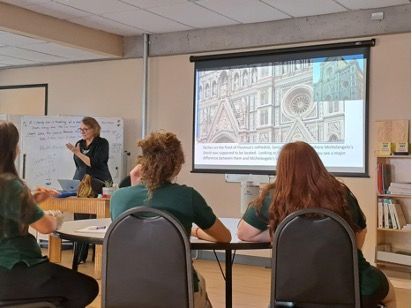
“The child is both a hope and a promise for mankind.”
“Preventing conflicts is the work of politics; establishing peace is the work of education.”
“If we are among the men of good will who yearn for peace, we must lay the foundation for peace ourselves, by working for the social world of the child.” -Maria Montessori
The students finished their Humanities’ study for the school year with a trip to Italy where they visited the Colosseum, St. Peter’s Basilica, the Sistine Chapel in Rome, and even Casa di Bambini, Maria Montessori’s first school. They rode the train to Florence and Pisa where they viewed all of the great works of art and architecture, attended an edited version of the opera Carmen, and were excited to learn how to make authentic Italian pizza and gelato in a Tuscan cooking class. They spent an inspiring afternoon in the park, watercoloring the beauty of Florence, learning sketching, perspective, and shadowing. For a respite, they swam in the Ligurian Sea. Stepping out of their comfort zone to experience the culture, food, and language other than their own, allows the adolescent to see the global impact they have on the world and to learn about themselves.
The junior high/high school students had a full 2022-2023 year. They traveled around the Valley, to California and Mt. Lemmon, and ultimately, to Italy. They debated various topics, planned events, met other Montessori students, designed and planted seasonal crops, learned the importance of composting and elimination of food waste, computer science, collaborative and independent work, planned and cooked meals, and through their micro-economy acquired a non-profit status for their businesses, and moved into the new classroom. Have a wonderful summer and stay safe!
Published: April 2023
April 2023 Update
“Self-help has shown…:
- that it has great moral value because it ‘rouses the conscience from the inertia’ in which it is generally found among young people who are being passively maintained by their families, and it teaches in a practical way the value of time and of their own powers…” Maria Montessori
The Wolf classroom worked all day to move from the previous environment of the gym, which has been called “home” for almost two years, to the new beautiful space. Everyone toiled and worked, packing, lifting, and moving materials, supplies, and furniture, and subsequently, organizing (as Dr. Montessori stated, “...of organizing for comfort and order…”) the new environment. Students debated and designed the best use of space and the placement of every item. It did not take long to feel comfortable and to continue learning.
“Food should be plentiful and nourishing… including raw vegetables and especially fruit… Homegrown vegetables and fruit that have been thoroughly ripened on the tree are treasures…” Maria Montessori
The students have been busy with Mr. Larry, Heartwood’s Horticulture and Farm Director, to begin the campus compost program and to get the garden pests under control. They gained an understanding of the purpose and mechanics of composting and they will be conducting workshops for the rest of the community. In addition, they learned about harmful and helpful bugs and how to combat the pests naturally and organically.
“We must say at once that the aim should be to widen education instead of restricting it. Our reform is one of the distribution of culture and methods of teaching.”
The students welcomed Sherry Koopot from the Phoenix Art Museum (https://phxart.org/)
in preparation for their upcoming trip to Italy. She presented a Critical Eye to art, explaining that every artist has a purpose or message, how the title gives clues to the work, the structure, color, texture, and geometry, and how it narrates a time and place, which aligned so well with the students’ study of poetry. They will now be able to view art with a critical eye.
The students performed short snippets of Shakespeare for the community under the direction of Deb Stevens from Childsplay and this complemented their Renaissance studies. They spent weeks learning Shakespearean English, iambic pentameter, and rehearsing.
Published: March 2023
March 2023 Update
“... above all it is the education of adolescents that is important, because adolescence is the time when the child enters on the state of manhood and becomes a member of society.”
“Such being the condition of society, we ought to remember that there is one thing that education can take as a sure guide, and that is the personality of the children who are to be educated.” Maria Montessori
The students have been working closely with members of the community to design and create a beautiful campus garden. This gives them the opportunity to practice communicating and working with adults outside of Heartwood. They are encouraged to share their thoughts and ideas, understanding that what they have to say holds value.
“The consciousness of knowing how to make oneself useful, how to help mankind in many ways, fills the soul with noble confidence, with almost religious dignity.” Maria Montessori
The Wolves spent the morning at Feed My Starving Children, helping to bag nutritional meals for those who are less fortunate. The charitable work within the global community is vital to the forming of the adolescent personality. They see they can make a difference.
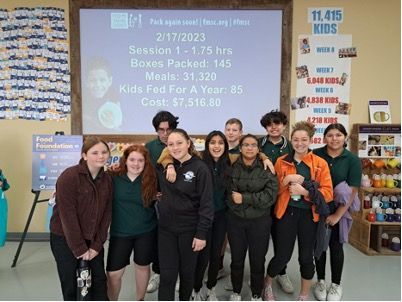
“Mathematics are necessary because intelligence today is no longer natural but mathematical, and without development and education in mathematics it is impossible to understand or take any part in the special forms of progress characteristic of our times.”
“But even in the natural state the human mind has a mathematical bent, tending to be exact, to take measurements and make comparisons, and to use its limited powers to discover the nature of the various ‘effects’ that nature presents to man while she conceals from him the world of causes.” Maria Montessori
The students have used Math in a variety of ways. They participate in weekly Math seminars in which they are given problems to work through, meeting to discuss their points of confusion and to share their way of solving the problem. Within the seminar, they use the necessary vocabulary and discover that there is more than one way to find an outcome.
The students decided to make the staff lunch for the micro-economy. They needed to determine the menu, the cost of the ingredients and other supplies, the proportions in the recipe, and how to efficiently deliver the lunches to the staff.
The study of water in Occupations gave them the opportunity to use Math. The project was to build a farm using water sustainable practices in the state of Arizona. They were required to draw blueprints to scale, identify sustainable water sources, determine seasonal produce, and how much water was needed for their crops.
Published: February 2023
February 2023 Update
“The shop would also necessitate a genuine study of commerce and exchange, of the art of ascertaining the demand and being ready to meet it, of the strict and rigid rules of bookkeeping.”
“We can therefore cite the success of this experiment in support of our assertion that productive work and a wage that gives economic independence, or rather constitutes a first real attempt to achieve economic independence, could be made with advantage, a general principle of social education for adolescents and young people.”
- Maria Montessori
Ms. Tina Beattie conducted a workshop on the various levels of corporations, the tax liabilities, how to become a corporation, and the steps necessary to move forward in the ability to accept debit payments for the small businesses. The students maneuvered around the U.S. Small Business Association, or SBA, and the Arizona State Corporate Commission, or ACC, websites to orient themselves and to see what resources are available. They selected a name for the corporation, which is named Heartwood Marketplace, and applied for their non-profit status.
Language: The development of language is part of the development of the personality, for words are the natural means of expressing thoughts and establishing understanding between men.”
“...a detailed study should be made of one period, event, or life of some personage who has aroused special interest. This would involve the consultation and comparison of documents, chronicles, and portraits until a real understanding of the subject has been achieved.”
-Maria Montessori
As part of the study of the Middle Ages, the adolescents analyzed and interpreted the language in the Magna Carta 1215. They worked in groups to decipher the language that was used as “old” English. This gave the adolescents the opportunity to read and speak text in which they are unfamiliar. While it was a challenge for them, it created talking points and debate. They shared with the other groups their interpretations of the historic document and recognized the social and moral values of the time.
“This conception of work implies a general principle that holds the work itself to be of greater importance than the kind of work. All work is noble; the only ignoble thing is to live without working. There is a need to realize the value of work in all its forms, whether manual or intellectual, to be called ‘mate,’ to have a sympathetic understanding of all forms of activity.”
“We have lost that ‘security’ which we had in the past; we need only think of the differences between the times when crafts were handed on peacefully from father to son, and the confusion of sudden, unexpected demands that causes the necessity for ‘vocational guidance’ and re-training.” - Maria Montessori
The adolescents spent the day at Iron Rhino Forge in Tempe, learning the art of forging and hammering and gaining knowledge of the history of blacksmithing, practicing as apprentices, with patience and hand/eye coordination. They were engrossed in their production of nails and hooks with guidance from David and J.C.
Published: January 2023
January 2022 Update
"The chief symptom of adolescence is a state of expectation, a tendency towards creative work and a need for the strengthening of self-confidence."
"The adolescent must never be treated as a child, for that is a stage of life that he has surpassed. It is better to treat an adolescent as if he had greater value than he actually shows than as if he had less and let him feel that his merits and self-respect are disregarded."
"...there would be all kinds of artistic occupations open to free choice both as to the time and the nature of the work. Some must be for the individual and some would require the cooperation of a group. They would involve artistic and linguistic ability and imagination,..."
-Maria Montessori
The students toured the newest ASU campus (The Media and Immersive eXperience (MIX) Center) in downtown Mesa. They were able to see the latest state-of-the-art technology available for film, media, gaming, and immersive experiences. The tour included sounds stages, theaters, fabrication workshop, 3-D printing studio, audio lab, sewing rooms for costumes, green rooms, and other labs and workshops that piqued the students’ interest and imagination.
"Education should therefore include the two forms of work, manual and intellectual, for the same person, and thus make it understood by practical experience that these two kinds complete each other and are equally essential to a civilized existence."
"Therefore work on the land is an introduction both to nature and to civilization and gives a limitless field for scientific and historic studies. If the produce can be used commercially this brings in the fundamental mechanism of society, that of production and exchange, on which economic life is based. This means that there is an opportunity to learn both academically and through actual experience what are the elements of social life. We have called these children the ‘Erdkinder’ because they are learning about civilization through its origin in agriculture. They are the ‘land-children.’ "
-Maria Montessori
The adolescents are working closely with Larry Burnett in the school garden. He is guiding them in their learning about garden soil and amendments, pests, water, composting with worms, the nutritional value of fresh produce, and care and maintenance of the garden beds. HIs expertise as a master gardener has proven to be invaluable.
Published: December 2022
December 2022 Update
“...the child may acquire a great interest in science and all its marvels, when given a near vision of the beginning of life, and its progress up to the present day…he will be able to study scientifically and precisely only if already equipped with an emotion and sentiment for those subjects.” Maria Montessori
The adolescents took the light rail to Tempe Town Lake to begin their Occupation study of our most vital natural resource, water. They located the headwaters of the Salt River, following it downstream to the lake. They reflected on the purpose and importance of water, contemplating how it has memory and collects the positive and negative vibrations of its surroundings. Water was collected from the lake and the beautiful fountain outside of the Tempe Arts Center and studied under the microscope. The proof was evident as the lake sample did not possess the incredibly stunning crystals of the fountain sample.
“Language: Diction, elocution. Acting of stories or poems. Practice in making speeches and in logically presenting ideas, debates, and discussions. Practice in public speaking so as to be audible and hold the attention of the audience. Open discussions where they can present their own ideas.” Maria Montessori
The adolescents conducted their first debate of the year. The topic presented was “Which had the greater influence on Western society, Greece or Rome?” Both sides presented compelling arguments and rebuttals, however, the judges determined that Greece had the greater influence. Debate allows the students to use the skills of rhetorical appeal (ethos, pathos, and logos) as established by Aristotle. Some of the skills that are practiced include analyzing sources for reliability, incorporating statistics, note taking, and critical thinking.
“For success in life depends in every case on self-confidence and the knowledge of one’s own capacity and many-sided powers of adaption. The consciousness of knowing how to make oneself useful, how to help mankind in many ways, fills the soul with noble confidence, with almost religious dignity. The feeling of independence must be bound to the power to be self-sufficient, not a vague form of liberty deducted from the help afforded by the gratuitous benevolence of others.” -Maria Montessori
Spending time out of the classroom environment and engaging in the community gives the adolescents the opportunity to interact with community members outside of the school. The adolescents enjoyed another day off campus. Students attended a free concert at the Mesa Arts Center, appreciating the music of longtime Valley resident and vocalist, Francine Reed, while eating their lunch and visiting with residents from Avista Senior Center who were also attending the concert. They engaged in a little bit of play before settling into a Socratic seminar to discuss the final books of Homer’s The Odyssey.
Published: November 2022
November 2022 Update
The adolescents have been busy this past month.
The study of Humanities’ focus is Classical Rome, Greece, and Persia. Background and history was presented to the students when we visited the Arizona Persian Cultural Center. The presenters introduced some of the instruments that are influential in their culture. Additionally, they learned the history of Persia and its subsequent transition to Iran. They were treated to Iranian tea and snacks. Ms. Ayla and her husband, Ali, came to the classroom to teach us Persian dance, Persian snapping (it’s an art), and Persian embroidery techniques. For Seminar, we are reading Homer’s The Odyssey, in which they are learning about the hero's journey, archetypes, and ultimately, we are planning to give a performance on a portion of the book. The students are currently working on their selected research, incorporating a research report, Science project, language, and creative expression into their projects.
Independence, in the case of the adolescents, has to be acquired on a different plane, for theirs is the economic independence in the field of society. Here, too, the principle of "Help me to do it alone!" ought to be applied. -Maria Montessori
The Heartwood Fall Festival proved to be successful for the micro-economy businesses. It was a valuable opportunity for the students to meet members of the community and to discover weaknesses in the business models. We appreciate everyone who supported the adolescents in their endeavors.
There must be provision for the child to have contact with nature; to understand and appreciate the order, the harmony and the beauty in nature.. That the child may better understand and participate in the marvelous things which civilization creates. -Maria Montessori
The Wolves took a trip to the top of Mt. Lemmon to work with instructors from the University of Arizona’s Sky School team. They began at the Molino Basin campground, making observations, creating a base question for inquiry, collecting data, and making notes. As we worked up the mountain, we stopped at Meadow Loop trail to again observe and collect data. The last stop before reaching the Sky School was Windy Point where they took in incredible views and to observe and collect more data. They were instructed to follow the scientific method, and even though time permitted them from conducting numerous experiments, they were able to make some conclusions based on the information and time they had.
Dr. Alan Strauss provided an informative presentation on the universe before we were all treated to an evening looking through one of the nine telescopes. The planets that were available for viewing were: Jupiter, Saturn, Neptune, Uranus, and finally, the Moon.
The adolescent must never be treated as a child, for that is a stage of life that he has surpassed. It is better to treat an adolescent as if he had greater value than he actually shows than as if he had less and let him feel that his merits and self-respect are disregarded. -Maria Montessori
Erin gave a workshop on advanced bee anatomy, complete with drawings and labeling of the parts. The students were then assigned to make a bee out of clay and write a brief summary of what they learned. To follow up, Mr. Cahit Ozturk from ASU Bee Lab brought bees into the classroom to teach the students about bees. He spent time explaining the hive, the queen, and the workers, how to extract the honey, and the materials and equipment needed to work with the bees.
Clearly, we have a social duty towards this future man, this man who exists as a silhouette around the child, a duty towards this man of tomorrow. Perhaps a great future leader or a great genius is with us and his power will come from the power of the child he is today. This is the vision which we must have. -Maria Montessori
The students visited the Aster Senior Center to engage with the older community. They were fascinated by their stories and the seniors appreciated the youths energy and positivity. Connections were made and the seniors did not want us to leave. It was a great experience for all.
The child gives us a beautiful lesson – that in order to form and maintain our intelligence, we must use our hands. -Maria Montessori
We are hoping to have the composter up and running soon. Haydin and Noa with the help of Mr. Frank worked diligently to put it together, however, they soon discovered it was an extensive assembly. Thank you to them for their determination.
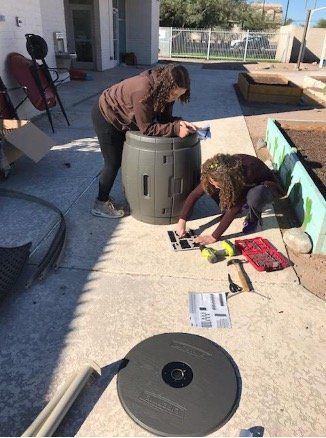
Published: October 2022
October 2022 Update
“Life in the open air, in the sunshine, and a diet high in nutritional content coming from the produce of neighboring fields improve physical health, while the calm surroundings, the silence, the wonders of nature satisfy the need of the adolescent mind for reflection and meditation.” -Maria Montessori
The adolescents ventured to the mountains in California for their week-long Odyssey guided by Nature’s Classroom Institute, sharing this experience with the adolescents from Keystone Montessori. The students from both Montessori campuses were active everyday in the natural environment, experiencing building with limited resources, creating art using items found in nature, studying the river, hiking, finding moments for meditation and reflection, along with many other experiential learning opportunities. The Odyssey experience gives time for the students to get to know one another outside of the classroom environment and to build community.
“The organization must be determined because it is necessary to develop the power of self-adjustment to the environment as it is found, and this adaptation results in cooperation and a happy social life that will facilitate individual progress. The environment must make the free choice of occupation easy, and therefore eliminate the waste of time and energy following vague and uncertain preferences. From all this the result will be not only self-discipline but a proof that self-discipline is an aspect of individual liberty and the chief factor of success in life.”
-Maria Montessori
First quarter ended with each small business creating a business plan, a prototype of their product, and presenting their plan and prototype to the Shark Tank. Some students designed a new business from their previous one and welcomed new members or partnerships. Shark Tank was able to provide valuable feedback for product improvement. The students are excited to open the store in the next few weeks.
Heartwood community parent, Breona Conrad, is joining the Wolves’ classroom this quarter to present Homer’s The Odyssey as part of the Study of the Classical Period in Humanities. The students experienced what the social class system was like based on other people’s reactions to them and body language. This is important for them to understand that people were born into a class and were not able to move between classes.
September 2022 Update
“The study of the history of mankind. This should be treated as far as possible as a complete whole, from which special periods can be chosen for individual study.”
To complement their Humanities’ study of ancient civilizations, the adolescents have been participating in Culinary Lab once a week to learn culinary skills, food chemistry, nutrition, and balance and proportion using recipes from the Indus Valley, Mesopotamia, and Egypt.
Additionally, they are reading historical fiction novels from those selected civilizations in which to seminar. These novels help to pique the students’ interest and allow them to question the culture and customs of the time and to give them ideas for their research projects.
Everyone has been engaged in their creative expression projects, crafting armor and shields, models of the pyramids, making children’s books, and researching their topic to gain a historical perspective and to assist them in writing their historical fiction narratives based on their area of study.
“The study of human progress and the building of civilizations in connection with physics and chemistry… The instruction given must be scientifically correct and must be related to simple everyday facts…” -Maria Montessori
The adolescents were engaged in the scientific study of waves, beginning with sound waves, witnessing the movement of the waves through mediums of WiFi, sound, and water. Through the mediums, they were able to identify the frequency and wavelength. This will segue into the study of electromagnetic waves, such as visible light.
August 2022 Update
It is necessary that the human personality should be prepared for the unforeseen, not only for the conditions that can be anticipated by prudence and foresight. Nor should it be strictly conditioned by one rigid specialization, but should develop at the same time the power of adapting itself quickly and easily. -Maria Montessori
The adolescents have begun their real work. They are working collaboratively in Math and the Humanities, creating and updating their resumes, and working in the garden. It has been a time of getting acquainted and building new friendships. The adolescent teeters on childhood and adulthood and this real work allows them to explore what it means to become an adult, to share responsibilities as individuals and in teams, while still giving them space to develop their personalities and who they will become.
May 2022 Update
“Establishing lasting peace is the work of education; all politics can do is keep us out of war.”
― Maria Montessori
“Of all things love is the most potent.”
― Maria Montessori
“We shall walk together on this path of life, for all things are part of the universe and are connected with each other to form one whole unity.”
― Maria Montessori
The final Humanities’ study was Peace Education. The students began the study with self-reflections, identifying their implicit and explicit biases, discussions about stereotyping people, and examining the Pyramid of Hate. The students visited the Japanese Friendship Garden and volunteered their time at the United Food Bank (https://www.unitedfoodbank.org/volunteer/) to complement their studies. In addition, the students chose to donate the taxes that were collected from their Production and Exchange small businesses to St. Jude’s Hospital.
They had their choice of novels to read: “Night” by Elie Wiesel, “Wonder” by R.J. Palacio, “The Diary of a Young Girl: Anne Frank” written by Anne Frank, and “The Map of Salt and Stars” by Zeyn Joukhadar, which highlights various perspectives and calls for peace. Each week the students led small group Socratic seminar discussions based on the novel they were reading and presented interpretive questions to guide the discussions. They practiced annotating as guidance during their reading. This skill builds critical thinking and allows them to see various perspectives. The students selected their area of peace research and the final project was shared with the community.
“Imagination does not become great until human beings, given the courage and the strength, use it to create.”
-Maria Montessori
“Whoever touches the life of a child, touches the most sensitive part of a whole which has roots in the most distant past and climbs toward the infinite future.”
-Maria Montessori
Deb Stevens from Childsplay in Tempe (https://www.childsplayaz.org/) guided the students through the process of theater, brainstorming, devising, character development, and voice projection and enunciation, working everyday with them for two weeks. Through the creative expression medium of theater, the adolescent is able to express themselves and to find their voice. The students who were familiar with theater productions mentored the others and assisted Ms. Deb. The students' culminating work, a modern take on the Mexican story of La Llorona, was performed for the Heartwood community
“Language: Diction, elocution. Acting of stories or poems. Practice in making speeches and in logically presenting ideas, debates, and discussions. Practice in public speaking so as to be audible and hold the attention of the audience. Open discussions where they can present their own ideas.” -Maria Montessori
The adolescents conducted their last debate of the year, which begged the question: Social Media: A Tool for Peace or Conflict? They researched reliable sources and presented their arguments in the classic debate style. The ability to argue for a position in which they do not personally agree has been challenging, but it allows them to take a different perspective and to understand that there are always two sides to be considered.
April 2022 Update
“The essential reform is this: to put the adolescent on the road to achieving economic independence. We might call it a ‘school of experience in the
elements of social life’ ”. - Maria Montessori
The adolescents had their Production and Exchange Business Grand Opening on Friday, March 25th and Saturday, March 26th in conjunction with a garage sale. Some worked diligently cleaning the items to be sold and organizing the garage, while others worked to decide on the pricing and labeling of the goods. They learned about customer service, determining tax, counting back change, cost analysis and adjusting their prices, and replenishing inventory. All of the vendors were able to pay back their loans and add profits to their spreadsheets. Thanks to the support of the community, the students were able to enter over $500 into the classroom ledger by the accountants. To replenish inventory, each business must present an itemized list of materials and meet with the accountants to approve their purchases.
“These and other similar ideas that will awaken a realization of the power of man and the greatness of civilization should be presented in a form that will stir genuine emotion, for feelings of this kind should exist today together with the feelings of religion and patriotism.” -Maria Montessori
For their study of Society in Transition: The United States, the students selected their research topic and conducted research, which included brainstorming, asking questions, and finding reliable primary and secondary sources. As part of their required research, they needed to use at least one print source, so a trip to the library was in order. Once their research was completed, they presented their findings. The topics ranged from iconic Coca-Cola to the opioid crisis in America.
“For success in life depends in every case on self-confidence and the knowledge of one’s own capacity and many-sided powers of adaption. The consciousness of knowing how to make oneself useful, how to help mankind in many ways, fills the soul with noble confidence, with almost religious dignity.” - Maria Montessori
The adolescents traveled to Spaces of Opportunity to volunteer their time to help Project Roots fulfill their CSA produce orders. They hauled the harvested produce to tables from the refrigeration and created an assembly line to fill 50 bags with the vegetables. Ms. Jessica from Project Roots was extremely thankful for the adolescents’ help and was impressed with the speed and proficiency in which they filled the bags.
“The child should love everything he learns, for his mental and emotional growths are linked. Whatever is presented to him must be made beautiful and clear, striking his imagination.” - Maria Montessori
Creative expression helps the adolescent to discover their interest and to find a way to express themselves. The students have various avenues for discovery: microscope art, nature art, drawing, wire art, and building a go-cart.
Published: March, 2022
The Shop
“The shop would also necessitate a genuine study of commerce and exchange, of the art of ascertaining the demand and being ready to meet it, of the strict and rigid rules of bookkeeping.” - Maria Montessori
The adolescents conducted a “soft opening” for their Production and Exchange. They ordered their materials and supplies, created ledgers to keep track of expenses, used Math skills to determine accurate taxes, inventory, budget constraints, and how much product they would need to pay back their “loan”, worked on the designs for their products, advertised and merchandised, and welcomed the Heartwood and SIMS staff and students to their opening. They were able to get some feedback on their products and as the week continued, they began to beautify their tables to attract more business.
The business managers ventured into the Mesa community to identify and recognize how vendors merchandise their goods in preparation for their grand opening. Small business owners, Tiffany from Inspire Farms and Jon from Harvest Market and Proofbread, spent time with the students, lending their expertise and encouragement to the student business owners.
Society in Transition
“The study of human progress and the building up of civilization in connection with physics and chemistry, mechanics, engineering, genetics… simple everyday facts so that it can always be tested and confirmed by observation or experiment.” -Maria Montessori
The adolescents spent the day at Taliesin West, discovering the art and architecture of Frank Lloyd Wright, the American architect who designed over 1000 buildings across the nation. This study of architecture was part of the “Society in Transition: The United States” study. During their visit, they not only learned what inspired Mr. Wright, but they also learned that engineering is a vital component to the architect's design. With that, they were divided into two groups to design and build a bridge, which would need to be solid and to withhold up to one pound. The groups succeeded in their bridges not collapsing, although the integrity of the structures were compromised, which served as a learning point.
Spaces of Opportunity
“The observation of nature has not only a side that is philosophical and scientific, it has also a side of social experiences that leads on to the observations of civilization and the life of men.”
“Just as nature is brought by the labour of man to a higher degree of beauty and usefulness, so man must raise himself to a state that is higher than his natural state…” - Maria Montessori
Project Roots welcomed the Wolves to the Spaces of Opportunity where Ms. Amy led them on a guided tour. The students were introduced to moringa trees and sampled the nutritious leaves and unripe, bitter seeds. She gave them a lesson on the carbon/nitrogen cycle and process of composting. The students met individuals from different perspectives and backgrounds who shared their stories and encouraged the students to be the best versions of themselves.
Published: November, 2021
Experiential Learning for the Adolescents
“... a special study should be made of ‘The present day and the nation,’ including the Constitution, the laws, their special merits and moral characteristics. This study should be plentifully illustrated by references to current literature and visits to places that have historical importance.”
The students began their Study of Place by walking and bicycling through and around downtown Mesa. They learned about the history of people who founded the city, buildings, spaces, and the innovations and technology of Main St. As their work continued, they contacted and scheduled appointments and met with and interviewed various members of the community, which included government officials, arts and culture directors, religious leaders, and experts in the environment.
The students interviewed Vice Mayor Jenn Duff and Council-member Julie Spilsbury to learn about how the city government works and the importance of being an involved citizen. Each student sat in the council chambers to live the experience of council meetings.
“So that just as the children in our elementary schools have already learned to fold their clothes, and to sew, etc., so here they must learn ‘to put things right’ when necessary, to adjust a machine or the engine of a car, to mend a broken window or the catch of a door. They should also be able to make a path, build a shed, chop firewood, and so on.”
The students began sewing their aprons for the community kitchen with Ms. Pam Truesdell. They practiced sewing a ¾” hems and pinning the pattern.
“We called these children the ‘Erdkinder’ because they are learning about civilization through its origin in agriculture. They are the ‘land-children’. They are learning of the beginning of civilization that occurred when the tribes settled on the land and began a life of peace and progress while the nomads remained barbarians and warriors. An immense ideal: that of civilization that unfolds in the environment of nature ought to uplift the kind of life to be led by these ‘novices of society’ “.
Ms. Brandi Hansen visited the adolescents to explain homesteading. The students learned about the challenges of homesteading, the care and processing of farm animals, farming, soapmaking, and canning and preservation of food. She also brought in 3 kunekune piglets for the students to meet, which enhanced her conversation about animal husbandry.
Published: October, 2021
Class Update
The adolescents continued their study of the soil occupations in preparation of starting the school garden. They took soil samples from the space that will be transformed into the school garden, and analyzed the levels of nitrogen, phosphorus, and potassium and determined the pH of the soil. In addition, they toured Greenhouse Gardens in Chandler, where Cameron McChesney discussed the importance of soil being the foundation for healthy farming. Jessica and Dionne with Project Roots will work closely with the adolescents over the next year, guiding them to create a productive farm for the Heartwood community.
The students were able to obtain donated bikes from https://www.bobsfreebikes.org/ for each adolescent student and guides. After purchasing locks and helmets, a neighborhood ride to acquaint ourselves with the new rides was in order. The bikes will be used to participate in community studies and events.
The students are working with the Pig and the Peanut at the Local First Community Kitchen. On their first visit, Caila and Patrick taught the students about the fine art of pizza making. The students learned the chemistry behind yeast and created pizzas not only for themselves, but also 15 additional pizzas to share with the residents in the surrounding community.
The adolescents experienced their first Odyssey. We headed north to Flagstaff for four days of camping and experiential learning. On the way to Flagstaff, we made stops at Montezuma’s Castle and Walnut Canyon to see first-hand the ruins of the early indigenous people of Arizona, the Anasazi. We enjoyed lunch along Oak Creek before reaching our campground destination. The students were responsible for meal planning, shopping, and preparing the daily meals, and cleaning. They volunteered at the Habitat for Humanity Restore, climbed the lava flows, stargazed to learn the difference between the Navajo constellations and European ones, conducted by expert Brian Bates, and learned how to identify trees, the geology of the area, and how the indigenous people used the land along the Arizona Trail with Julie Polovitch from Seeds of Stewardship.
Published: September, 2021
Active Learning for the Adolescent
The adolescents have been a busy group in this first quarter. The academic year began with a community walk in which we visited the Local First Community Kitchen. The kitchen provides a space for residents of the community to learn about food and nutrition and local vendors to prepare their food items for the farmers’ market. Afterwards, we strolled down Main St to the Mesa Arts Center. Here the students took their time to wander the area and to take note of things that they had never noticed before. It was an eye opening experience with them realizing how fortunate we are to have Main St so close to our school.
The Wolves used the light rail and walking to visit three different museums to complement their Humanities’ study of Indigenous and Native American People. Students volunteered to determine the light rail schedule and stops, make inquiries as to prices of the museum visits, and protocols for COVID within the museums. They were also responsible for collecting the entrance fees and paying the fees once at the museum. Additionally, the students conducted research and practiced note taking while at the sites and reported their findings to the others while we were still at the location. The students created native structures based on their research and discoveries at the Pueblo Grande Museum and began their research on their selected topic.
We have had opportunities and several visitors to our adolescent community to enhance creative expression. We learned about African drumming and dancing from Keith Johnson and the basics of weaving from Gail Kretz. The Wolves created their own interpretation of the Four Elements, using a circle. The learning continues this week as we explore Soil through our Occupations study and we take our first Odyssey.
